& LARGE SCALE FARMER
FEATURE
What’s new in fertiliser technology and spreaders

PROFILE
George Stevenson –Embracing lower emission rice



EQUIPMENT
Henty visitors glimpse special edition Steiger tractor

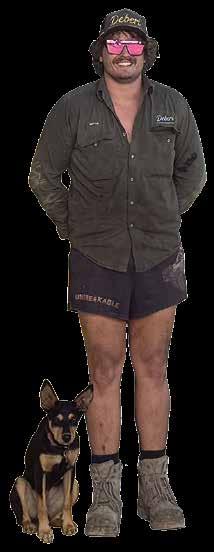
FEATURE What’s new in grain harvesting equipment

FEATURE
What’s new in fertiliser technology and spreaders

PROFILE
George Stevenson –Embracing lower emission rice



EQUIPMENT
Henty visitors glimpse special edition Steiger tractor


FEATURE What’s new in grain harvesting equipment
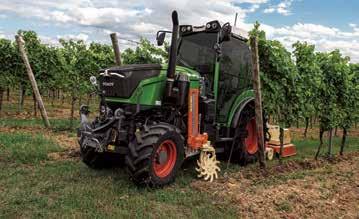


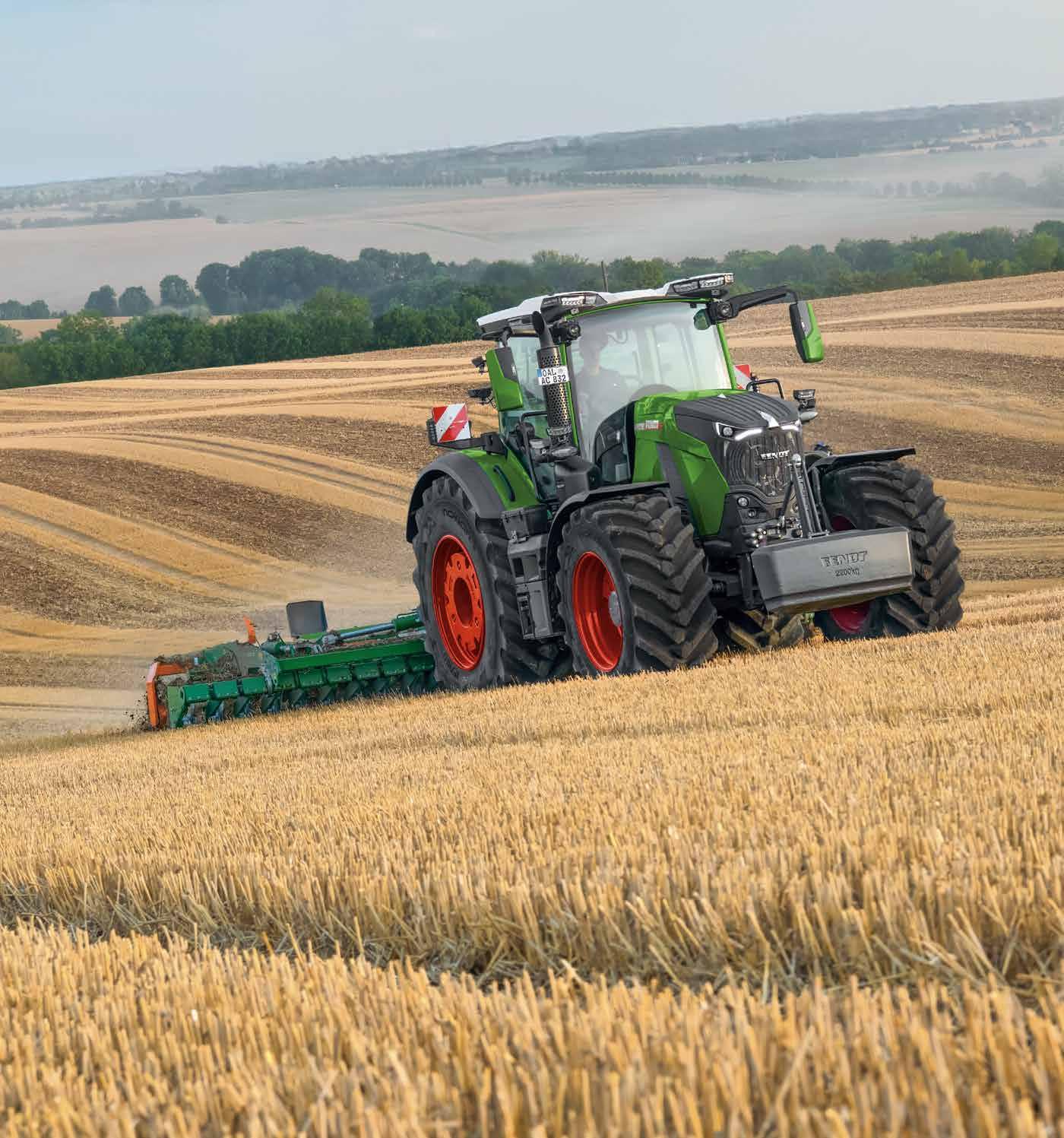
PO Box 36753
Merivale, Christchurch 8146
ph: +64 3 329 6555
www.agrimedia.co.nz
Publishers of Rural Contractor & Large Scale Farmer, AgriBusiness, AgriVet, NZ Cropping, Australian AG Contractor & Large Scale Farmer, NZ Novachem Manual.
EDITOR
Scott Wilson
Mob: +64 21 725 061
Email: scott@agrimedia.co.nz
ADVERTISING SALES
Pulse – Media Sales
Justin Bowler
Ph: 0429 699 553
Email: justin.bowler@mmg.com.au
CIRCULATION
DDI: +64 3 329 6555
Email: admin@agrimedia.co.nz
PRODUCTION, LAYOUT & DESIGN
Mark Winstanley
Email: art@agrimedia.co.nz
Contributors: Delwyn Dickey
Printed by PrintGraphics Pty Ltd
AC © AUSTRALIAN AG CONTRACTOR AND LARGE
SCALE FARMER - No part of this publication may be reproduced in any form without the prior written permission of the publisher. Opinions expressed in this publication are not necessarily that of the publisher and suggest independent advice be sought before acting on information or suggestions contained herein.
CONTRIBUTIONS - Editorial and photographic contributions are welcomed and should be sent directly to AML. Editing of submissions is at the sole discretion of the editor and will accept no responsibility for unsolicited material.
02 FROM THE EDITOR: The modern farmer’s balancing act INDUSTRY NEWS
03 Light green turns local heads
04 Australia’s top technicians recognised at 2025 John Deere Technician of the Year Awards
06 Ten harvests in, and still terminating the problem at its source
07 New Holland celebrates a half-century of Twin Rotor combines TECHNOLOGY
10 JDLink Boost enhances Machine Connectivity on Australian Farms
11 Maximising the advantages of technology: Data and Autonomy PROFILES
12 George Stevenson - Embracing lower emission rice
16 Across the ditch: Quietly getting it done in the South Waikato FEATURES
22 What’s new in fertiliser technology and spreaders
32 What’s new in grain harvesting equipment EQUIPMENT
46 Flexibility, precision and performance in one machine
47 New features for Flexcare V row crop cultivators
48 Bergmann: new steered pick-up ActiveLoad 2: more power, greater stability and optimised material flow
49 Case IH debuts Optum tractors with 3-metre centre option at Henty Machinery Field Days
50 John Deere’s most powerful tractors exceed all expectations
52 Seeding success: first ever Flexi-Coil 7200 in Australia helps crops take off
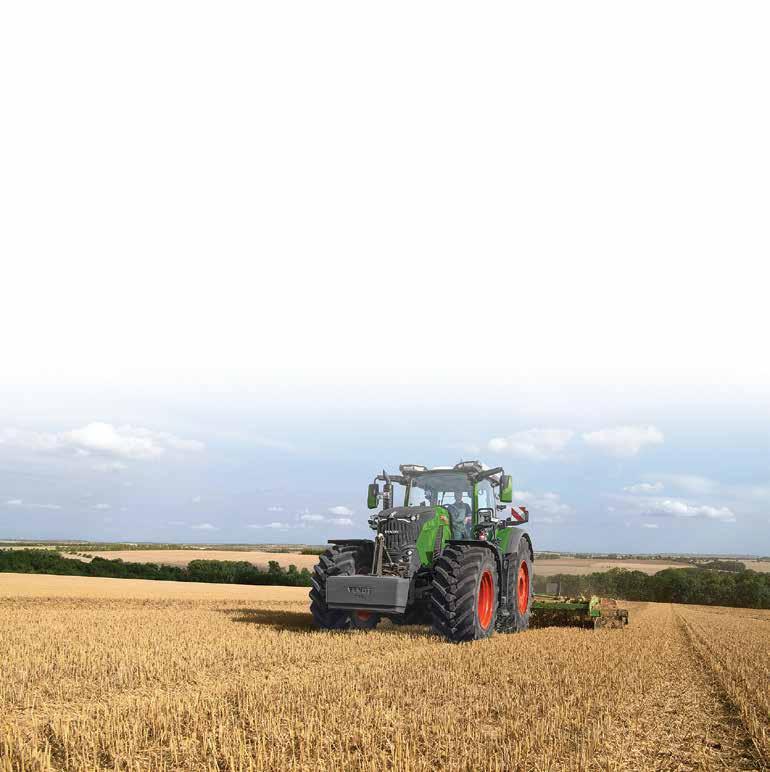
53 New from Pöttinger: Terradisc HT 12000
54 One pass machine improving southern WA soils
56 Renovated YP limestone lifts lentil yields up to 70%
57 Special-edition Steiger tractor provides Henty visitors a glimpse of the past and vision for the future
58 Fendt introduces completely new 800 Series Gen 5 Tractor Series
THERE’S AN OLD SAYING THAT FARMERS ARE THE ETERNAL OPTIMISTS — THE ONLY PEOPLE WHO BUY SEED IN THE HOPE IT’LL RAIN.
In Australia, that optimism has been tested more times than anyone cares to count. Between the weather, rising costs, and red tape, it’s a wonder anyone still has the energy to get out of bed before dawn. Yet, somehow, they do - and thank goodness for it.
Right now, Australian farmers are facing a perfect storm of challenges, each as unpredictable as the next.
The weather, for starters, is doing its usual impression of a moody teenager - too hot, too cold, too dry, too wet, and never at the right time.
One day you’re watching your crops bake, the next you’re watching them float away. And through it all, the forecasts remain as reliable as a politician’s promise.
Then there’s the cost of running a farmup, up, and away.
Diesel prices have taken flight, fertil -
ting it to market often costs more than it’s worth. And speaking of markets, global price swings make farming feel a lot like gambling - only the casino doesn’t have to worry about drought.
Add to that a chronic labour shortage, and things start to look even tougher.
Good help is hard to find, and the average age of Australian farmers is creeping steadily upward.
The next generation, it seems, would rather be coding apps than chasing cattle or fixing pumps. Can’t really blame them - coding doesn’t usually require pulling a bogged ute out of a paddock at 2am.
And let’s not forget the paperwork. Between environmental regulations, compliance forms, and the ever-changing rules around water, farmers now spend nearly as much time in the office as they do in the field. It’s hard to grow food when you’re buried under forms.
Still, for all the challenges, the resilience of Australian farmers remains remarkable. They keep going, season after season, with grit, humour, and the occasional curse at the clouds. Because at the end of the day, feeding a nation - and a good chunk of the world - is no small feat. And if anyone’s earned the right to complain about the

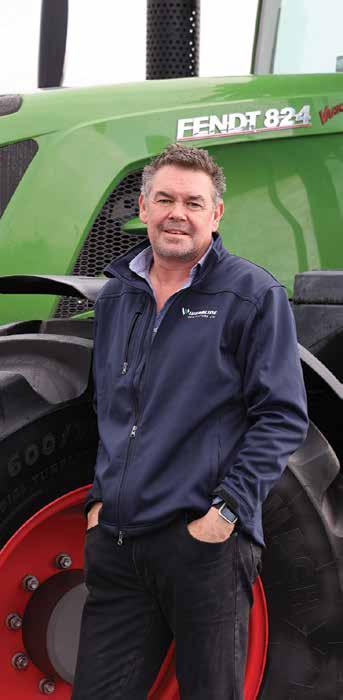



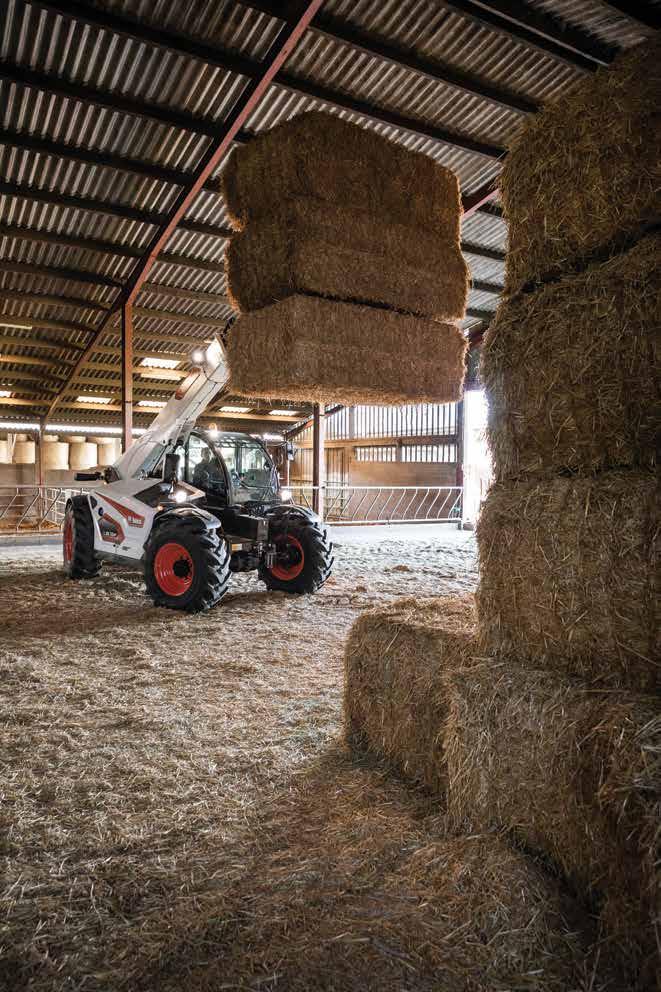
CORRIGIN FARMER CRAIG LARKE IS BASED IN THE CENTRAL WHEATBELT
REGION OF WESTERN AUSTRALIA, 229KM EAST-SOUTHEAST OF THE STATE CAPITAL, PERTH.
As a third-generation farmer, Craig and his wife, Peri, raise their four children on a 4100ha property, with an additional 1100ha shared-farm. Their operation is 100% continuous cropping, which is 40% canola, 30% wheat, and 30% barley.
The owner of two new Claas Lexion 8800TTs with Convio 1380 fronts, that are now in their second harvest season, he can often be found speaking to neighbours about the performance he gets out of the European-made machines.
“It’s so easy these days to be a follower and support the largest brand, but it was more important to me to do the research before I was ready to buy my machinery. I wanted to know that I would invest my money in something that would increase my on-farm efficiency and be the best spending outcome for my business.
I also wanted to guarantee that after the sale, I would be backed by a team of professionals who cared about keeping me going, particularly through the peak period.”
Craig’s relationship with the local Northam, Claas Harvest Centre (CHC), started five years ago with the purchase of an Amazone Spreader, well before he was ready to invest money into his new grain harvesters.
When it was time to upgrade his three John Deere combines, Craig’s goal became to reduce losses and improve automation. He took the time to be analytical and pair the mathematical results he sought before purchasing, with the right product and to him, the Claas combine seemed superior to the competitors. Placing a call to Melvyn at the Northam CHC, Craig said, “I’m done with the

single-rotor machines. I want to buy two Lexion combines to reduce our rotor losses and improve residue spreading.”
And he hasn’t looked back!
“We are very happy with how the Lexions perform; their reliability has been exceptional. We knew the Lexion platform had been well proven over the years and continues to develop.”
“We’ve reduced our losses and improved throughput - all through the Lexions ability as a true small grains combine (which is what we grow in WA). Early threshing and separation, twin rotors, an even cut, and a spread residue system are a priority. The Claas Cemos automation has provided us with an efficiency gain with inexperienced staff, when running multiple machines. It gives confidence in the correct combine setup for a learner driver and for loss control, whilst still maintaining capacity.”
Craig is an avid fan of pre-season maintenance being conducted by the Claas Harvest Centre team.
“I prefer Claas Harvest Centre Northam
to come out and check over my machines to prepare them well before harvest and check for any potential future issues. Doing repairs myself Isn’t practical these days. Qualified, experienced mechanics that see these machines every day typically know what fails and when.
“I’m happy to do this ASAP post-harvest taking advantage of early offer promotions and not leaving it to the latter half of the year where dealerships get under time pressure pre-harvest.”
When speaking about the qualified technicians from his local Claas Harvest Centre, he is particularly impressed with their meticulous service and detailed explanations.
“They take a lot of pride in what they do.
And with parts and consumables, I like to keep a really good supply on-hand on my farm. The hour-and-a-quarter drive to the CLAAS Harvest Centre can be time-consuming, but Mel will often drop them off to us if he is coming our way.”
Since purchasing the Lexion machines,

FIVE OUTSTANDING AUSTRALIAN TECHNICIANS HAVE BEEN HONOURED AT THE FIFTH ANNUAL JOHN DEERE TECHNICIAN OF THE YEAR AWARDS, ANNOUNCED AT A GALA DINNER IN BRISBANE.
From a technician who began their career in Romania to another now based in Roma, the winners demonstrated exceptional skill and commitment over two days of rigorous testing at John Deere’s Crestmead headquarters. This year also marked a first, with New Zealand’s Bryce Dickson becoming the only person to win a trophy in three separate years.
The 2025 awards recognised:
- Australian Agriculture & Turf Service Technician of the Year
- New Zealand Agriculture & Turf Service Technician of the Year
- Australian and New Zealand Parts Technician of the Year
- Australian and New Zealand Construction & Forestry Service Technician of the Year
- Australian and New Zealand Service Apprentice of the Year
- Australian and New Zealand Parts Apprentice of the Year
John Deere Australia and New Zealand Managing Director Luke Chandler said the awards highlighted the technicians’ vital role in supporting key industries.
“Congratulations to all our Australian winners, who have shown exceptional technical knowledge, customer focus and ability to solve problems under pressure,” he said. “They are the people who keep our customers moving every day and it’s fantastic to see their talent and hard work acknowledged.”
Luke also commended the finalists. “The finals process is rigorous and designed to test even the most experienced technicians. To reach the finals is a huge achievement and speaks volumes about the capability and
Craig has added a new Claas Xerion 12.590 Tractor and a second-hand Scorpion telehandler to his fleet.
“I’m happy with all of the gear that I have purchased and the support that I have from the team.”
Craig has also been pivotal in spreading his thoughts on light green.
“Several neighbours rang me, there are very few new Lexions in this area, so everyone was inquisitive. Two was a big upgrade,
commitment of each participant.”
He said this year’s technicians represent the next generation of service excellence in agriculture, construction and forestry. “Their professionalism and problem-solving ability ensure farmers, contractors and businesses can achieve more with their equipment,” he said.
He also congratulated Bryce Dickson, from Brandt, Whangarei, New Zealand, for taking home the New Zealand Agriculture and Turf Service Technician of the Year Award for the third time. “Bryce is committed to being the best in his field by consistently challenging himself and continuing to grow his technical expertise in John Deere’s suite of precision ag technology and equipment.”
John Deere Customer Support Business Manager Marko Koelln said this year’s finalists reflected the diversity of people entering and excelling in technical careers.
“Our finalists come from a wide range of backgrounds, with many starting their careers in different industries before finding their calling as technicians,” he said. “What unites them all is a passion for learning, a drive to deliver great service, and a genuine connection to the customers and communities they support. That’s what makes these awards so important. They shine a light on the people who keep our customers running.”
Daniel Popovici, AFGRI Equipment, Albany, WA
Starting his career with a John Deere dealership in Romania more than a decade ago, Daniel Popovici grew up surrounded by machinery, developing a fascination for engines and technology that shaped his future. Now based with AFGRI Equipment in Albany, his enthusiasm and technical excellence earned him the 2025 Australian Agri-
but the aim was simplicity and efficiency. A lot of guys ask me how they are going, as they are built in Europe, and they expect them not to work in our conditions. I tell them they are performing fine, with no overheating or cooling issues.”
Craig has replaced only normal everyday consumables in the two seasons, and with the rising cost-of-living, questions why people are still going with single-rotor corn harvesting machines.
culture & Turf Service Technician of the Year title.
Daniel said it was an honour to be recognised. “This is a huge boost,” he said. “As a technician, we do our jobs and don’t always receive thanks. This event is amazing, and it really feels good to be recognised for those long hours through harvest and those long weekends – it’s seven days a week and it’s absolutely amazing to win.”
His success will also be celebrated back home in Romania, where both his father and brother work at a local John Deere dealership. “My father will be extremely proud as he already was when the finalists were announced,” Daniel said. “He actually went to a job and the customer said, ‘hey I saw Daniel on John Deere’s Facebook’. That day exploded. I got so many messages and calls from people I haven’t spoken to for years.”
Poppy Blohm, AFGRI Equipment, Narrogin, WA
A year after winning Parts Apprentice of the Year, Poppy Blohm has gone one better, taking out the 2025 Australian & New Zealand Parts Technician of the Year award. Her exceptional customer service and technical knowledge have cemented her reputation at AFGRI Equipment in Narrogin.
“I was surprised last time I won, and I’m surprised tonight too,” she said.
Originally from Perth, Poppy’s journey into agriculture began when she attended an agricultural school in Harvey and later worked at a grain handling facility. When an opportunity arose with AFGRI Equipment, she seized it – and has thrived ever since.
Poppy has also won a WA Regional TAFE Trainee of the Year Award, reflecting her dedication and empathy for her customers.
“Farming is these people’s livelihoods,” she said. “When they’re broken down, it affects
“I now do the work of the three machines with only two, with less fuel, less labour, less losses - it just makes sense.
I like to think I’m opening other people’s eyes to the possibility of changing from other brands,” Craig says.
Craig was instrumental in converting another local customer to two Claas Lexion 8800TTs, two Convio 1380s, a Claas Arion 630 C-Matic tractor and a Claas Liner 2900 Trend.

their mood and mentality. Giving them a tiny little part that might get them up and running again means a lot to them – and that’s the biggest reward.”
Outside work, Poppy enjoys time with her animals: horses Magic and Flora, and her miniature Dachshund, Brandy – a passion inspired by her mum, a vet.
Damian Aspinall, RDO Equipment, Roma, QLD
When Damian Aspinall moved to Roma, his cricket debut earned him a light-hearted “duck trifecta” – but his career as a John Deere technician has been a resounding success. The RDO Equipment technician took out the 2025 Australian & New Zealand Construction & Forestry Service Technician of the Year award.
Growing up in Richmond, North West Queensland, Damian was surrounded by machinery through his family’s earthmoving business. His interest deepened when his father bought a grader when he was 12, leading to an apprenticeship with the local council and his first exposure to John Deere equipment.
After relocating to Roma two and a half years ago, Damian said he was thrilled to build new skills and work with an outstanding team. “I’m over the moon,” he said. “This
award is a big thanks to all the team back in Roma. Without them I wouldn’t be here. Everyone in the team relies on everyone and we all learn from each other.”
Mentoring young apprentices is his next goal. “I just want to continue doing what I am doing and helping the apprentices come along and reach their best potential,” he said. “We’ve got three apprentices back at Roma –all good young fellows – and it would be great to sign them all off.”
Henry Barkley, Haeusler’s, Mildura, VIC
For Henry Barkley, time spent helping on his uncle’s Barossa Valley farm and a week of work experience at a John Deere dealership set his path.
After a school-based apprenticeship, Henry joined Haeusler’s in Mildura, Victoria – a decision that led to him being named the 2025 Australian & New Zealand Service Apprentice of the Year.
He credits advice from his uncle for shaping his work ethic. “My uncle always said, ‘don’t give up when times are tough’. Jobs can be challenging, and you get tough customers, but just keep pushing through. There’s always a solution.”
This year has been especially significant for Henry – he not only claimed the award but also bought his first home with partner Jaymee Ireland, the 2022 Agriculture & Turf
Service Technician of the Year. “I’m pretty excited and honoured and feel like I’ve come a long way,” he said. “I’m quite blown away and proud of the journey I’ve taken.”
Olivia Barsley, Hutcheon & Pearce, Cowra, NSW
Perth-born Olivia Barsley grew up far from the paddocks but found her passion for agriculture through showing livestock. After finishing school, she moved to New South Wales to study a Certificate III in Agriculture at Tocal College and gain hands-on experience across cattle stations and mixed farms. Her determination led to a role with Hutcheon & Pearce in Cowra, where her commitment and teamwork have now seen her named the 2025 Australian & New Zealand Parts Apprentice of the Year.
“I really still can’t believe it,” she said. “But it’s really thanks to everyone at work pushing me to get out and have a go.”
Olivia’s colleagues also encouraged her nomination for the NSW Training Awards, where she won Trainee of the Year for the Western Region. She enjoys the fast-paced nature of her work. “The most rewarding part of my day is probably seeing that customer satisfaction,” she said. “Seeing the customer walk through the door and leave with a smile and never knowing what’s going to come in the door.”
IT’S HARD TO BELIEVE IT’S BEEN A DECADE SINCE THE FIRST SEED TERMINATOR ROLLED OUT ACROSS AUSTRALIAN PADDOCKS. IN THE REAR-VIEW MIRROR, THOSE FIRST GENERATION MACHINES MIGHT SEEM PRIMITIVE. BUT EVEN THEN, THEY CARRIED THE SAME CONVICTION: THAT STOPPING WEEDS AT HARVEST WAS NOT JUST POSSIBLE—IT WAS ESSENTIAL. TEN HARVESTS LATER, THAT CONVICTION HAS ONLY DEEPENED.
Much has changed in the last decade. New chemistries have come—and in some cases, already gone. Integrated Weed Management (IWM) and Harvest Weed Seed Control (HWSC) have become mainstream. There are new crop varieties, advances in soil amelioration, precision ag, even the occasional curveball—like a global pandemic. And through it all, one thing has remained clear: weeds adapt, but so do farmers.
The Seed Terminator journey has never been about chasing shiny objects or the next agtech wave. It’s been about digging in—refining, upgrading, and responding to what’s happening in the paddock, not just in the lab.
Even in a globally depressed machinery market, Seed Terminator has doubled down—not on selling, but on building. With reduced spend on sales and marketing, resources have gone into product development, testing, and performance upgrades.

So when farmers are ready to invest again, the value is already waiting for them—more capacity, smoother installs, tougher components, better outcomes.
This season, the full suite of new models is a testament to that focus. From the latest AF10 and CR11 platforms, to John Deere’s S & X series, and now the new S7 range. From Claas Lexions, to upgrades for the New Holland’s 8.90–10.90 range, and of course Case IH’s Flagship series, there aren’t many headers Seed Terminator doesn’t fit.
One of Seed Terminator’s early commitments was building a future-proof platform—and they’ve delivered on that promise. Through backwards-compatible upgrades, retrofit kits, and continuous R&D, they’ve ensured that the earliest

adopters aren’t left behind—they’re leading the way. Because progress shouldn’t leave the early believers behind.
That evolution is also reflected in the heart of the technology: the AeroIMPACT mill, now in its fourth generation. The latest variant lands just in time for this year’s harvest, built on stationery testing, real-world data, and farmer feedback.
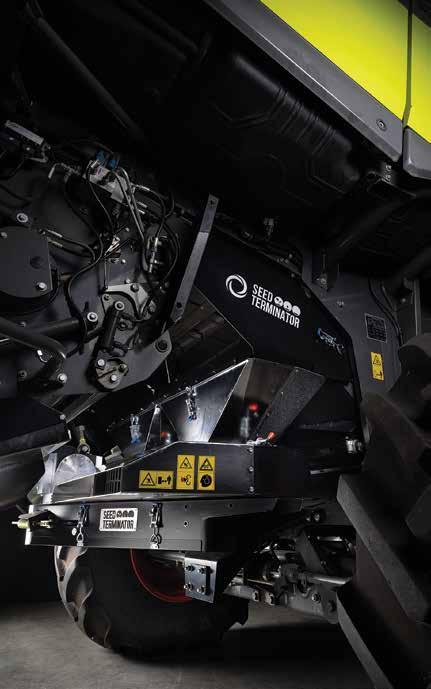
WITH HARVEST SEASON BEGINNING ACROSS AUSTRALIA, NEW HOLLAND IS MARKING THE 50TH YEAR SINCE INTRODUCING THE FIRST COMBINE FEATURING THE BRAND’S TWIN ROTOR THRESHING AND SEPARATION TECHNOLOGY.
New Holland’s twin rotor product line has grown from the launch of the TR70 combine in 1975 to a complete range today, led by the new CR10 and CR11.
CNH Product & Portfolio Manager – Crop Harvesting ANZ, Marc Smith said New Holland has refined the twin rotor concept for five decades.
“The twin rotor technology represents a significant innovation in combine harvester design, showing how a machine can harvest grain more efficiently,” he said.
“The twin rotor system can tackle any type of crop, producing large amounts of centrifugal force creating grain on grain threshing, superior grain quality and high performance in small grains.
“IntelliSense automation can alter the pitch of rotor vanes without completely changing the concave setup, so it can slow crop material down if needed, keeping it in there longer or speeding it up if over threshing the material.
“The twin rotor design continues to be the cornerstone of our product performance, helping farmers maximise their combines efficiency,” Marc said.
Over 70,000 TR and CR Twin Rotor combines have been produced globally to date.
New Holland’s Centre of Harvesting Excellence in Zedelgem, Belgium, has recently undergone significant investment and upgrading for production of the latest CR10 and CR11 models.
While herbicide resistance continues to be a major driver of adoption, there’s a deeper truth underpinning harvest weed seed control: a Seed Terminator acts on all cohorts— not just the ones that emerge early. Where a knockdown might achieve 95% control, it’s often only targeting 40% of the season’s weeds—delivering, in practice, closer to 38% overall control.
“This idea that you only get 50%, so it’s not worth it—that mindset needs smashing,” says Dr Nick Berry. “It’s a globally important shift.”
And the data backs him up. The RIM model, developed by AHRI and CSIRO, has shown that even moderate reductions in


Well-known for its expertise in grassland farming products such as balers and forage harvesting equipment, New Holland, then primarily a US-based manufacturer, entered the combine market in 1964 when it acquired
the seedbank at harvest can dramatically change the weed seed bank trajectory over time—especially when combined with other integrated tactics.
As the old saying goes: one year’s seeding is seven years weeding. At harvest, there’s no ifs. You collect the weed seeds, or you don’t. You crush them, or you spread them.
And for those watching from afar, it seems the word is spreading. A recent Instagram like from Kaleb Cooper of Clarkson’s Farm may not be a scientific endorsement—but for many in ag, it’s a life goal unlocked.
Of course, behind every bit of progress— every chassis, screen, and mill—is a com-
Belgian company Claeys, which had introduced its first self-propelled combine in 1952.
Over the decade that followed the acquisition, New Holland continued to develop the conventional straw-walker combine line it had acquired, but during the 1960s began to investigate new ways of threshing and sepa-
munity of farmers who took a punt, backed the idea, and helped shape it into what it is today. Seed Terminator’s tenth Australian harvest isn’t just a milestone. It’s a quiet tribute to those who believed a better system was possible—and made it happen. Here’s to the legends who made it possible. And for those still considering it—maybe this is your season. What have you got to lose, apart from another year of spreading weed seeds?
Speak to your local Seed Terminator dealer. Get it sorted now in time for harvest. Because the best decisions are the ones you don’t have to second-guess at the end of the season. seedterminator.com.au.
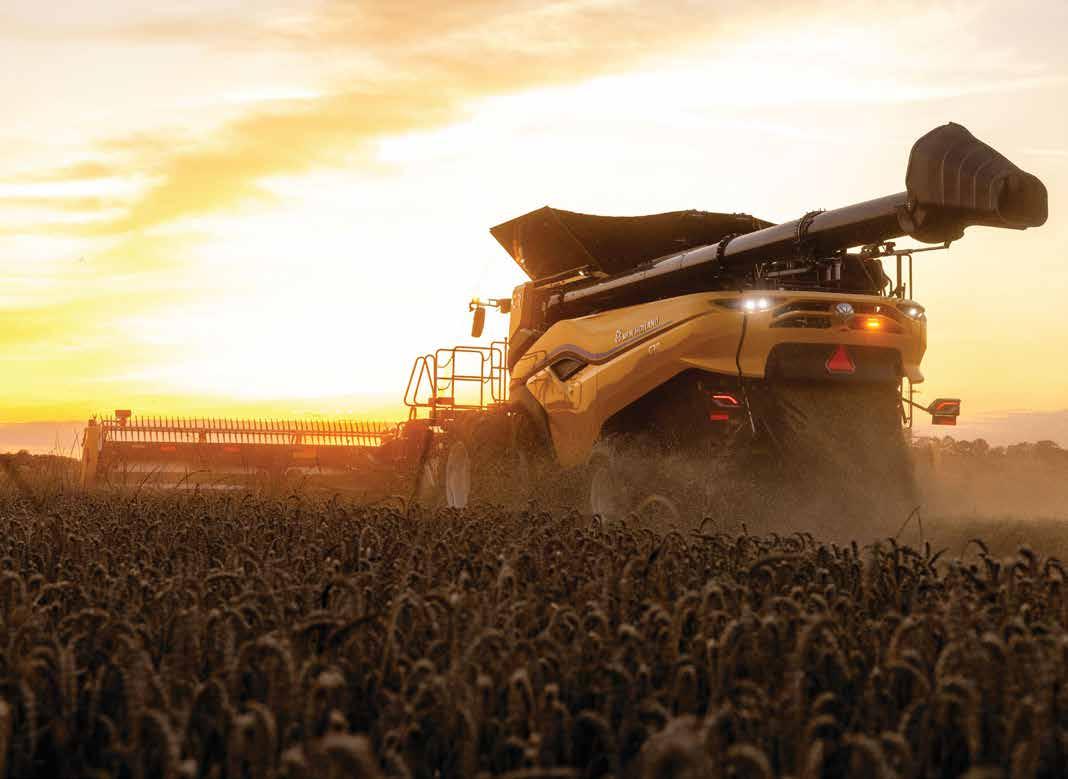
rating grain to boost output, increase cleanliness and reduce losses.
To do this, New Holland engineers studied centrifugal force and its potential for separating grain from plant matter, an innovative concept distinctly different from the drum/ concave and straw-walker traditional method of threshing and separation.
The first development machine, adapted from a 985 straw-walker model from the Claeys factory in Belgium, was trialled in corn in 1968, and wheat the following year.
The trials showed benefits from splitting the incoming crop flow from the elevator/ feeder house into two streams, feeding it into two counter-rotating longitudinal rotors working against longitudinal concaves that consisted of threshing sections followed by separation sections.
The high speed of the rotors meant centrifugal force ejected much of the grain through the concaves, minimising grain damage when compared to conventional drum and concave threshing, and minimising losses when set against straw-walker separation.
By 1969, a totally new combine design with these internal elements was under test, and in 1975 the first production model, the TR70 with a 145hp engine and 5,550-litre/158-bushel grain tank, was launched – the first New Holland combine
built in the USA. In 1979 it was replaced by the upgraded TR75, and joined by a larger companion, the TR85. Over the next two decades the range evolved, with the 25,000th TR combine produced in 1997.
European high-capacity combine development had taken a separate path with the development of the Twin-Flow combines introduced in 1983. These used a conventional drum and concave followed by a large beater and rotary separator and then a lateral Twin Flow rotor that split the crop into two streams to separate the final grains.
However, by the late 1990s New Holland engineers in Europe and North America began work on a totally new Twin Rotor design that would meet the needs of farmers around the world in all types of combinable crop.
Introduced in 2002 and blending key features from the TR and TF machines with new developments and styling, the new 333hp CR960 and 428hp CR980 were initially built in the USA, before production was transferred in 2005 to the Zedelgem plant in Belgium.
The CR960 featured twin rotors of 432mm/17in diameter, with larger 560mm/22in diameter units on the CR980, which had a 12,500-litre/355-bushel grain tank. Operators benefited from a completely new cab design. The range was gradually expanded, and introduced features including IntelliSense combine automation, Dynamic Flow Control remotely adjustable rotor
vanes, Dynamic Feed Roll technology and Opti-Spread Plus residue management.
Development of the Elevation models in 2007 introduced IntelliCruise feed rate control for maximum output, and Opti-Clean cleaning technology to further enhance grain cleanliness. These and other innovations have earned the TR and CR combines multiple industry awards throughout the world.
The next development was the CR7.90, CR8.90, CR9.90 and CR10.90 models, with the latter machine in 2014 taking the Guinness World Record for the most wheat harvested in eight hours, at 797.656 tonnes (29,308 bushels). The record still stands today.
The New Holland CR combine range is now topped by the recently introduced CR11 (775hp, 20,000-litre/567-bushel tank capacity) and CR10 (634hp, 16,000-litre/454-bushel grain tank) models.
Like their forebears, they continue to incorporate proven Twin Rotor technology, but have more capacity than ever, with greater power and tank volume matched by rotors with a diameter of 600mm/24in and a length of 3,600mm/142in, to maximise crop handling capacity, ensure thorough threshing and separation, and protect grain quality.
Global events and initiatives are planned during 2025 to celebrate #TwinRotor50, while owners and operators are encouraged to share their memories of working with these machines at https://wkf.ms/41evGY8.
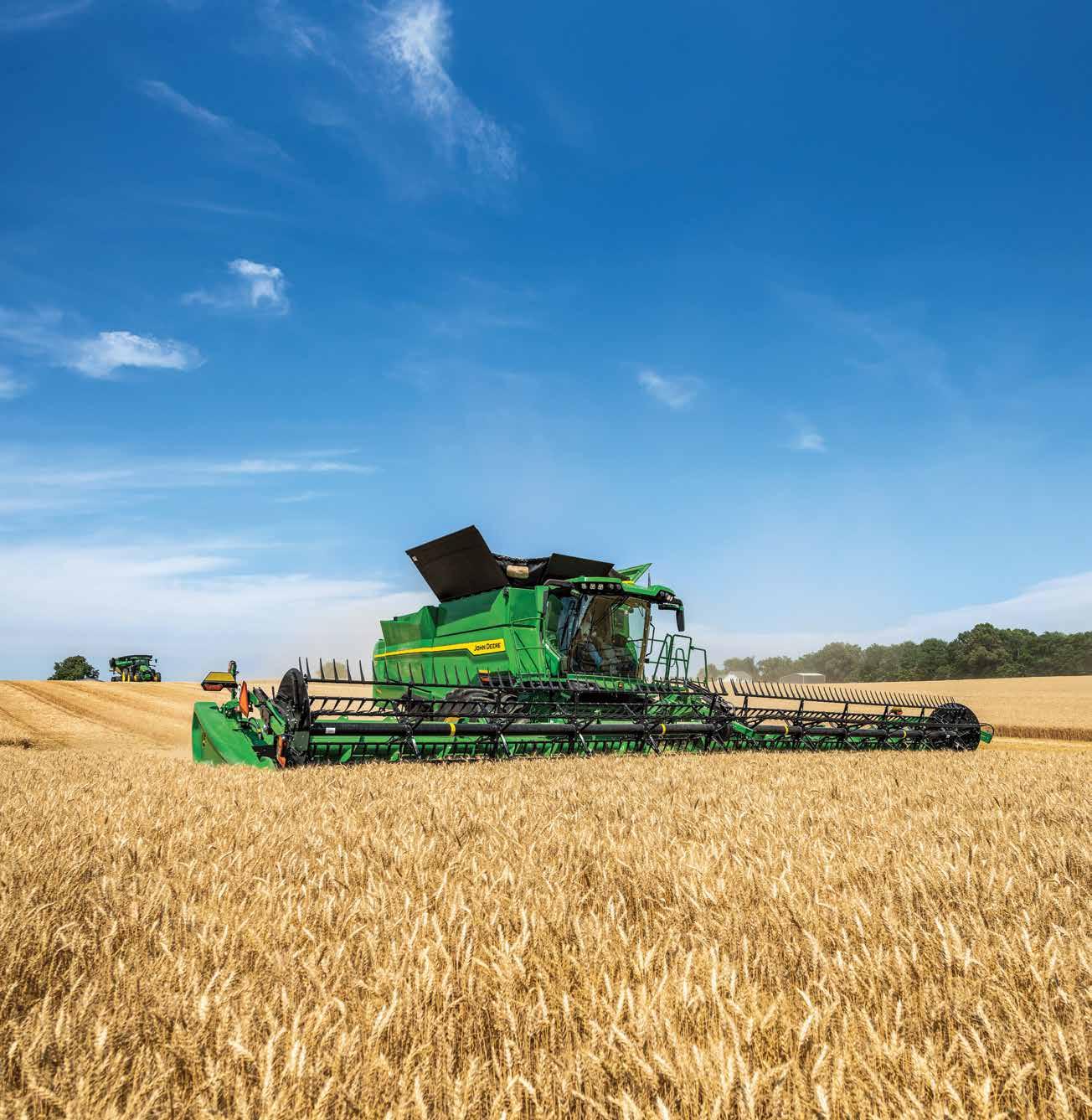

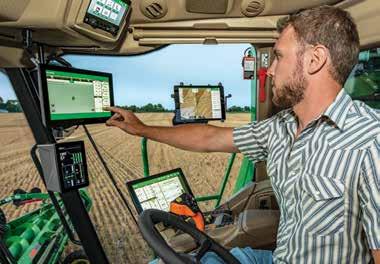
John Deere’s combine and front-end equipment, precision automation technology, and real-time data keep your operation one step ahead.
Cover more ground, faster, with more throughput, adapting to conditions and delivering cleaner grain with fewer losses.
And with connected dealer support and your operations data, you get more uptime, less stress, and smarter decisions applied automatically.
Ask your local dealer today about how to make yours a smarter harvest.
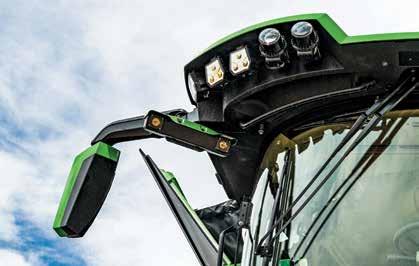

AUSTRALIAN FARMERS HAVE PUT JOHN DEERE’S NEW JDLINK BOOST TO THE TEST AND IT HAS COME THROUGH WITH FLYING COLOURS IN PROVIDING SATELLITE CONNECTIVITY BETWEEN MACHINES, EVEN IN AREAS WITH NO MOBILE COVERAGE.
Connectivity is widely recognised as one of the biggest challenges facing farmers, but it is now being overcome through the power of satellite technology.
The new JDLink Boost option is the result of John Deere’s partnership with Starlink from the SpaceX network, providing farmers navigating rural connectivity challenges with the opportunity to fully leverage precision agriculture technologies.
John Deere Australia and New Zealand Production and Precision Ag Marketing Manager, Royce Bell, said the technology was put to the test in real-world conditions during seeding, spraying and cotton picking in Queensland and New South Wales, where farmers were excited by the ability to access John Deere Operations Center in real time.
“JDLink Boost is a game-changer for farmers in rural and remote areas – it streamlines connectivity and provides seamless access to critical data and your team at the time you need it most for informed and timely deci-
sion-making,” Royce said.
“Farmers in areas with marginal mobile service coverage on their farms can now connect and take full advantage of John Deere’s precision agriculture applications and all of their benefits.”
John Deere Manager of Production Systems Services, Max Cusack, said the team was excited to expand its initial testing program to all customers across Australia and New Zealand.
“From the testing we have seen the ability to stay connected to allow farmers to make better decisions from the cab thanks to the guest wi-fi,” Max said.
“And more importantly, it allows managers to see how connected machines are operating in real time across their farm and fleet.”
After revealing JDLink Boost on the 9RX 830 at Farmfest in Toowoomba, Qld, in June, it was clear farmers were eager to get it their hands on the technology.
“Farmers all around the country will be able to see JDLink

Boost on the 9RX 830 demo machines this year, but even better, they can put it into their own machines for this harvest and reap the benefits,” Max said.
JDLink Boost adds the next layer to John Deere’s precision technology strategy and will enhance the performance of a range of systems including:
- John Deere Operations Center to assist farmers to plan, monitor and analyse.
- Access to remote monitoring and alerts to identify issues as they occur to ensure equipment is running at optimal levels.

- In-field data sharing in real time for more efficient application of resources and reduced waste.
- See & Spray Select for realtime transmission of agronomic and machine data from sensors and cameras mounted on the sprayer, enabling immediate analysis and response.
- Harvest automation through integration of sensors and systems that control combines to improve harvest efficiency.
- John Deere Connected Support so customers and dealers can respond faster to

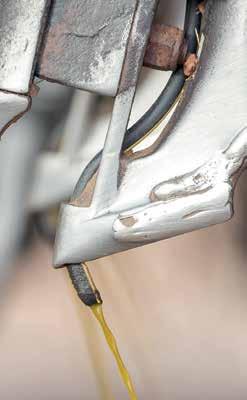
By Justin Van Viersen
A GENERATION AGO, A FARMER’S INSTINCTS DROVE MOST OF THEIR AGRONOMIC DECISIONS.
Today, Australian farmers have the benefit of advanced technology, real-time feedback and data, which has transformed the way farmers work and create success.
In fact, on-farm technology use has proliferated so much in the last decade that the majority of farmers today depend heavily on data to operate. We’ve seen this shift most significantly when we look at guidance control; a decade ago, maybe a few farmers on the cutting edge were casually exploring automated guidance. Today, most operations depend on guidance solutions to operate their machinery.
This is one of many examples we see where the use of technology is creating more data output and enabling farmers to make data-driven decisions. To stay competitive and maximise these advantages, farmers need to leverage their data more effectively. Here are three key steps to follow that can support better decision-making and improved results:
There is still a human element to farming when it comes to knowing the ground, understanding requirements for success and the ability for people –not machines – to make informed decisions. But, the scope and capabilities of machines using today’s technology continues to expand, and with it, so too does the amount and variety of data farmers collect. It’s critical to see the metrics and performances of
any issues, with access to solutions like Expert Alerts, Service Advisor Remote, and Remote Display Access.
Royce said the faster and more reliable connectivity would not only assist in responding to issues quickly, but also assist in
your technology – to actually use the data you’re collecting. When you do, you’ll gain an understanding of machine feedback, and ultimately be able to make profitable adjustments when opportunities arise.
For example, farmers can use their data to review a planter pass or a pass on a sprayer and overlay that with a yield map to see a fuller picture of what’s happening. Using data, farmers will have a clearer picture to make profit-generating adjustments.
Once you’re aware of the ways data can positively influence your results, it’s time to set up systems to ensure you’re collecting relevant information, and doing so in a way that will produce usable data. This includes integrating technology throughout your operation with tasks like building boundary lines, organising scripts into a software management system like the newly released PTx FarmENGAGE farm software product, and sending work orders even if you aren’t physically in the tractor. Taking time to build these data integrations during the offseason will give you confidence that you’re using technology effectively and set you up for a more seamless experience when planting season begins.
With better data, farmers can see the fruits of their labour
predicting maintenance recommendations, thereby reducing downtime and ultimately boosting operational efficiency.
“With real-time access to data we can help farmers schedule maintenance activities at convenient times, reduce unex-

come together and understand what was going on while they were in the cab. It can help explain and understand yield performance, for better or worse. Maybe there was an issue with your planter on a specific pass, or you experienced an issue with your sprayer, or your tank ran out of chemical on the last pass before you realized it was low. Having data tied to these operations will help you see anomalies that go against a historic yield map and provide answers to questions you might have about what happened, why you did or didn’t perform as expected.
A generation ago, farmers used yield maps primarily as a historical record of performance. Today, a yield map has much more utility with evidence to explain what’s happening in realtime, and where you can make adjustments and improve yield. You can make decisions faster while you’re planting or applying inputs. And in many cases, today’s technology can enable you to simplify what you’re doing in the cab by leveraging sensors to help inform your decisions and
pected breakdowns and ensure equipment is always operating at its best,” Royce said.
“JDLink Boost enables secure transmission to Connected Support, allowing technicians to remotely diagnose issues with equipment and speeding up
gain confidence. For example, using autonomous solutions, you don’t have to use brainpower to inform when you’re turning sections on or off, or identifying weed pressure. And better still, you don’t just have to believe you’re doing the right thing, as farmers did a generation ago. Today’s farmers using these technologies will know with certainty because the data tells them.
Using technology, the next generation of farmers have an exciting opportunity to change the game as they learn from their machines in real-time. They’ll need to keep up with rapidly generated data and expanding machine capabilities as operations become more automated. But, the payoff is worth it. Farmers will be able to understand what’s happening in their fields in real-time and make improvements immediately, rather than waiting until the next season.
repairs, saving farmers time and money.”
JDLink Boost is available to order now, in stock and ready for harvest this year.
For more information about JDLink Boost, contact your local John Deere dealership.

BETTER RETURNS AND AN OPPORTUNITY TO SUPPLY MORE SUSTAINABLE, LOCALLY GROWN RICE TO THE HOME MARKET ARE BEHIND A NEW VENTURE FOR RIVERINA RICE GROWER GEORGE STEVENSON.
“A lot of farmers really don’t appreciate how things are changing. Customers are looking for responsible lower emission products,” he says.
George is one of around 2,000 rice growers in Australia. Most of these rice producing farms are located in the Riverina region of New South Wales, and they produce more than 95% of the 600 -700,000 tonnes of rice grown in Australia each year.
Up until this year, the rice produced in the state was processed and sold under the SunRice brand, which held exclusive rights to selling out of the state both domestically and exporting.
While this saw growers dealing with a reliable and successful brand, it didn’t give them much leverage as far as payments for their crops went.
GEORGE, KARINA AND TWO-YEAR-OLD OLIVERFARMING WITH A LIGHTER TOUCH IN JERILDERIE, NSW.
With increasing costs, some growers were seriously thinking of leaving the industry.
“We felt as though there were diminishing returns, with the price at which we were growing rice, dictated by SunRice,” says George.
A change in legislation this year removed the monopoly seeing NSW growers able to pursue other options.
GEORGE IS AMONG A GROUP OF GROWERS LOOKING TO TAKE ADVANTAGE OF CHANGES TO RICE CROPPING SYSTEMS WHICH REDUCE METHANE EMISSIONS.
With a Bachelor of Ag Science from Melbourne’s La Trobe University under his belt, along with a Bachelor of Business in International Trade and Finance, George was in a better position than most to see where Australian rice production sat in the broader scheme of things.

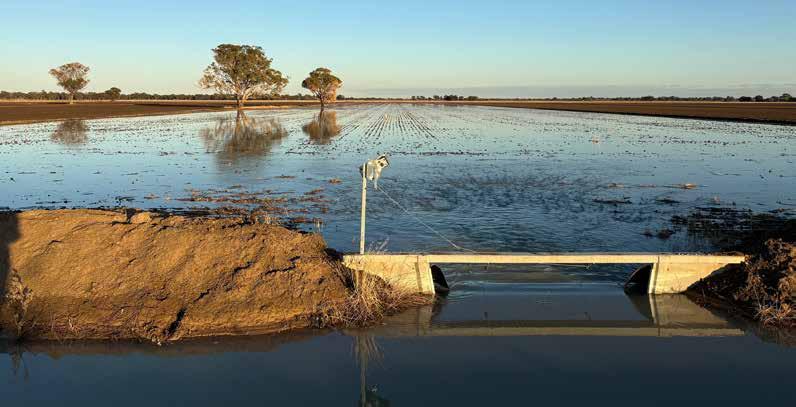
DRILL SEEDING AND PERIODIC FLUSHING OF THE PADDOCKS UNTIL THE CROP IS ESTABLISHED REDUCES THE AMOUNT OF TIME THE RICE CROP IS PRODUCING METHANE.
SunRice is very export orientated, George says, and while they do supply the domestic market, they don’t sell all of the different varieties that growers produce.
“We grow long grain which is Jasmine rice, a myriad of short grain and medium grain rice. The majority of those varieties won’t retail in Australia.”
This saw most of the rice on local supermarket shelves
Rice as a crop has a particular problem with high methane emissions when grown traditionally.
With advances in cropping systems in Australia, reducing these emissions, George and a small group of local farmers felt there was a good opportunity to take advantage of the gap in the domestic market for their lower emissions rice.
“If you want access to a high-value market, you need to meet a certain minimum standard of production, but also in emerging premium markets that once upon a time anybody could play in. Now, we’re being held accountable and we’re seeing that in the pricing of our products.”
Grown in flooded fields or paddies, rice production accounts for nearly half of all the green-
“We wanted to set up a rice brand and processing facility that championed an environmentally and socially responsible system, where we’re growing rice in industry leading conditions using considerably less water than anyone else around the world,” says George.
Having a processing plant locally in the local Jerilderie area, with storage and drying facilities, would keep transport miles to a minimum.
“That way we could get rice onto people’s plates having travelled significantly less food miles, and with a lower carbon footprint.”
Even though they were cautious, research and setup costs were still considerably more than they anticipated, with the plant costing around $10 million, and funded mostly by themselves.
Water for irrigation is likely to become more of an issue as the climate warms making water security of special concern for
“We’re all competing for the same resource, so water is

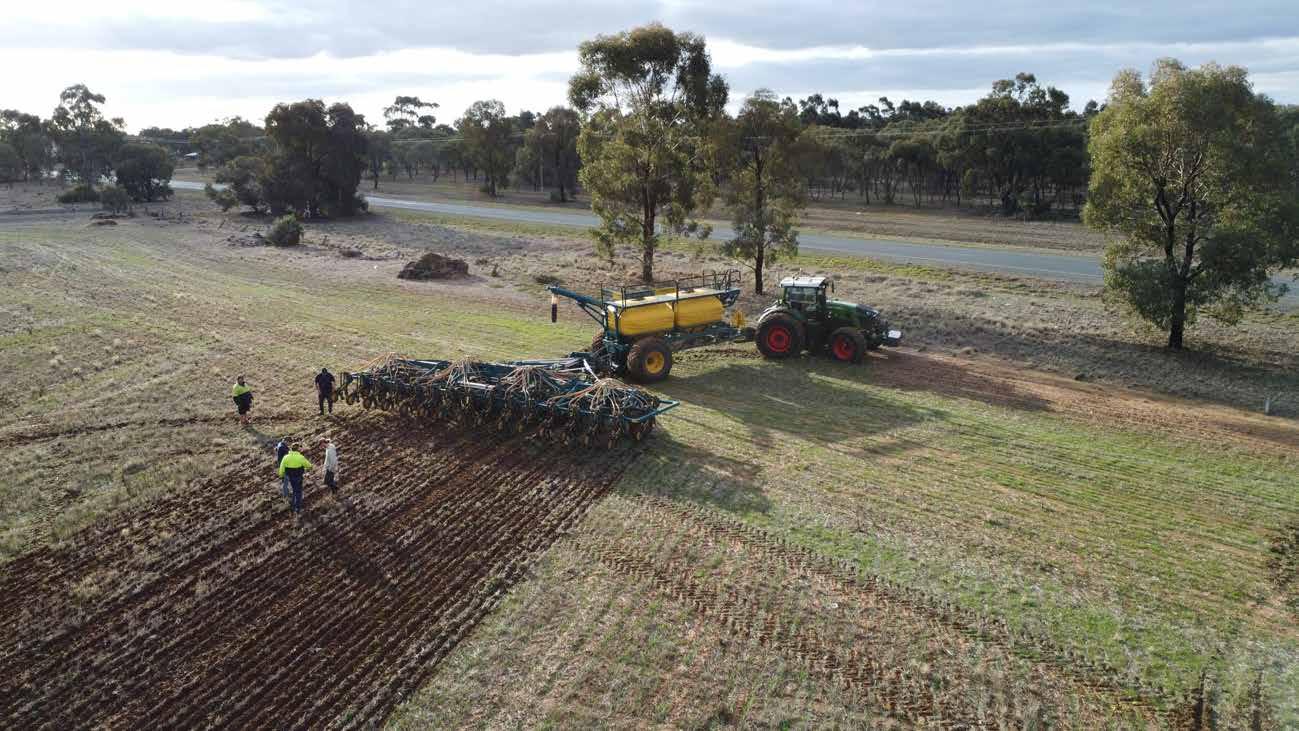






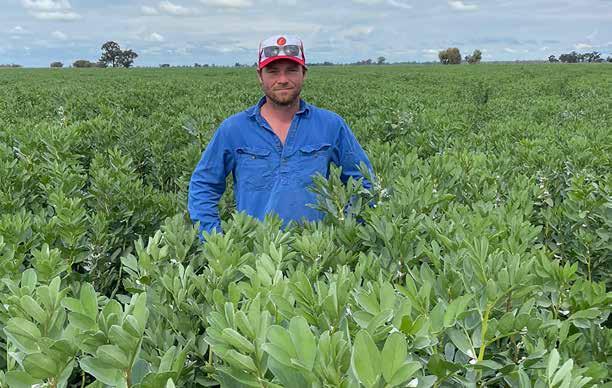
FABA BEAN IS ONE OF THE WINTER CROPS GROWN ON THE FARM ALONG WITH WHEAT, BARLEY, CANOLA, AND VETCH.
obviously our largest environmental and production risk. ”
This made water a big consideration as new growers looked to come on board with the venture.
“We wanted to make sure that we had some growers across different water sources to spread that risk.”
This saw growers in the Murrumbidgee Irrigation area, the Murray Irrigation area along with some growers with groundwater.
When the new legislation came into effect, the co-operative of around 30 like-minded growers were really able to push ahead.
George is now a director of the business with the newly minted Nice Rice brand name. He is also a non-executive director of Honestly Riverina, the parent company.
And things have moved quickly for the brand. They have seen
early success supplying the major supermarkets in Australia, touting the environmental credentials of their products.
“Price -wise we’re certainly in the upper price bracket with other branded products. We’re marginally dearer, but we’ve got some really good sustainable packaging and a good story to tell.”
Like many in the Riverina area, George’s family farm had been a soldier’s settlement block. Developed by George’s great-grandfather, it was originally a livestock grazing farm.
The introduction of irrigation had seen a move into cropping with the 1000 acre farm in
SECURITY IS ONE THE TOP CONSIDERATIONS FOR RICE GROWERS WITH ON-GOING BREEDING HELPING TO PRODUCE VARIETIES THAT NEED LESS WATER BUT THAT ARE ALSO MORE TOLERANT OF A COOLER CLIMATE.
David’s day expanding to 4000 acres today with up to 500 acres of rice grown annually.
As part of the Murray Irrigation scheme, their water source ultimately comes from the Murray River with the catchment in the Upper Murray alpine regions of Victoria and NSW.
Along with the summer rice crop, George and father Lockie also grow a series of winter cereals - wheat, barley, canola, faba bean, and vetch, with about half these crops irrigated.
When they have dry seasons and less water is allocated, they move out of summer crops that require full irrigation, and the cereal program becomes either fully dry land or supplemented with irrigation.
Flooding fields for rice isn’t cheap and is one of the biggest costs with production.
The problem with methane arises when the paddock is flooded and water sits there for months.
Starved of oxygen the soil becomes anaerobic. This sees soil bacteria then start to break down any dead soil organisms, dead plant material, fertilizers,
and outputs from the roots converting it into methane. This is absorbed by the roots, carried up the plant and released into the air through the leaves.
Reducing the amount of water used in production has not only reduced water costs but also considerably reduced the amount of methane coming off the crop, seeing rice crops now producing more than 40% less methane than traditional growing methods.
In the past, the paddocks were flooded in October and stayed submerged for around five months before being drained.
That all changed about 12 years ago when drilling the rice rather than aerial broadcasting started.
“By drill sowing now, the seed is under the soil, and the paddocks aren’t fully ponded now until late November or early December - once the crop is well established.
“We’ll plant the crop in early October and then flush it three to four times to get it established. We can then apply fertilizer and then go to a full ponding system for the remainder of the projectabout four months.”
The water, drained in midMarch a couple of weeks before harvest, also now goes into on-farm storage, before being reused to help irrigate wheat and faba bean.
Native bird populations and ducks have also been big winners with the new system.
Ducks had been a considerable nuisance when the rice was broadcast over flooded paddocks. They would hoover up the rice sitting on the soil underwater.
Along with some shooting, various lights and gas guns were used every six hours or so to

scare them off. This had been noisy and cumbersome but was a practice his father and grandfather had been doing for years to help establish the crop, George reckons.
But it wasn’t just the ducks that were being frightened off.
“This was also scaring away native species as well, including endangered [Australasian] bitterns and a lot of other native birds that didn’t necessarily do any harm or any damage to the crop. While they were certainly never shot, they were less likely to make our patch of earth their home.”
So, the increase of native birdlife about the farm has been more than welcomed.
Other changes have come from breeding rice varieties that suit the Riverina climate better.
“The rice industry’s got a really strong breeding program led by Rice Breeding Australia. We can now grow grains and varieties that potentially we never would have been able to before.
“This includes varieties that were more suited to tropical regions closer to the equatorincluding Jasmine rice, which has always been grown in a tropical region and originates from Thailand, Vietnam, Cambodia,” he says.
The rice crop fits in with other cropping around the farm, with no extra equipment needed.
Once the soil surface has dried out after flushing, it is firm enough they can use their own gear for spraying and fertilising –further reducing their reliance on aerial contractors.
“Come harvest time, we use a normal combine harvester with just some slight variations. But for the most part they’re often four-wheel drives and a bit bigger tyres. We don’t need tracked tractors.”
Reducing spraying costs and being more mindful of the effects of chemicals in the environment has seen George using integrated pest management more.
Other growers in the co-op are also encouraged to use it.
“We expect our growers to grow rice within certain parameters. Some chemicals they’re unable to use because of potential issues environmentally. We like to use beneficial insects instead of sprays where possible
BEING ABLE TO USE THE SAME FARM MACHINERY FOR THE VARIOUS CROPS CUTS COSTS AND REDUCES RELIANCE ON AERIAL CONTRACTORS.
- trying to let the ecosystem balance itself.
“We used to just spray as a precautionary measure, but now there’s been a lot of work done on where the economic thresholds are, for when we should spray.”
“We don’t want to be too restrictive on our growers too, as sometimes you’ve just got to do things unfortunately, but, as far as our farm goes, it’s in our best interest to actually do the best thing by the environment.
“For our farm, we apply what we have to, but work on a combination of crop rotations, some cover crops, growing legumes and pulses in the system to have an overall healthier soil and that creates good, healthy crops that often compete well with weeds, and mitigate the need for spraying.”
Sticking to a fairly tight, well organised schedule is important in the two Stevenson households on-farm since Oliver came on the scene two years ago.
Mum, Karina, is a paramedic with Ambulance Victoria in Cobram - just across the state line and works 30 hours a week in 12-hour shifts.
This also sees Lockie and wife Kaye part of the family network as they all manage daycare dropoffs and pickups, with Oliver also spending time riding around in tractors.
Karina and Kaye are also involved in the farm, along with a full-time staff member.
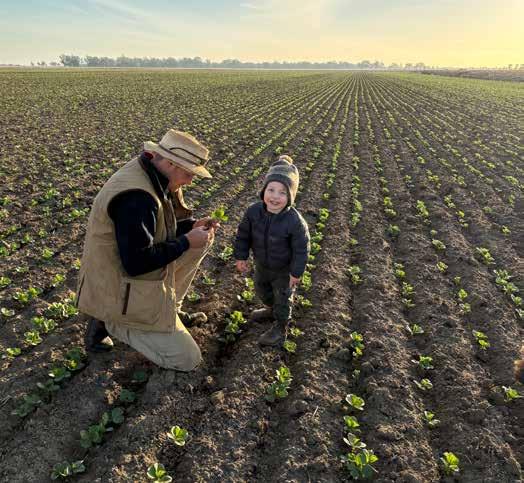
While they do less of the tractor work, they act as support staff for George and Lockie, picking them up and dropping them off when needed, along with moving equipment, collecting fuel trailers and the like.
“When we’re flat out, they’re keeping us fed and clean and in the best shape to be able to work some pretty long hours. We certainly wouldn’t be able to get the output from the farm that we do now without their support,” George reckons.
Like many generational farmers, George has a deep emotional attachment to the farm his great-grandparents started, and the wildlife and biodiversity that shares the land with them.
Certain places on the farm have a lot of sentiment attached to them - the place where he and Karina got married, another spot where his Aunt got married, a tree that was one of his grandmother’s favourites.
Then there’s the small, 100 acre, red gum wetland that they’re immensely proud of because of the amount of biodi-
versity it holds – “a full ecological system going on in there.”
At the end of the day, one of George’s pleasures is to grab a stubby and watch the sunset with the family on a paddock barbecue, enjoying the water birds and kangaroos.
“That’s part of why we do what we do - because we get to live here.”
“I think most farmers, if they could do something that had less of an impact on the environment and achieve the same outcome, they’re happy to adopt,” he reckons.
“Where we need to make tradeoffs which potentially reduce production, as an agricultural industry as a whole we’re happy to do that - provided the consumer is prepared to pay a premium for it.
“That’s the challenge of food production globally - how do we feed the population and maintain a really healthy environment. State government policy doesn’t do a great job of that, but if the consumers start acting with their wallets, we can see more, broad scale change.
“It is coming, and we’ve got to embrace it.”
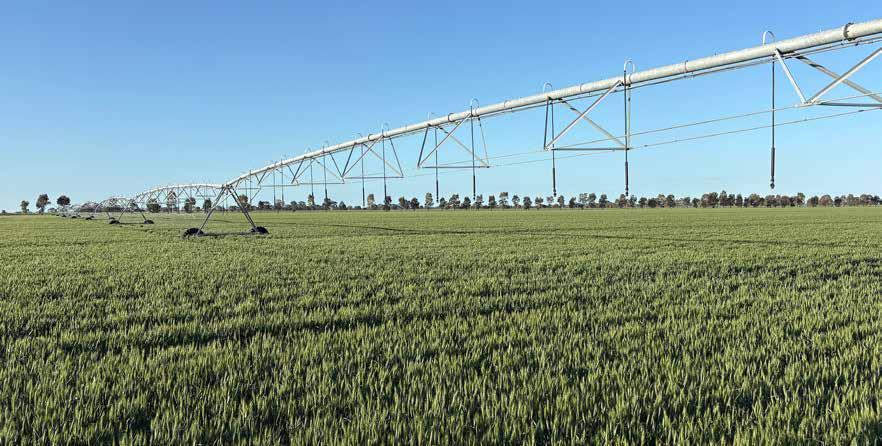

IN THE ROLLING COUNTRY OF THE SOUTH WAIKATO, WHERE THE LAND STRETCHES GREEN AND STEADY BETWEEN TOKOROA AND PUTARURU, A FAMILY BUSINESS HAS QUIETLY GROWN INTO ONE OF THE REGION’S MOST RELIABLE CONTRACTING OUTFITS.
Putt Contracting, founded and run by Chris Putt began in the most modest of ways nearly two decades ago with nothing more than a single truck and a willingness to take on whatever jobs came his way.
Today it has become a trusted operation built on hard work, steady investment and the strength of family ties.
business was as much about spotting a gap as it was about a determination to make something work. There was room for another contractor in the district, and Chris stepped into that space.
PUTT CONTRACTING’S FLEET OF FENDT TRACTORS PROVIDE THE BACKBONE OF THE BUSINESS WITH RELIABILITY, COMFORT AND POWER.
Growth came steadily but without fuss, and the business settled into the rhythms of silage, maize, cartage and the variety of jobs that keep contractors busy through the year.
Today, Putt Contracting runs a
fleet of nine tractors, dominated by Fendt – a brand Chris is loyal to. “Always been a lover of Fendt tractors,” he says with a grin. Among the line-up are three Fendt 930s and a 936, along
































across ditch the










PROFILED IN NZ’S RURAL CONTRACTOR & LARGE SCALE FARMER OCTOBER / NOVEMBER 2025, WE VISIT PUTT CONTRACTING IN SOUTH WAIKATO, NEW ZEALAND.
Chris remembers those early days with a touch of understatement. “It started almost thirty years ago with just a truck,” he says. “Then I bought a tractor and a spreader to do a lot of chicken manure back in those days. I figured if I had a tractor, I might as well use it for more than just spreading. So I bought a loader wagon and it just grew from there. One loader wagon turned into another, then I needed someone to help me and it just blossomed.”
The decision to build out the
QUIETLY GETTING THE JOB DONE SEASON AFTER SEASON ACROSS THE SOUTH WAIKATO.

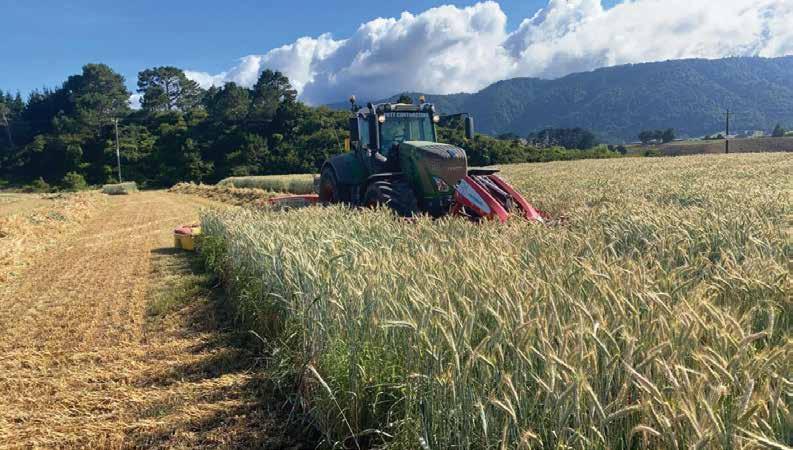
with 800 and 700 Series machines that cover the breadth of jobs across the business. For Chris, the 900 Series models are a particular favourite.
“The nine series are my favourite. They’re just a nice tractor to drive. They don’t seem to break that much, and they do the hours without giving trouble. A good tractor, no more problems than any other but a lot more comfort.”
The Fendt 936 Vario, part of the company’s backbone, is renowned for its combination of power and precision.
With up to 360hp on tap, it offers contractors like Chris a machine capable of handling heavy draft work, high-speed transport and the demands of running modern implements efficiently.
Fendt’s continuously variable transmission, the hallmark of the Vario system, allows seamless power delivery whether on the road or in the field.
For contractors working long hours in varied conditions, the 936 is as much about comfort as it is about productivity. With its spacious cab, intuitive controls and fuel efficiency it makes a long day’s work that much easier. It’s no surprise Chris rates it so highly.
While tractors form the core of the fleet, the real moneymakers come in the form of forage harvesting.
Putt Contracting runs a Claas Jaguar 970 self-propelled forage
STRONG CLIENT RELATIONSHIPS ARE THE FOUNDATION OF LONGTERM SUCCESS. FROM SILAGE TO CARTAGE, NO JOB IS TOO BIG OR TOO SMALL.
Claas,” he says. “It’s about keeping the work moving, getting through faster and staying reliable.”
In an industry where weather windows are tight and downtime is costly, having a chopper that can deliver on both speed and consistency is critical.
harvester, a machine that has set the standard globally for its class.
Claas has long been synonymous with precision, throughput and chop quality and the 970 continues that tradition.
Powered by 790hp and equipped with the Claas Shredlage crop processor, the Jaguar
970 ensures silage of consistently high quality. Contractors benefit not only from its ability to cover hectares quickly but also from its reliability under pressure.
For Chris, choosing Claas was about investing in performance he could trust.
“We’ve just bought a 970
The Jaguar’s advanced crop flow system coupled with intuitive operation from the cab, means Chris and his team can focus on the work rather than the machine.
The mowing side of the business is no less impressive. Putt Contracting runs a line-up of Pöttinger gear designed to get through large areas efficiently and deliver clean, even cuts.
The flagship is a Novacat V10000 Crossflow triple
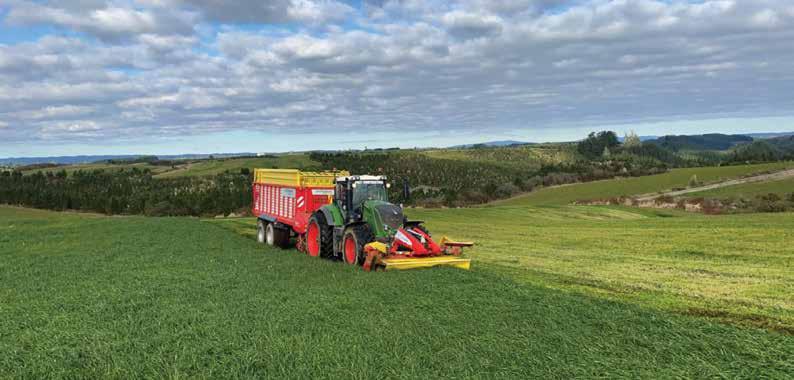

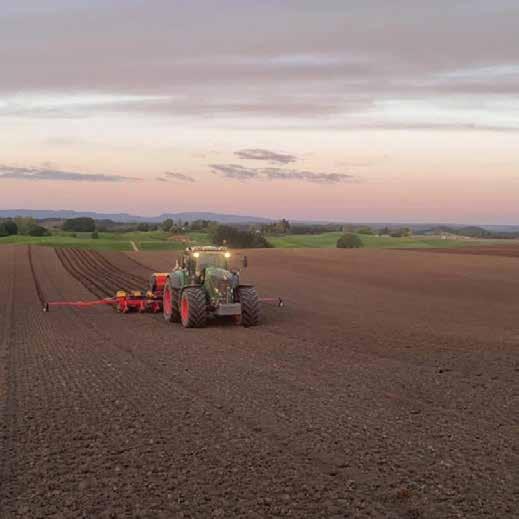

BY BRINGING IN YOUNG WORKERS STRAIGHT FROM SCHOOL, THE BUSINESS HELPS TRAIN THE CONTRACTORS OF TOMORROW.
mower, which allows grass to be merged into swaths straight behind the mower cutting down on extra passes.
Two Novacat A9 triple mowers, one fitted with conditioners, add further flexibility depending on crop and conditions.
At the front end, three Alpha Motion 301 frontmounted mowers give Chris and his team the ability to set up powerful combinations that cover wide working widths while maintaining a smooth, groundhugging cut.
For clients, that translates to faster mowing, less wheel traffic and tidy swaths ready for the chopper or wagons.
TEAMS KEEP WORK MOVING SMOOTHLY, NO MATTER THE CONDITIONS.
- which Chris prefers for their ability to handle off-road conditions.
“Mercedes because they get off road real good,” he says simply.
The trucks haul silage, palm kernel, metal and all manner of loads across the district.
Having his own trucks gives Chris more control over logistics and keeps the work flowing smoothly from paddock to pit.
The real backbone of Putt Contracting though, lies not just in the machines but in the people who keep them moving. Chris is joined by his three sons – Corey, Keegan and Jakob – each of whom has carved out a place in the business.
Corey, the 2nd eldest, has been with the business for twelve years, while Keegan, the
eldest, came across after an apprenticeship in engineering 10 years ago.
Jakob, the youngest, joined four years ago and quickly established himself as a capable operator and engineer in his own right. “It makes my life a lot easier,” Chris says. “They know what they’ve got to do. They just get on and do it.”
Alongside the family are a team of long-serving employees, bolstered each season by extra hands to cope with peak demand.
The mix of family and loyal staff has created a steady culture where everyone knows their role and the work gets done with a minimum of fuss.
On the forage wagon side, Chris has built up a fleet that gives him options across job sizes and conditions.
Loader wagons, including Torro and Jumbo models, form an important part of the silage operation.
Known for their capacity and robust build, these wagons ensure grass is shifted from paddock to pit quickly and efficiently. In a district where weather can turn fast, the ability to move bulk forage without delay is a big part of keeping customers happy.
The fleet is supported by a stable of trucks, mostly Mercedes
GEAR, STEADY HANDS – INVESTING IN NEW MACHINERY LIKE THE CLAAS 970 ENSURES THE BUSINESS STAYS EFFICIENT WHILE AVOIDING COSTLY DOWNTIME.

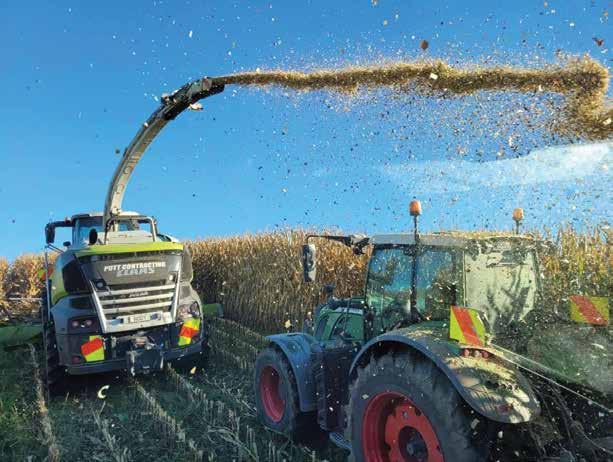

Engineering skills within the team mean much of the day-today maintenance and fabrication is done in-house.
Keegan’s background as an engineer, along with Jakob’s knack for mechanics ensures that breakdowns are often shortlived and custom jobs like trailer decks and cages can be built to suit the business’s needs.
That said, modern tractors, choppers and mowers come with computers and diagnostics that require dealer support and Chris is pragmatic about this. “For the tractors we always use Piako tractors in Morrinsville, which we find pretty good. Contractors today, you can’t do everything yourself.
Claas Harvest Centre do the chopper work and we just look after the easy stuff.” It’s a balance of in-house know-how and trusted dealer relationships that keeps the wheels turning. The scale of the business means that during peak season, nine to ten people are working full tilt.
Outside of family members,
MANY OF THE SAME CLIENTS HAVE WORKED WITH CHRIS FOR DECADES, A TESTAMENT TO TRUST AND CONSISTENCY.
names like Cody Cherry and Blake Littin join the roster along with younger recruits brought in straight from school. It’s a mix of experience and fresh energy that keeps the team humming along.
For Chris, bringing in young workers is as much about moulding the next generation as it is about filling a gap in the roster.
The work itself is typical of a Waikato contractor but no less demanding.
Maize silage, grass silage, cartage and general contracting jobs keep the team busy through spring and summer with the shoulder seasons filled with palm kernel cartage and other haulage.
The South Waikato provides enough work within a relatively tight radius that Chris doesn’t need to send machines far afield.
“Most of our work is Tokoroa

leaf counts MERGENTO VT
Clean forage without disintegration losses even with leafy crops such as clover or alfalfa
High pick-up performance and perfect crop transfer to the conveyor belt thanks to the six rows of controlled pick-up tines
Perfect crop flow along the pick-up thanks to the adjustable, damped crop swath roller with baffle curtain

and Putaruru, down Arapuni way. It’s quite close. I don’t see the point in travelling too far - that’s wasted time. If you’ve got enough work where you are, why would you?”
Farming clients in the district know Putt Contracting as a steady presence, someone who has turned up season after season. “I’ve worked for the same people for years and years,” Chris says.
That loyalty runs both ways, and it’s part of what has under-
pinned the business’s growth.
In a district where farming is still the bedrock of the local economy, contractors like Chris are integral to keeping things moving.
When asked what he enjoys most about the job, Chris is characteristically blunt. “Probably the smell of diesel to be fair,” he says with a laugh. “And as long as I’m outdoors doing something and contributing.”
That pragmatism sums up much of his approach – work
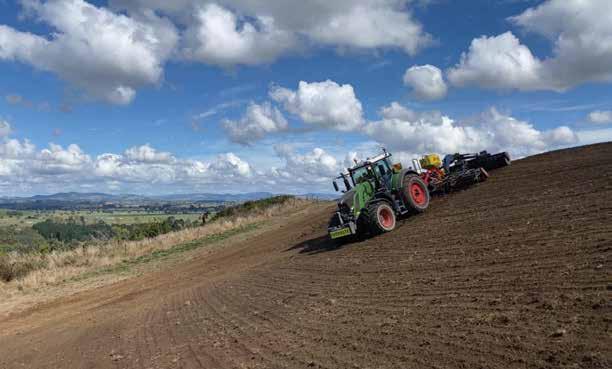

hard, keep the machines running and enjoy the satisfaction of a job done right.
Outside of work, fishing is his chosen escape with a particular fondness for chasing kingfish off the Waikato coast.
The business has weathered the ups and downs of contracting life.
There was a significant spendup pre-Covid, when new tractors and implements were added to the fleet to improve reliability and get through work faster. Another round of investment is happening now, with the
CHRIS PUTT’S LOYALTY TO FENDT TRACTORS REFLECTS YEARS OF RELIABLE SERVICE ACROSS SILAGE, CARTAGE AND CULTIVATION WORK.
new Claas 970 Jaguar chopper and Pöttinger mower line-up bolstering the operation.
The strategy is simple - keep the gear modern enough to stay efficient, but not so new that it creates unnecessary overheads.
Looking ahead, Chris sees the seasons as harder to predict.
Springs that once arrived reliably are now more variable, grass growth is patchy and frosts hang around longer.
“The seasons are all changing,” he says. “It seems like it’s reverting back to the old days, where it’s cold and frosty. You just don’t know until you’re
WITH NINE TRACTORS IN OPERATION, THE FLEET PROVIDES THE HORSEPOWER NEEDED TO KEEP SOUTH WAIKATO FARMS MOVING.
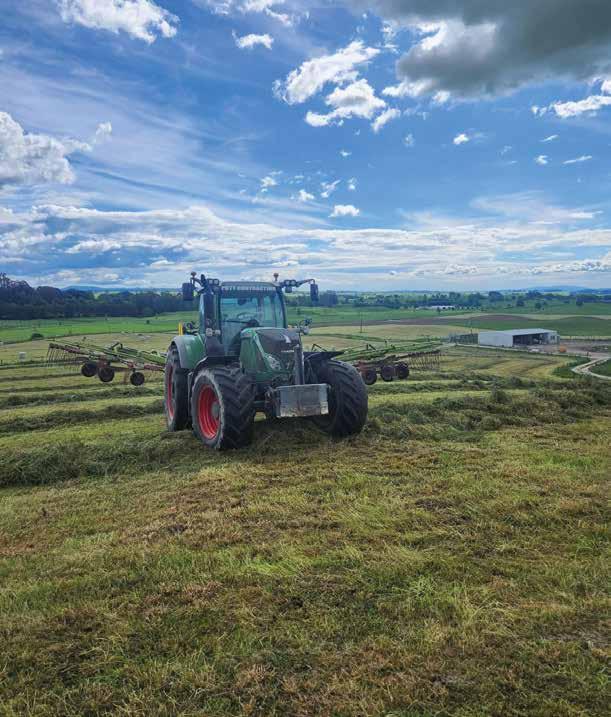

MERCEDES MUSCLE - THE COMPANY’S TRUCKS ARE RELIED UPON FOR CARTING SILAGE, PALM KERNEL AND METAL, CHOSEN FOR THEIR ABILITY TO HANDLE ALL CONDITIONS.
there.” It’s a reminder that contractors, like farmers, are at the mercy of the weather and success depends on being ready to move when the opportunity arises.
Beyond the nuts and bolts of machines and weather, Chris is
clear about the broader picture. Farming, he says, is vital to New Zealand. “It’s very important. They’re the only ones making money really for the country at the moment. Forestry is average, it’s up and down but dairy is always pretty steady.”
In his eyes, agriculture is still the backbone of the economy and contractors are an essential part of that chain.
Putt Contracting, is in many ways, a snapshot of the best of New Zealand’s rural contracting sector – a family business that has grown steadily, invested
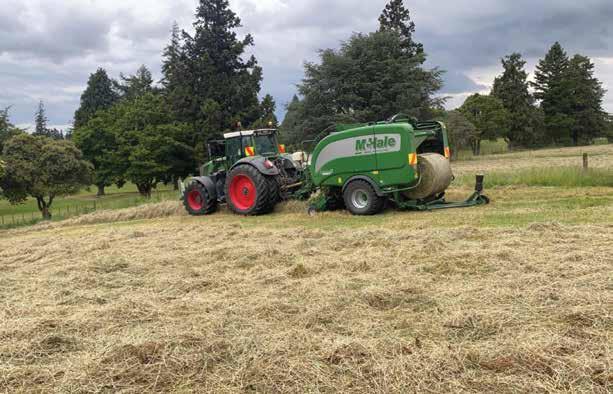
wisely and built strong local relationships. It has done so without fanfare, relying instead on the strength of its work and the loyalty of its people.
Whether it’s a Fendt 936 pulling hard in the paddock, a Claas Jaguar 970 swallowing rows of maize, or a Pöttinger mower combination laying down clean swaths ready for the pit, the machines are only part of the story.
The rest comes from the people who keep them moving and the communities they serve.
For Chris, the formula is sim-
PUTT CONTRACTING IS PART OF THE BACKBONE OF THE SOUTH WAIKATO, SUPPORTING FARMERS WHO KEEP THE LOCAL ECONOMY STRONG.
ple and enduring - keep it local, keep it reliable and keep it in the family.
And in the South Waikato, that’s been more than enough to turn one man’s truck into a thriving contracting business that shows no signs of slowing down.
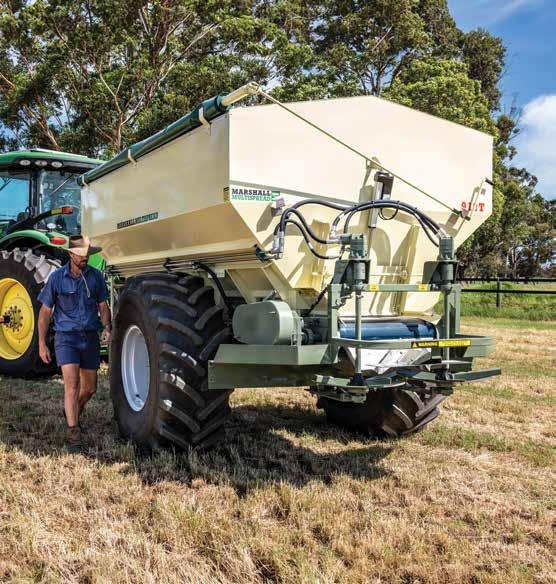
For over 40 years, Roesners have manufactured the all purpose Marshall Multispread,designed for Australian Agriculture.
The Marshall Multispread delivers proven performance and versatility with over 11000 units in the field across Australia, backed up by superior customer service and support.
Multispread machines are available with advanced features such as the D3 spinner system for accurate spread patterns up to 36m and the latest version 3 i4M spreader controller, launched in June 2025, including a new auto-calibration feature.
To discuss your fertiliser spreading requirements, call Roesners today to speak directly to our dedicated sales, spare parts and support team.

WITH TODAY’S HIGH FERTILISER COSTS AND GROWING PUBLIC CONCERN PUSHING US TO PROTECT THE ENVIRONMENT, CONTRACTORS AND FARMERS NEED SPREADERS THAT ARE SOPHISTICATED, ACCURATE AND DURABLE. IN THIS FEATURE LEADING MANUFACTURERS TELL US ABOUT THEIR LATEST PRODUCTS.
BERGMANN XPERT SPREADER
Bergmann has a proven track record in putting innovative ideas into practice and driving vital developments. Even under challenging conditions, Bergmann manure and universal spreaders always work reliably with proven quality and functionality, along with outstanding spreading precision. Last year Bergmann celebrated “70 years of spreaders”.
Bergmann will be presenting its new generation of spreaders of the Bergmann Xpert series at Agritechnica 2025. On display will be the Bergmann Xpert 6.34, the latest-generation, top of the range three-axle model, and the Bergmann Xpert 4.22, the largest tandem model with mechanical chassis.
At Agritechnica 2023, Bergmann already showed a demonstrator from the new Xpert series of spreaders to witness initial reactions of visitors at the stand.
General development objectives were defined at the beginning of the new development phase. These are now reflected in the models of the new Xpert series:
- Increase in performance
- Optimisation of work quality
- Increased resistance to wear and corrosion
- Reduction of cleaning workload, avoidance of dirt deposits
- Simplification of maintenance and servicing
- Increased safety and convenience
- EU type approval in category R (transport vehicles – road transport possible)
- Modern, uncluttered design
- Modularity across the entire series
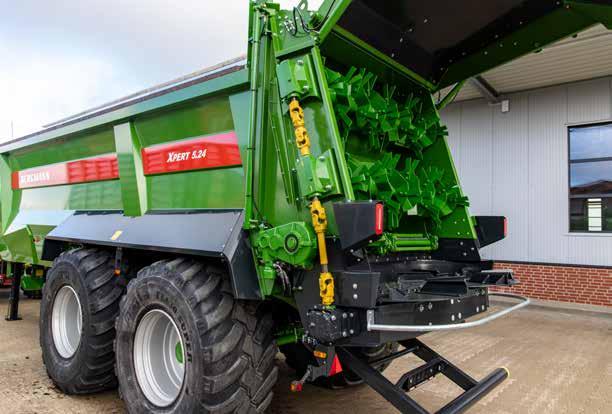

Explained below are a few examples of how these goals were implemented.
Among other factors, this objective was achieved through higher load volumes, increasing the milling unit passage to 1.55 m, 1.70 m and 1.90 m for higher throughput rates, along with practical cargo space lengths and load heights for faster and more uniform loading.
The patented V-Spread wide spreading unit with a disk diameter of 1,100 mm for larger working widths and fewer tram lines is also available as an option for all Xpert models.
The material feed point onto the spreader disks has been further optimised for an even more uniform spreading pattern and optimum lateral distribution.
Depending on the model, the diameter of the spreader disks of the standard T-Spread disk spreader unit has been retained (in models with 1,000 mm diam-
eter) or increased to 1,100 mm for even better spreading accuracy.
The entire body features high quality cathodic dip and powder surface coating. The floor of the bin is constructed of even more wear-resistant steel than the current models.
Seen from the front, the first thing you notice is the narrow drawbar of all models, which offers little room for dirt deposits and also significantly increases the manoeuvrability of the tractor-trailer combination.
The body of all models is completely self-supporting, does not require an additional subframe and is open at the bottom. The Xpert models are easily accessible from below and can be effortlessly cleaned after use. This design was until now not available on the market especially for spreaders with a gross vehicle weight of 18 t or more.
The mudguards are steeper
than on current models. They are also cathodic dip and powder coated which gives them a highly smooth finish. The mudguards thus reliably prevent larger deposits of material.
The contours of the sidewalls are also designed to avoid surfaces attracting material deposits.
The narrow LED lighting has been positioned above the spreader unit. This means falling material does not remain on or in front of the lamps. A further plus: this also increases road safety.
The round underride guard also offers little contact surface for material deposits.
To simplify maintenance, lubrication points have been sensibly grouped together and are accessible from just a few locations.
All Xpert models are equipped with a low-maintenance and smooth-running cardan drive as standard.
The hydraulic lines and cables are laid in a standardised, tidy and easily accessible way.

On all models, the control block is mounted on the right at the front in driving direction. Reliable LED lighting is fitted as standard for the Xpert series.
Increased safety and convenience
A completely new feature for spreaders is the ISOBUS-TIM option: trailer controls tractor. There are three different applications. Some of these applications can also be combined:
- TIM – SpeedControl: adjustment of the spread rate by varying the tractor driving speeds with a constant scraper floor speed (= constant spreading pattern)
- TIM – PTOControl: switching the PTO shaft on and off coupled with the scraper floor; PTO speed control to match the working width; automatic deactivation of the PTO if the spreader disks or beaters are blocked
- TIM – HydraulicControl: operation without control block via the control units of the tractor with an ISOBUS terminal
Another feature in terms of convenience is the electronic forced steering without a drawbar angle sensor. All you have to do is “Hitch and go”.
Adapting cylinders or steering rods (as is the case with conventional hydraulic or electronic forced steering systems) is not necessary because no additional elements are installed. This also increases the manoeuvrability of the tractor-trailer combination.
A removable storage box can be selected as an option, which is located at the front on the left in driving direction. This box can be used to store wear parts, tools etc. to secure these parts from lying loose in the tractor cabin.
The access ladder has also been redesigned to be more ergonomic. The ladder is set at an angle when folded out for use. This means the user climbs up like a ladder leaning on a wall or railing and not vertically, as is usually the case. This makes climbing up safer.
All Xpert models are designed to have a significantly higher tongue load than the current models. This provides the driver with more driving comfort and the transmission of tractive force is even better.
Liquid Systems (SA) has been at the forefront of liquid application technology for Australian farmers for over two decades. In early 2025, the company launched its latest Liquid Ready Kits for John Deere’s C-Series Air Carts.
In July 2025, Liquid Systems unveiled a bolt-on LQS P600 4000 L Liquid Bridge for John Deere’s P600 Precision Air Hoe Drills.
When paired with a John Deere C-Series Liquid Cart, the new Liquid Bridge is the perfect match—boosting liquid capacity of the C650 from 4800 L to 8800 L, and the C500/550 from 3720 L to 7720 L. That means longer
runs, fewer refills, and uncompromised precision.
Farmers can choose from two options:
- Tank-only Bridge – increases the liquid capacity of C-Series Air Carts.
- Tank Bridge + LQS120 Module – transforms a non-liquid cart into a liquid-ready bar configuration, with the added ability to apply dual, separate liquids alongside a liquid cart.
Designed to match the current hub capacity of the P600 Drill, the 4000 L Liquid Bridge mounts directly to the P660, P670, P680, and P690 chassis, integrating seamlessly with John Deere’s dealer-fit C-Series carts.
Looking ahead, larger hub capacities from John Deere will open the door to a 6000 L solution—an ideal fit for Western

Australia’s high-demand cropping regions.
With a reputation for build quality, reliability, and exceptional support, Liquid Systems continues to deliver turnkey equipment that helps Australian farmers work smarter, faster, and more efficiently.
The benefits of in-furrow liquid application are clear: targeted
nutrient placement, improved germination, and maximised input efficiency. With Liquid Systems’ precision technology, nutrients are placed accurately at seeding—optimising efficiency, protecting soil health, and boosting yield potential. Call (08) 8357 4437 or visit www.liquidsystems.com.au to find your nearest dealer.

EU type approval in category R
All Xpert models are certified as standard with full EU type approval in category R in accordance with the official regulation. The CoC (Certificate of Conformity) documents are also supplied. Especially when reselling within the EU, type approval is an advantage, as it removes the need for individual national approvals.
All these new features have been packaged in a standardised, modern and uncluttered design, thus clearly setting Bergmann apart from the competition.
The result of the development
work is the new Bergmann Xpert series made up of nine models and six sizes with a gross weight of between 12,000 and 34,000 kg.
The most compact model is the single-axle Bergmann Xpert 1.13. This is followed by seven tandem models with a gross weight of 13,000 to 24,000 kg. The Bergmann Xpert 6.34 with tridem chassis and 34,000 kg gross weight is the largest spreader in the new series.
We have also removed the distinction between manure spreaders and universal spreaders. Customers can choose between the standard T-Spread
disk spreader unit and the optional V-Spread wide spreading unit for working widths of up to 36 m (depending on the material) and the 2-Spread hybrid spreader unit with two vertical beaters for precise distribution at maximum throughput.
The Xpert spreaders have also been further developed in terms of tyres. The single-axle vehicle is available with a maximum tyre size of 800/45 R30.5. The XPERT 1.14, 2.16 and 3.18 models can be fitted with a maximum tyre size of 710/50 R26.5.
Tyre sizes up to 800/45 R30.5 are available for the Xpert 3.22,
4.22 and 4.24. The two top models Xpert 5.24 and 6.34 can even be ordered with the maximum size 750/60 R30.5.
The first demonstrator went into operation in the spring of 2023. Since then, further demonstrators and prototypes of various sizes have been intensively put to the test in the field by end customers in Germany and abroad.
The first vehicles from the Bergmann Xpert 4.22, 4.24 and 5.24 zero series were shipped to end customers in summer 2025. The zero series of all other sizes are to be rolled out by summer 2026.
When you see the majority of truck spreading contractors using a single brand you know they must be doing something right. Southern Spreaders in Ballarat are the brand trusted by contractors and high-end users to supply a product that performs every day, in all conditions and all materials.
From their Ballarat headquarters, Southern Spreaders design and build commercial
spreaders that are ready to hit the paddock the moment they leave the factory.
Every spreader body is built entirely in-house — engineered, fabricated, and fitted with precision to deliver a complete turnkey solution.
Whether you bring your own truck or want Southern Spreaders to supply the cab-chassis, they’ll handle everything from setup to finish. Customers can specify brand, load capacity, wheel and tyre options, tow bars, GPS and autosteer systems, section control, load cells, onboard
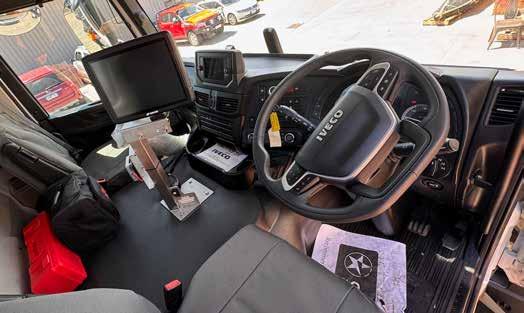

inflation, toolboxes, and more — creating a seamless, high-performance unit built exactly to spec.
“Every operator has different needs and Southern Spreaders understand that no two spreading businesses are alike. Southern Spreaders engineering team customises each build to suit terrain, regional conditions, preferred materials, and existing fleet configurations.” said Southern Spreaders General Manager Jarrod Keyte.
“From single-unit contractors to large-scale fleets, every truck represents decade of spreader
experience combined with the latest technology and design features to maximise accuracy and efficiency for the end users” said Jarrod.
Jarrod says the proof is in the paddock: “We’ve seen contractors start with one truck and grow to fleets of more than a dozen — all running Southern Spreaders gear. Some of our first units, built over 20 years ago, are still in daily operation. The only reason for replacement is usually new technology or truck age.
Jarrod added “We back every spreader with parts supply and


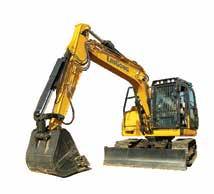
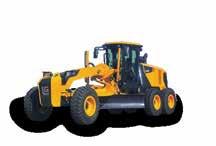



THE MULTI-PURPOSE
Precision application of inoculant solution for high-quality silage Liquido F is the newly developed, versatile front silage additive tank from Pottinger. It can be used easily and flexibly in combination with a wide variety of different brands of loader wagons and balers. The nozzle header is positioned between the pick-up and the rotor, where it applies the lactic acid bacteria solution directly and homogeneously to the flow of forage to produce high-quality silage. The application rate is matched to the flow of forage and the farms requirements. The Liquido F can also be used as a front bumper and as front ballast. Maximum utilisation of this versatile and cost-effective unit is
a given because it covers such a wide range of different applications.
The silage additive tank is available in two versions: Liquido F 2000 and Liquido F 3000 The Liquido F 2000 has an application rate of 40 l/h to 245 l/h, while the premium Liquido F 3000 can be expanded to achieve up to 470 l/h by adding two more nozzles. A digital flowmeter measures the application flowrate in litres per hour. The flowrate can be easily adjusted using the + 10 % / - 10 % button.
On the Liquido F 3000, the flowmeter regulates the application rate automatically according to the defined target rate and the current operating conditions. It switches on the two additional nozzles automatically when required.

The way the application rate is to be controlled is selected before each job: It can be switched on and off manually at the touch of a button, or automatically according to the position of the pick-up: it switches off when the pick-up is lifted so that no silage additive goes to waste.
An additional option on the premium Liquido F 3000 model controls the application rate according to the driving speed: the higher the speed, the more
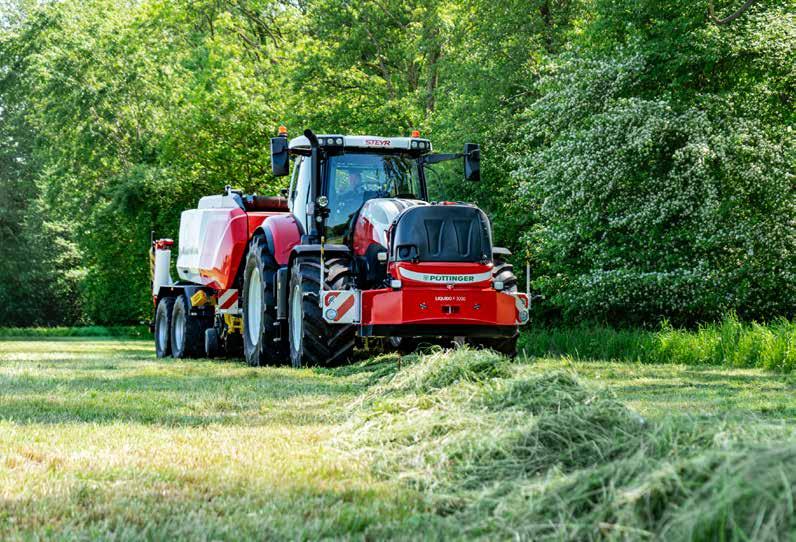
support. For parts help is just a phone call away. If you call by midday the parts will be on a courier that day giving our clients total peace of mind. And our engineering and design team is in-house, if you’ve got an issue you can speak to the team who designed and built the spreader” Southern Spreaders also pro-
duce complementary equipment like self-loading trailers, helping operators move more product, more efficiently.
Southern Spreaders approach is grounded in three simple principles:
Quality – Reliability, strength, and straightforward functionality built into every unit.
Service – Rapid, dependable backup to minimise downtime. Innovation – Continual improvement and the latest technology to keep operators ahead of the game.
With over 30 years building spreaders and more than three decades in fertiliser spreading themselves, Southern Spreaders
silage additive is applied to the flow of forage.
The Liquido F has three tanks for quick and easy handling. The main tank, the fresh water tank, and a hand washing tank enable several work steps at once, from mixing to filling and hand rinsing. The main tank has a standard size of 200 litres, but is also available in a 400-litre version.
Cleaning the tank, the supply lines and the nozzles is also extremely easy with this ingenious concept.
Thanks to the fresh water tank (the LIQUIDO F 3000 even has an integrated cleaning nozzle), the cleaning process is completed in just a few steps, so the Liquido F is soon ready for its next job.
Other practical features that round off this versatile unit include a level indicator, jaw hitch, and toolbox.
Work area lights and storage rollers are available as options. When used as a front bumper, the Liquido F enhances safety on the road with its clearly visible lighting. Its width can be adjusted between 2.55 and 2.85 m, and it can also be used as front ballast. Fulfilling a versatile range of applications, the multi- purpose Liquido F from Pöttinger is perfect for farms of all sizes.
understand the demands of the job.
Southern Spreaders are driven by engineering excellence, smart design, and the belief that staying innovative keeps Australian agriculture moving forward.
Find out more or enquire about a new build at www.southernspreaders.com.au.
KUBOTA GEOSPREAD
DSXL-W
Among Kubota’s flagship implements, the GeoSpread DSXL-W stands as a benchmark in precision fertiliser spreading. Sitting at the top of Kubota’s disc spreader range, it combines intelligent automation, rugged engineering, and high-speed capability to deliver exceptional coverage and control across large-scale operations.
The DSXL-W is designed for performance in every sense —
wide 45-metre spread widths, high-volume output, and accuracy that doesn’t waver no matter the forward speed or terrain. Its ISOBUS compatibility enables seamless section control and true variable rate spreading, adjusting output in 1-metre increments to eliminate overlap and waste.
At the heart of every Kubota spreader is the RotoFlow system, a hallmark of the range and a key reason for its unmatched spreading consistency.
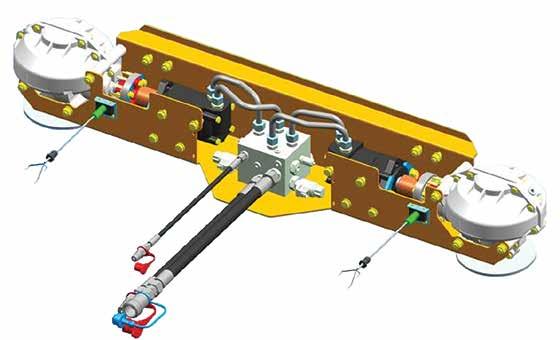
Product Manager Mark Allott explains:
“RotoFlow accelerates granules smoothly without breaking them apart. Rather than drop -
ping fertiliser straight onto the vanes, it introduces each particle into a central cylinder, where it gently rotates before being released at a precise point on
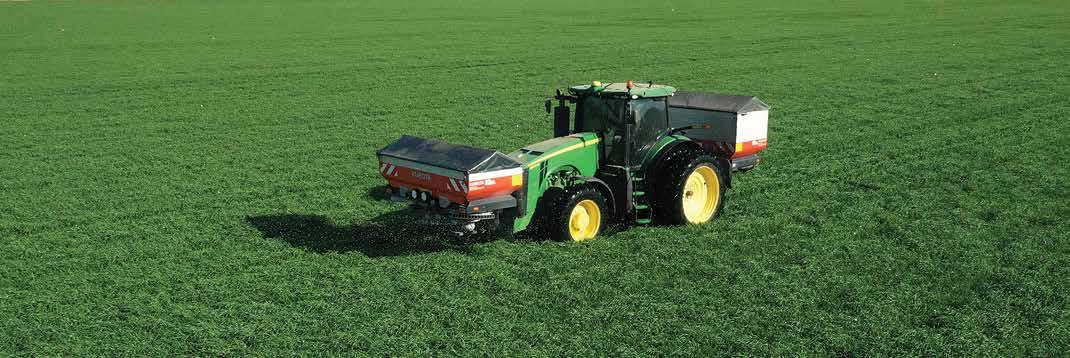
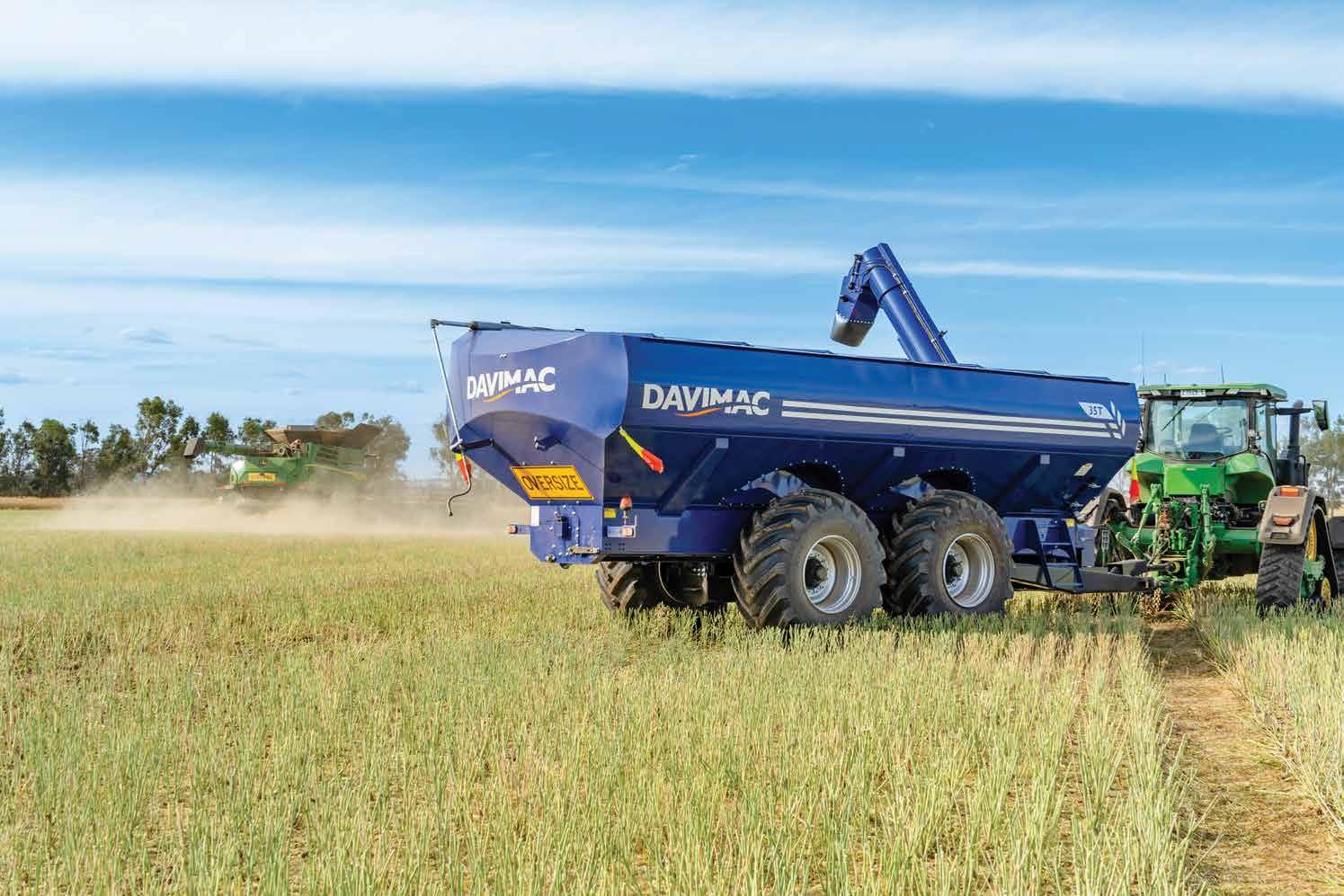

It’s been almost a year since Precision Agronomics Australia (PAA) rolled out the Version 3 i4M fertiliser spreader controller, and the results have confirmed why this system has become a benchmark in variable-rate technology.
Building on the success of the original i4M controller launched in 2017, Version 3 has taken the platform to new levels of precision and usability. Farmers across Australia have embraced it as a practical, cost-effective way to achieve accurate variable-rate application, auto-shutoff, and detailed coverage mapping — all from a robust Android-based control system.
One of the standout advancements in Version 3 is its dynamic calibration system. Using highspeed feedback from loadcells mounted on the spreader, the controller now performs continuous, on-the-go calibration. Each loadcell module captures rapid weight readings and transmits them instantly to the main control unit. When changes occur in fertiliser density or moisture content, the controller detects the variation and automatically adjusts the calibration factor in real time. Instead of discovering a rate error after finishing a load, the system self-corrects immediately — ensuring consistent, precise application across every pass.
At the heart of the i4M system is the Android mobile app, redesigned from the ground up for
the disc. That’s how we maintain both distance and accuracy — every granule follows the same flight path.”
Each RotoFlow disc features eight vanes — double or even quadruple what’s found on many competing machines — ensuring a dense, uniform spread pattern right across the working width. Kubota’s engineering refinements to the DSXL-W include deeper, higher-capacity vanes that allow the spreader to handle greater volumes at faster speeds.
Version 3. The updated interface features smoother coverage mapping, improved auto shut-off accuracy, and intuitive, icon-driven menus that streamline operation. PAA’s engineers also rebuilt the mapping engine to deliver faster rendering speeds, even with complex prescription maps — a must for high-productivity operators spreading a mix of granular and non-granular materials.
The app also allows users to export coverage maps for integration with third-party precision agriculture software, supporting as-applied data analysis and compliance reporting.
Another popular feature is the belt slip sensor integration, designed for spreaders with conveyor systems. This sensor alerts the operator if the conveyor belt begins slipping under load — preventing under-application and maintaining consistent spread rates.
The Version 3 controller was the result of two years of field testing and refinement, and it’s now widely available both as factory fitment on new spreaders and as a retrofit upgrade for existing Version 1 and Version 2 i4M systems.
With Version 3, PAA has cemented its position as a leader in smart, adaptable control technology — helping Australian growers get more from every hectare through real-time precision, automation, and reliability.
For further details, contact Precision Agronomics Australia on +61 8 9072 0542 or visit i4M.net. au.



The result? Operators can now apply urea at 500 kg/ha over 36 m while travelling at 11–12 kph, compared to the 7 kph typical of standard models.
That increased efficiency makes the DSXL-W particularly well suited for high-demand applications like cotton or broadacre cereal production, where speed and precision translate directly into productivity.
Available in hopper capacities from 1875 L up to 4575 L, the DSXL-W series offers working
widths between 24 m and 45 m. It shares its proven GeoSpread technology with the DSM-W and DSX-W models, which provide different capacity and width options but retain the same ISOBUS control, weigh-cell accuracy, and section-by-section management.
Kubota’s MultiRate spreading system further refines control. Both discs can vary application rates independently according to prescription maps — so one side can halve its dosage while the other maintains a higher
rate, perfectly matching in-field nutrient requirements in real time.
And for those chasing maximum coverage, GeoSpread spreaders can be operated in tandem — one front-mounted, one rear-mounted — to double output without compromising precision.
The Kubota GeoSpread DSXL-W remains a cornerstone of professional spreading: fast, intelligent, and engineered for farmers who demand total accuracy, every pass, every paddock. ]
The AgriSpread AS2000 Series is an industry-leading, advanced precision spreader that meets the requirements of capacity, simplicity, and durability to take your spreading program to the next level.
Spreading a wide range of materials including fertiliser, lime and gypsum, with exclusive design features and technology for precise product application, the AS2000 is exceptionally accurate whilst being simple to operate. The AS2000 is accredited to spread urea to 41m and lime to 15m, with interchangeable lime and fertiliser discs, and is available in single or tandem axle in capacities up to 22m3.
The AS2000 is equipped with AgriSpread’s exclusive Variable Rate Technology (VRT) as standard. This provides on-the-goweighing through the ISOBUS terminal for accurately spreading variable bulk density products, utilising load sense hydraulics, dynamic auto-calibration and a pre-planned map to optimise product usage across paddocks with variable soils and crop nutrition. The ISOBUS interface implements this precision map to automatically control the application rate with GPS positioning.
The AS2000 has an adjustable rear spinner deck system to maintain even product spread. The spreading deck has forward and backward positioning, with two vane adjustable spinners, short and long, for controlling the placement of product. Spinner speeds are set from the cab
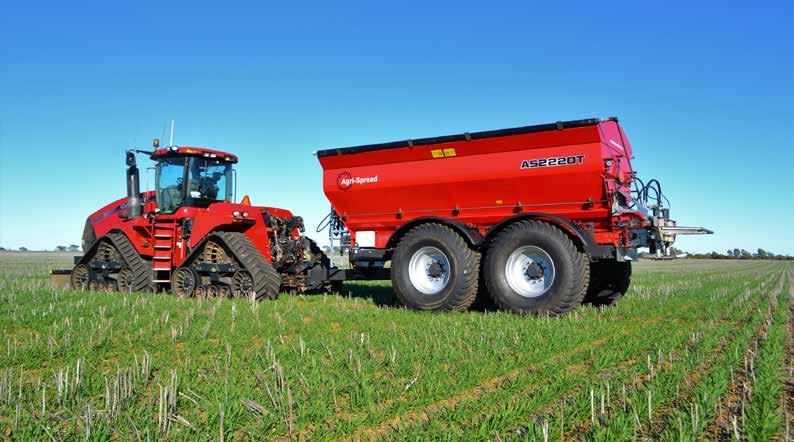
based on product being applied and spread width required, allowing operators to set the spread width with the deck and pattern distribution with the vanes.
Based on the area to be spread, the AgriSpread VT Controller continually fine tunes the flow rate of the product onto the discs to ensure the highest level of accuracy. Data is also collected to provide a detailed record of the applied product – how much was applied and where.
AS2000 spreaders can also be factory optioned with sectional control, which uses GPS map data to feed material onto independently controlled hydraulic spinners. This allows the spreading rate of the machine to be changed to minimise product overlap, with load cells built into the mechanical design and ISOBUS software interface included for in-cab diagnostics and monitoring of the conveyor and spinners.
Additional options on the AS2000 Spreader include a 3m
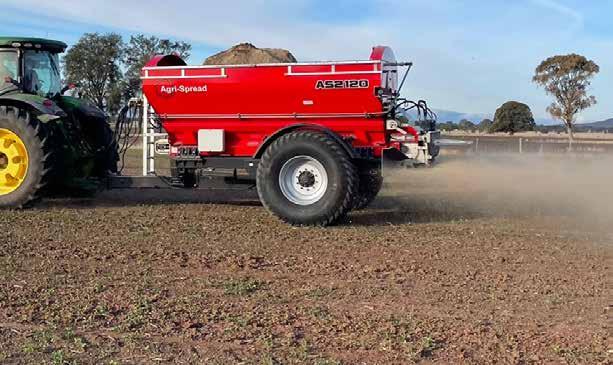
wheel axle system option, single narrow 480/80R50 tyres for high ground clearance, 304 full stainless-steel bin, and hydraulic folding curtains to spread low density products in difficult conditions without compromising spread width or distribution accuracy. Border Control is also available as an option to independently control spinner speeds for boundary spreading to reduce wastage and overthrow.
Waringa Distribution is the
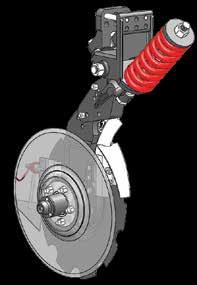
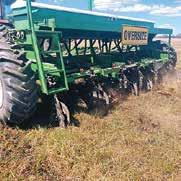
proud distributor of AgriSpread’s precision spreading equipment across Australia and New Zealand and plays a key role in the continual testing and development of the AS2000 in unique Australian conditions, to ensure customer expectations are exceeded. The AS2000 is available through Waringa’s extensive national dealer network of over 60 dealers. Visit waringa.com.au to locate your nearest dealer and for product information.
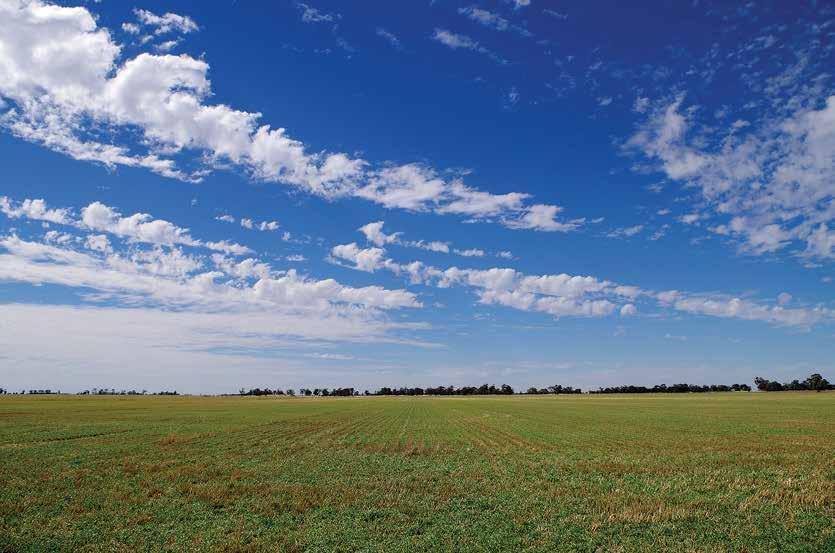





Across Australia, grain producers are giving renewed attention to lime and gypsum application as they maximise yield potential. Hansa Spreaders are built precisely for that — delivering accurate, reliable application across all material types, from lime and urea to seed.
For nearly 30 years, Hansa has been designing and manufacturing professional-grade spreaders that make versatility and accuracy effortless for both contractors and farmers. National Sales and Marketing director Ashley Dinning explains:
“Hansa spreaders are built for people who demand precision and flexibility as they’ll handle several materials in a single day. They need equipment that can switch products in minutes and still spread each one accurately and evenly. That’s why Hansa spreaders are engineered to handle all materials and last the distance — with stainless steel bins and the best components available.”
One feature that truly sets Hansa apart is its floor chain conveyor system, used across both trailing and linkage models. While other spreaders rely on belts, Hansa’s chain feed
ensures a consistent, positive flow to the spinners — regardless of material type, slope, or moisture content.
“Accurate spreading starts with consistent feed,” says Ashley. “Chains give you positive, gear-driven delivery every time — not friction or slippage.”
Hansa’s floor chain design offers clear, practical advantages:
- Fully enclosed floors that contain all material types
- Direct gear drive with no friction losses or slippage
- Fewer moving parts for simpler servicing — sections replaced in minutes, not days
- Lower long-term maintenance than commonly assumed
The result is operators spreading lime or gypsum can work with confidence, knowing their equipment will maintain precision even in variable paddock conditions.
This is aided by a smooth internal bin structure, without areas to impede flow of material to the spinners. “Check any other spreader brand in the market, you’ll see the Hansa bin structure is designed to ensure smooth accurate flow of all materials in all conditions” said Ashley. “It’s such an easy comparison to make, but the simplicity of the inside of Hansa bin ensure3s

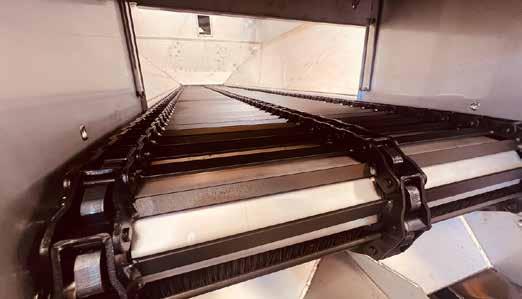
easy flow in all materials.”
Hansa’s pursuit of accuracy goes beyond engineering. The company has begun challenging an outdated industry benchmark — the 25% Coefficient of Variation (CoV) long accepted for lime spreading.
“That might have been acceptable ten or fifteen years ago,but not in an era when soil pH and precision farming are front and centre. We believe 10–15% should be the new standard for these materials” said Ashley.
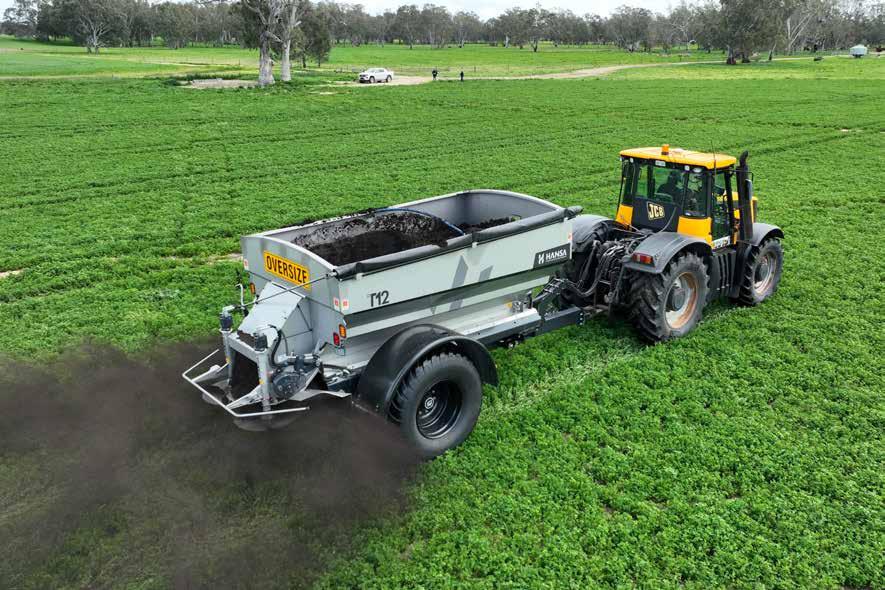
To illustrate:
- A 25% CoV can mean lime rates ranging from 1.8 to 3.8 t/ha — more than double the intended application.
- A 15% CoV tightens the spread significantly.
- At 10%, delivery becomes almost linear — the level of precision modern farming demands.
It’s more than numbers. CoV directly affects nutrient balance, soil correction, and ultimately, yield performance.
Hansa’s in-field testing shows that a triangular spread pattern delivers the most consistent results.
Unlike the flat, square patterns of many competitors, Hansa’s design lets operators narrow their bout width to improve CoV further — achieving superior accuracy in real-world conditions.
“We build our spreaders for how farmers actually work — not for lab conditions,” Ashley concludes. “Accuracy, durability, and simplicity are what matter. When you’re spreading lime, every tonne counts.”
For primary producers looking for accuracy in all materials, the flexibility to deliver all products precisely and the ability to swap between materials quickly and easily Hansa is the answer. Best of all they’re Australian designed, built and backed.
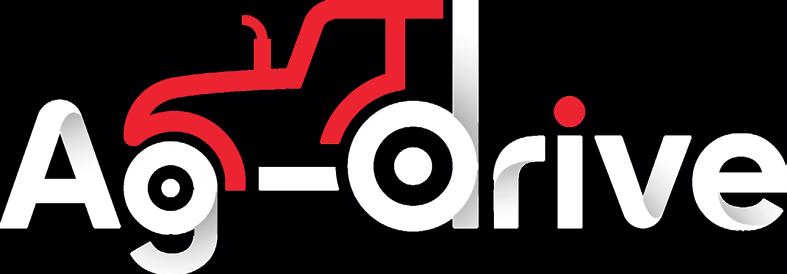
No more lost jobs, missing timesheets, or late invoices.
Ag-drive streamlines your business!
Built for ag contractors, by contractors.
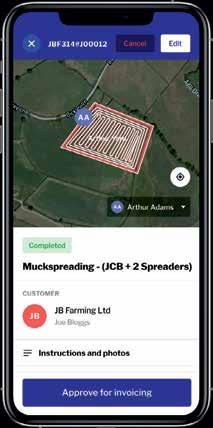
Record every job on the go – no more paper diaries.
Invoice faster and get paid quicker.
Schedule work, track operators, map fields, and manage H&S in one app.
GPS-tagged clock in/out timesheets. Customisable to suit your business.






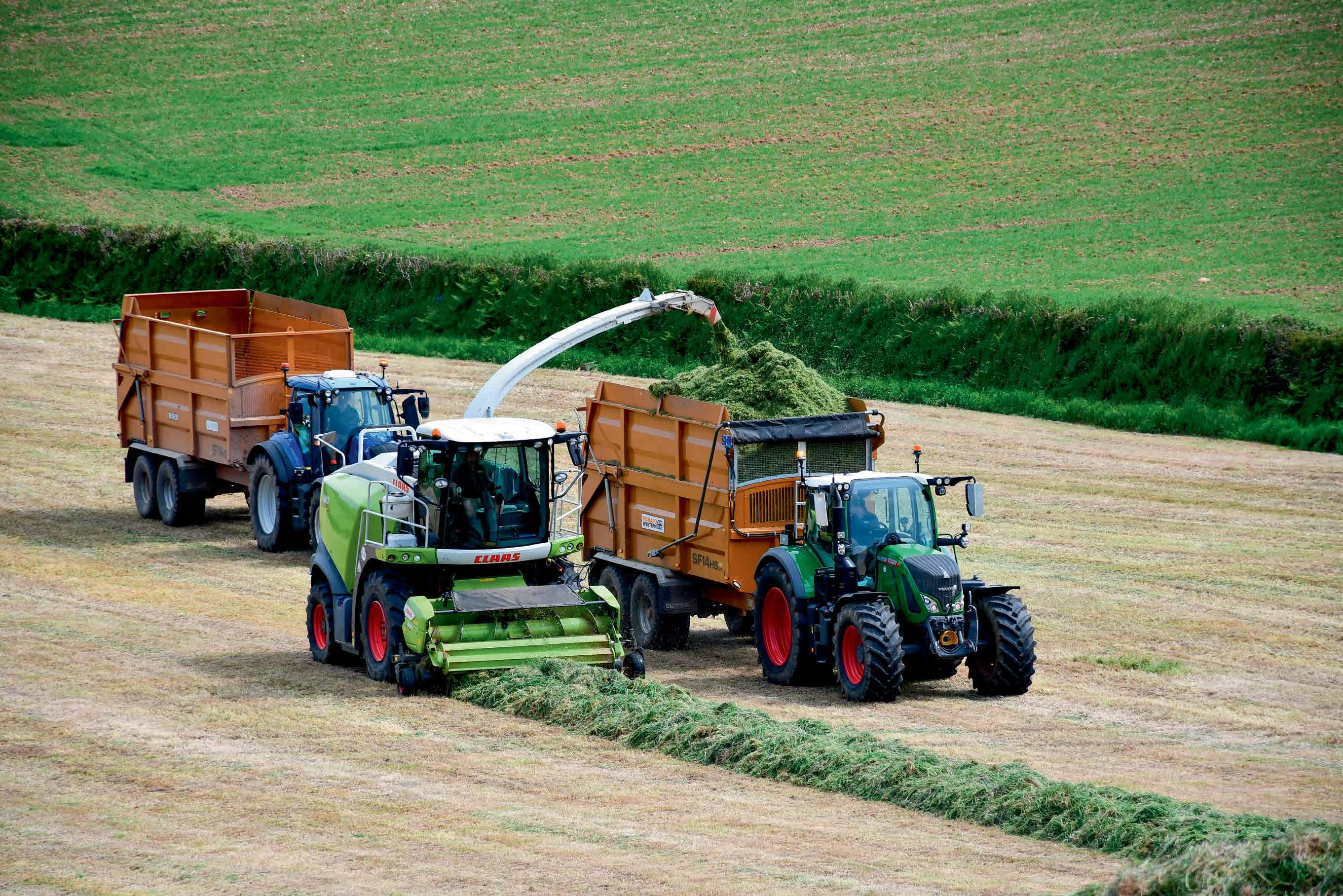

THE GRAIN HARVEST IS A VITAL PART OF THE AUSTRALIAN AGRICULTURAL INDUSTRY. IN THIS FEATURE WE LOOK AT LEADING COMBINE HARVESTERS, FRONTS, CHASER BINS AND OTHER TECHNOLOGY AVAILABLE TO AUSTRALIAN CONTRACTORS AND FARMERS.
CLAAS LEXION – MORE THAN EVER BEFORE
Agritechnica, the Northern Hemisphere’s premium agricultural event, is the platform Claas is using to launch new innovations to its premium combine harvester range.
Claas Lexion, Australia’s favourite Claas combine harvester – is getting more! In addition to further improving performance, the focus of their improvements is primarily on operator performance and comfort.
With its combine harvesters, Claas has been a world leader in grain harvesting for decades. Lexion sets the standard in self-learning machine optimisation and driver assistance.
For 2026, Claas has introduced new sales bundles to make it more cost-effective for customers to purchase this technology.
The available functionalities are bundled into three Cemos packages:
- Cemos Auto for 10 percent throughput capacity, signif-
icant learning effects and noticeably more driving comfort thanks to dialogue-based optimisation, automatic regulation of the forward speed and automatic crop flow monitoring. The menu-guided loss sensor calibration is unique on the market.
- Cemos Auto Plus for up to 20 percent performance optimisation and automatic optimisation of residual grain separation, cleaning and digital sweep control.
- Cemos Auto Professional for
more than 20 percent more output, including automatic setting of the threshing unit and camera-based, permanent optical monitoring, analysis and optimisation for maximum machine throughput with the best grain quality and minimum trash.
Claas Lexion Product Business Manager, Steve Reeves, says, “Cemos Auto Professional will be part of the Australian AUS PRO specification for 2026. With a high uptake rate in Australia for Cemos Auto, our Lexion owners and operators are proving the


benefit of more output in Australian conditions. With such an attractive purchase price, Steve expects to see 100% of new Lexions equipped with the full Cemos Auto Professional bundle moving forward”.
Steve says “Claas have also focused on comfort in the cab, with numerous new features, such as the Apple CarPlay radio, additional storage compartments and the blow gun, further enhancing the in-cab experience when working for long periods”.
- Apple CarPlay and Android Auto 6.756.75-inch touch display.
- A compressed air blow gun with a 2-metre-long spiralled hose is also available for quick and easy cleaning of fittings and the cab floor.
- Thanks to new interior lighting in the cab, working in the evening and at night is even safer and more pleasant. New storage compartments in the left-hand B pillar offer additional storage options.
From the outside, all Lexion models from the 2026 model year are recognisable by new LED rotating lamps and new rear lamps with a modern look, which also ensure greater safety in the field and on the road.
To improve performance, Claas have made MAN engines standard throughout the Lexion 8000 series.
Steve says, “from the 2026 model year, the Lexion 8000 series will now comprise of five performance classes in both wheel and Terra Trac versions, giving customers more flexible options for their operation”
The new Lexion 7700/7700 Terra Trac and Lexion 7600/7600 Terra Trac are new entry-level models in the Lexion hybrid series. These machines feature the New MAN D26 six-cylinder engine with a displacement of 12.4 litres at 549 hp and 507 hp respectively. As well as Dynamic Power and Dynamic Cooling – these new standard body Lexion join the 8700 and 8600 models that were updated in 2025 to be equipped with the MAN D38 six-cylinder engine with a displacement of 15.2 litres. The rated output is 646 and 598 hp, respectively.
“These next-generation MAN D26 and D38 engines impress even more with their strong and stable torque and fuel efficiency, running at Tier 3 emission levels. These new engines do not require the use of Ad-Blue”.
“From 2026 all Lexion models in our Australian market - from the 8800 to 7600 - will run MAN engines and that is a real advantage for us as they are proven to perform exceptionally well here”, he says.
In terms of threshing and separation all Australian 8000 &
7000 models work with the APS Synflow Hybrid system. The 8000 series have a feed channel width of 1,700 mm, three drums, a 755 mm threshing drum and two axial rotors that are 445 mm in diameter and 4,200 mm long.
The Lexion 8600/8600 Terra Trac to Lexion 8800 Terra Trac models offer separation performance from six rotor concaves and a maximum rotor speed of 1,200 rpm.
In Australia, the Lexion 8600/8600 Terra Trac will be available with the largest grain tank in its class.
“Claas have delivered in response to numerous customer requests”.
“These machines can now be supplied with either a 15,000 or 18,000 litre grain tank volume, giving the Lexion variable grain tank volumes”, he says.
Claas is setting the Australian market up for success in the 2026 Harvest season.
When you purchase a Claas Lexion from the Claas Harvest Centre, you are not just purchasing a piece of equipment, you are purchasing an experience.
After we have handed over the keys, we send a Claas expert to your farm to optimise your machine for your paddock, your crops, and your harvest. And over the first few seasons, an expert is back in the field with you, fine-tuning performance so your combine doesn’t just run— it runs at its absolute best.
Other combines may come with support, but it’s a partnership with us. Backed by quickly-accessible parts, reliable servicing, and technology that adapts instantly to changing conditions. You can trust that when harvest is on the line, we’ll be there to make sure you finish the job.
“When we sell a machine to a customer, the relationship does not end at the point of sale. For our teams, this is just the beginning of a through-life relation-
ship where our focus is on the value the machine adds to our customer’s business” says Richard Wilson, Chief Executive.
A team of ten optimisation specialists and demonstration drivers from around the world, experts in their field, are working within our business and with our Claas Combine customers. Customers completing an optimisation get one-to-one specialist in cab assistance with harvesting their crop, whilst being educated on peak operational performance of their Combine’s advanced features. The optimisation team will test for grain loss at header, analyse throughput of the machine, and maximise the grain sample in the tank.
“Our goal is to support our customers to be successful, which means not only selling them world-leading products but providing them with support and training to get the full benefit of this purchase, including early preparation with parts and service that maximises their harvest up-time,” says Richard.
The optimisation specialists spend nine months of the year travelling the world carrying out optimisations. They are exposed to a wide variety of crops and conditions, which helps build their knowledge and address the specific needs of Claas Combine customers. In turn, the optimisation drivers identify local farmers’ needs and practices, which are provided back to Claas in a two-way feedback loop, ensuring ongoing product research and development.
Claas Lexion Product Business Manager, Steve Reeves says “our optimisation drivers have completed optimisations in Romania, Bulgaria, Latvia, Lithuania, Estonia, Germany, Canada, UK, Australia and New Zealand”.
“If a customer in Australia is having challenges with their machine in a specific crop, chances are that the specialists have encountered this scenario before and can apply those learnings to the customer”.
For arable farmers, harvest is the culmination of the years’ hard work. It’s a critical makeor-break time for our customers, and they need their machines to perform at their best.
“Combine harvesters are machines that are not driven all year round, and it’s understandable that both the machine
Midwest Fabrication has stock on hand and ready to ship across Australia today. For farmers preparing for the upcoming harvest season, this immediate availability means you can secure the right platform for your operation now, with confidence that it will arrive when you need it.
“We design and manufacture right here in Australia, which means we’re never held hostage by international shipping delays or production backlogs,” explains Amy Schutt, CEO of Midwest Fabrication.
Stock available now across the full range
With platforms ranging from 30ft through to the industry-leading 60ft models, Midwest has stock ready for the harvest season. Whether you’re running a smaller operation in Queensland or covering massive acreage in Western Australia,
there’s a Midwest platform in stock to match your requirements.
This immediate availability extends beyond just the platforms themselves. Midwest maintains comprehensive parts inventory, ensuring dealers and customers have access to genuine components when they need them, not weeks later when the harvest window has closed.
The Australian-made advantage goes beyond availability
Being the only Australian-owned and operated harvest platform manufacturer isn’t just about patriotic pride, it delivers tangible benefits that impact your bottom line during the critical harvest period.
When your machine needs support, you’re calling our local team, not an offshore service department working different hours in a different timezone.
“The speed to help people is so fast,” Amy notes. “Customers literally pick up the phone and chat directly with our service guys
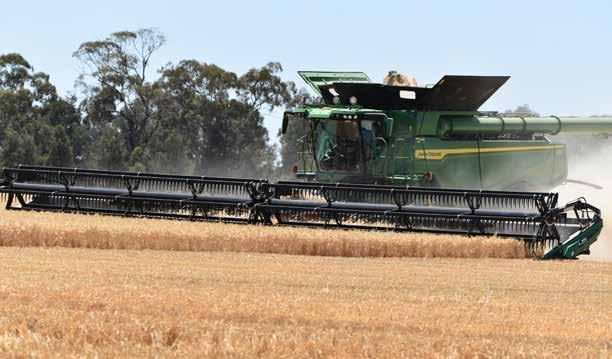
and its operators can be a little rusty”. After completing our customer optimisations we consistently see less grain loss than our competitors’, he says.
The optimisation specialists work with the customer to understand what is important to their business. Whether that is throughput, quality of their grain, understanding grain losses, exploring crop types, or how to utilise the advanced features of their machine.
”The technology Claas has released in their combine har-
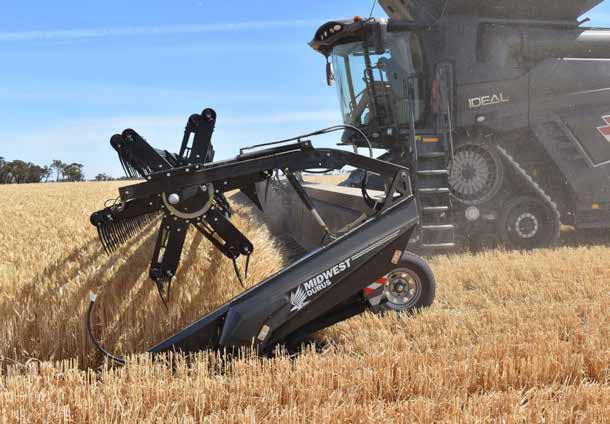
who are right here, on site.”
Consider the real cost of downtime during harvest. Between lost productivity, weather risk, and operational expenses, every hour a combine sits idle is expensive. When you’re waiting for a service technician to arrive or for parts to be expressshipped from interstate, those hours add up devastatingly fast. Having a machine that experiences fewer breakdowns, with a service team on call, substantially reduces the risk.
Built for the long haul
While immediate availability solves your 2025 harvest needs, Midwest platforms deliver value far beyond this season. A 2005 model recently sold for $90,000, a platform that would be scrap metal if it wore any other brand’s badge.
“Our customers turn over their headers but keep the same Midwest front for many more years,” Schutt explains. “The life cycle of our product is double that of any competitor. We’re still manufacturing parts for the first fronts we built 27 years ago, and they’re still operating today.”
This durability stems from deliberate design choices: high-
strength materials, in-house manufacturing quality control, and a philosophy that prioritises function over unnecessary complexity. While other manufacturers have embraced technology that often leaves operators stranded waiting for computer diagnostics, Midwest maintains the KISS principle… Keep It Simple, Stupid.
Make your decision now
As dealers roll out their Combine Sales Programs through October, November, and December, now is the time to work with your local dealer to secure your Midwest platform. Talk to them about matching the right platform size to your combine capacity and operation, they have access to Midwest’s early order program and can help you lock in the best deal for your specific needs.
Midwest’s early order program is active now, offering the best margins and benefits for forward-thinking farmers who make informed decisions early. Contact Midwest Fabrication today at (07) 4662 2137 or visit www.midwest.net.au for an instant online quote. Or contact your local dealer. Stock is available for immediate delivery.
vesters is particularly valuable for farmers in this part of the world. By seeing it in action here, we can really push the technology to its limits and help farmers get more out of their combines and more out of their crops in a day”, says Jelle Jensema, Claas Optimisation Specialist.
Jelle Jensema is returning for his third season optimising and demonstrating Lexion in Australia.
“We are really here to help improve harvesting efficiency and show how Lexion can
improve business profitability”.
“It a great job and being part of a service that is still so unique in the market is rewarding” Jelle added.
During their four months in Australia, the drivers complete approximately 150 Combine Harvester product demonstrations. By far the largest demonstration tour available, with 12 machines (4 in Western Australia, and 8 in South and Eastern Australia) available to customers who could witness firsthand the unparalleled performance and
value that the LEXION series delivers on their own farms. Transparent data collected during a demonstration on fuel burn, grain loss and throughput, allows the farmer to compare their current machine to the Lexion.
If you’d like to dive deeper into what makes the Claas Lexion the world’s leading combine, you can explore full machine specifications on our website. www. claasharvestcentre.com – Claas Harvest Centre can help you get ahead for your 2026 harvest.
Customers will start taking delivery of Case IH’s new highest-ever capacity AF series combines in time for this year’s winter crop harvest.
The revolutionary AF series –including the AF9 and AF10 – was officially launched last year at North America’s Farm Progress Show, honouring the proud reputation of the Case IH Axial-Flow combine while introducing a raft of new design and performance features that take this series to new heights.
The AF10’s 775 horsepower makes it Case IH’s highest horsepower and biggest capacity combine ever in Australia. Its grain-handling capacity has been enhanced with an industry-leading 20,000L grain tank. The AF9 comes in at 634hp with a 16,000L grain tank. This emphasis on increased horsepower provides the power to maximise crop flow while increasing speeds, but without putting any additional pressure on the machine.
Built upon the legacy of Axial-Flow single-rotor technology, the AFXL rotor on the AF9 and AF10 are longer than previous series, meaning 50% more sep -
aration to process high-yielding crops.
The redesign has also equipped the AF series with a superior unloading rate of 210 Litres/sec; a larger fuel tank; and a new cross flow plus cleaning system that’s 32% larger than previous models.
“The AF series represents a game-changing redesign for big broadacre operations where time and efficiency is of the essence. These combines are built to handle more crop with faster unloading rates and improved overall speed, alongside advanced connectivity and technology features,” said Marc Smith, Crop Harvesting Portfolio Manager for CNH ANZ.
“After being launched in North America in 2024 we were able to test a number of these machines in Australia last harvest, where operators were impressed with the exceptional productivity provided by the massive increase in capacity.”
“We’re looking forward to the first of these combines arriving in Australia later this year, so customers can really appreciate how well-suited this new combine is to Australian conditions, and the challenges of a busy harvest season.”
The AF series also offers a full suite of precision technology

which make operating the combines more intuitive and efficient.
Greater control and consistency in harvest are found through tailored visibility in the dual Pro 1200 displays as well as real-time machine monitoring, remote view of in-cab displays and visualisation of agronomic data layers through FieldOps.
Part of the AF series’ optimisation is also evident in Case IH’s Harvest Command system, designed to enhance harvest efficiency and productivity, with minimum fuss and maximum performance.
Harvest Command automation monitors everything from ground speed and engine load all the way up to feed rate control and sieve settings, which are based on the feedback received from the loss sensors, a grain
camera and sieve pressure sensors.
This advanced technology helps refine the harvesting process by reducing the number of functions operators need to monitor in the cab. Once the concave clearance and grain tank unload functions are set, Harvest Command takes care of the rest, improving grain quality and grain savings through sensing and optimising machine settings.
“Case IH listens to its customers when it comes to innovation and design, and this new AF series embodies that ethos, maximising capacity and crop flow with efficient horsepower, simplified maintenance and enhanced connectivity,” Marc said.
For more information on the AF series, talk to your local Case IH dealer.

With winter crops well under way, a number of growers, as well as agricultural contractors, are now thinking about their harvesting equipment after firsthand experience with one of the industry’s latest header front designs last harvest.
Following several years of development with its Australian distributor, German manufacturer Geringhoff last season released a range of fronts to the local market suitable for all crops and harvest demonstrations with the fronts impressed operators.
The fronts include a rigid frame with a flexible cutterbar (Flex), a three-sectioned frame with a rigid cutterbar (TruFlex), and the same frame with both a rigid and flexible cutterbar (TruFlex Razor). They also incorporate an optional fully integrated air system that operates directly behind the knife to guide crop onto their belts and ensure maximum reduction in harvest losses.
The three-sectioned frame acts independently, allowing it to adjust from one end to the other by up to 760 millimetres. The flexible cutterbar can add another 150mm for total adjustment nearing 1 metre.
Gregor Garre, Research and Development Manager with the national distributor, Waringa Distribution, said the improve-
ments had centred on enhancing the durability of the fronts for Australia’s tough conditions, especially in relation to the reels, cutterbar and air system.
He said the demonstrations confirmed the high performance of the new Geringhoff fronts with numerous operators.
“When Geringhoff developed these fronts, they had two key targets – flexibility and capacity. Both were seen in the paddock compared with alternative fronts,” Gregor said.
“The Geringhoff front is the most flexible front available, helping farmers reduce header front losses via better ground following and leaving an even stubble finish.
“Combines are getting larger and larger to handle bigger crop volumes, and the capacity of the Geringhoff is also greater than alternatives. It doesn’t have any dramas feeding large combines to their limit.”
In Victoria, fourth-generation Mallee grower Matt Elliott put Geringhoff’s three-sectioned front with rigid cutterbar to work in lentils, barley and wheat and he said its ground following was “amazing”.
Matt also grows oaten hay as part of a 3000-hectare cropping program on dune-swale country at Nandaly, north of Sea Lake, and is an agronomist with business improvement consultancy, Dogshun Medlin.
He runs a Case IH 8230 header

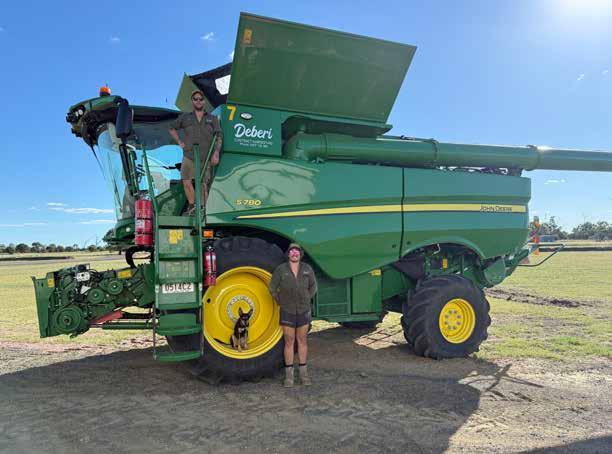
CONTRACT
MANAGER
SCHULZE (TOP), PICTURED WITH MITCHELL BURGOINE, COMPANY MASCOT, PIPER, AND ONE OF ITS FIVE JOHN DEERE HEADERS, SAYS THE BUSINESS APPRAISED THE USE OF A GERINGHOFF HEADER FRONT LAST HARVEST AND, COMPARED WITH THE JOHN DEERE DRAPER FRONTS, IT REACTED TO GROUND CONTOUR CHANGES QUICKER AND THE FINISHED CUT BEHIND THE HEADER WAS BETTER.
with a 13.5-metre MacDon FD145 FlexDraper front and is looking to switch to a 12m front to support a controlled traffic farming system.
“It’s pretty undulating country and you could definitely see the Geringhoff front moving – it’s so much more responsive,” Matt said.
“The lentils were limited due to frost and didn’t have the biomass or height, but it was good. The reel was about 150mm from the cutterbar, but the air system made up for that and was very impressive.
“The ground following in the cereals was great as well. We are heading toward a disc system, so cutting crops fairly high and getting the evenness is going to be important.”
Benji Schulze, Manager of Deberi Contract Harvesting, which is based at Emerald in Queensland and runs five John Deere headers with hinged draper fronts for summer and winter crop harvest work all the way south into Victoria, said the Geringhoff front was definitely better in terms of performance and build quality.
The John Deere draper fronts also can include a flexible cutterbar, but Benji, who is originally from Germany, was aware of the Geringhoff technology and was keen to assess its latest fronts.
“We used the Geringhoff in chickpeas and wheat near Coonamble in New South Wales,” Benji said.
“It does a brilliant catch job and with the air system, the (grain) losses are way less. I think it would have reduced the losses by about 8 per cent.
“The air blows from behind the knife, so grain is not rolling off. With after-market systems, you can get a bar across the front and rear and the air tubes can shutter the grain.”
He said the Geringhoff front was lighter than the John Deere draper fronts, it reacted to ground contour changes via its sensors quicker and the finished cut behind the header was better.
“Other than compared to the John Deere draper, it is unbeatable.”
“There are no waves in the cut, the operation is way smoother and we can go at way faster speeds due to the good cutting speed – around 2 kilometres per hour faster. The Geringhoff cutterbar is run off a separate circuit with its own PTO and oil system, whereas the John Deere fronts use oil from the header.”
Benji said the business would now assess the durability and reliability of the Geringhoff fronts in the coming period to assist their future decisions.

A solid cropping program that has grown over the years to now cover about 11,000 hectares near Cleve on South Australia’s Eyre Peninsula constantly puts the focus on achieving any logistical efficiencies possible for the Burton family.
Jason Burton and his wife, Julie, together with their sons, Hank and Jed, and with the help of Jason’s father, Ian, grow wheat, canola and lentils, as well as some barley and lupins, over dune swale soils, including good clays and sand over clay, running through to nice loam rises.
They have been continuously cropping for about 10 years and, like many growers, have also put significant effort into soil amelioration works, including clay delving and assessment and application of lime and gypsum.
The cropping program is harvested by a strong equipment fleet including two John Deere X9 headers, plus a contract harvester if required, tipping grain into chaser bins and a 150-tonne motherbin before it is hauled to a local Viterra grain receival site or down to T-Ports at Lucky Bay using their three road train rigs.
“It’s all about efficiency and logistics with the harvest operation,” Jason said.
Only having one 24t, single-axle J&M chaser bin, in addition to
the motherbin, to handle around 55t/hr of grain coming off paddocks per header in an average harvest, the efficiency dial recently turned to adding another chaser bin, which they did through local machinery dealer, Ramsey Bros.
The Burton’s opted for a Canadian-manufactured, 36t tandem axle Elmer’s Haulmaster chaser bin.
Elmer’s tandem models provide 2.5 square metres of ground contact, maximising flotation and limiting soil compaction, and four-wheel steering allows excellent manoeuvrability, minimal soil disturbance and reduced pressure on axles.
Jason said they target cost-effective logistical efficiency gains where possible, and, while the Elmer’s chaser was slightly dearer than some others, it did offer more attractive features including full joystick control and an easily adjustable auger with four-way, proportional pivoting spout.
The joystick is part of Elmer’s optional Haulmaster Pro control system and works with fivepoint load cells and a Haulmaster Connect tablet to provide maximum auger control.
“I liked the joystick control,” Jason said.
“It’s easy to teach people and it gets rid of the hydraulic button. You can put someone on it and away they go.”
SAM ABBOTT, GENERAL MANAGER WITH ELMER’S AUSTRALIAN DISTRIBUTOR, WARINGA DISTRIBUTION, AND SOUTH AUSTRALIAN GROWER JASON BURTON, CLEVE, WITH THE FAMILY’S 36-TONNE TANDEM AXLE ELMER’S HAULMASTER CHASER BIN.
JASON SAYS COMPARED TO SOME OTHER CHASER BINS, THE ELMER’S MACHINE OFFERED MORE ATTRACTIVE FEATURES INCLUDING FULL JOYSTICK CONTROL AND AN EASILY ADJUSTABLE AUGER WITH FOUR-WAY, PROPORTIONAL PIVOTING SPOUT.
He said they used the load cells to check their grain weights with the headers and for the “truckies”, while the pivoting auger had proven to be excellent for filling the motherbin.
“We’ve even been using the scales on the chaser to help sell grain – lupins and sheep feed –off-farm and it has been great.”
“The pivoting auger is really good for filling the motherbin. It has great reach and you can get close and play with the spout to direct it where you want it.”
Elmer’s custom-designed, Powermaster direct drive gearbox eliminates any belts and drive chains and it further increases auger output, emptying at up to 18t per minute for even higher unloading efficiency.
“It’s pretty mind boggling how very quick it is. The fast unloading means we also don’t have to speed across the paddocks,”
Jason said.
He said it had resulted in a good jump in efficiency and productivity at harvest.
“Trucks come in, fill up and go. The front trailer is generally filled from the motherbin and the chaser fills the back trailer.”
Jason said support from Ramsey Bros and Elmer’s national distributor, Waringa Distribution, including to ensure they continued operating when there was an issue, had been great.
“We had the use of a demo 41t model and we will see whether we go to a bigger chaser bin down the track – maybe to a 55t model.”
The Elmer’s chaser bins also have since been popping up in the local area, with two of the Burton’s neighbours now having a machine on their properties.
Meanwhile, the family’s chaser bin investment took Jason and Julie on a group tour to visit Elmer’s production facilities in Canada last year, including its latest 150t and 225t motherbins, while the group also enjoyed a host of other memorable sites along the journey, which stretched from Vancouver to Calgary.
Davimac has launched its largest chaser bin to date, the allnew 45-tonne model, delivering serious capacity and next-level harvest efficiency for large-scale Australian grain operations.
Built for growers and contractors who need to keep pace with today’s high-output harvesters, the 45T features a dual axle undercarriage with rear self-steering as standard, and a 24-inch unload auger capable of shifting up to 18 tonnes per minute. Designed and manufactured entirely in Molong, NSW, it embodies Davimac’s trademark strength and simplicity, now on a scale to suit the biggest cropping programs in the country.
“The 45T came directly from grower feedback,” says Joshua Whalan, Marketing Manager at Davimac Group.
“Farmers wanted greater capacity, improved manoeu-
vrability, and braking capability. We’ve combined all three in this design. As far as we know, we’re the only Australian manufacturer fitting hydraulic brakes to a 12-stud axle rather than the standard 10-stud. It’s a big step up in safety and performance.”
While the 45T headlines the range, it retains the proven DNA of Davimac’s smaller models, including easy cleanout, fully welded construction, a heavy-duty gearbox, and smooth towing. The rear steering axle reduces soil compaction and tightens turning circles, while the hydraulic braking system adds confidence for operators moving between paddocks or on-farm roads.
Despite its size, usability remains a core focus. Operators will find the same straightforward setup, low maintenance, and intuitive controls that have made Davimac bins a staple on Australian farms for more than 40 years.
CROPSCAN 4000VT ON DISPLAY AT THE NSW DPI FARMS OF THE FUTURE EXHIBITION AT HENTY FIELD DAYS.
As harvest quickly approaches, the field days are winding up. Recently in Henty, NSW, the DPI setup a Farms of the Future pavilion at the Henty Field Days.
The pavilion hosted approximately 18 AgTech companies that displayed their latest technologies that have been part of the DPI’s Farms of the Future program. They called the display AgTech Alley.
CropScanAg has pleased to be part of the DPI’s program for the last few years. Under the program, farmers have been able to apply for a refund from the DPI if they took up any of the technologies offered by Farms of the Future partners.
This year CropScanAg had the new CropScan 4000VT ISOBUS Integrated On Combine Analyser and N-GAUGE Apps on display along with the CropScan 3300H On Combine Analyser and the CropScan 3000X On Farm Grain Analyser.

The release of the 45T complements the existing 25T, 30T and 35T models, giving growers a complete capacity range.
“Our 30T and 35T bins remain incredibly popular with contractors as they balance capacity and ease of handling,” Josh says. “They also have one of the lowest load heights on the market, helping header drivers avoid collisions.”
Davimac offers a wide selection of optional extras to suit different farming systems, includ-
ing load cells and Libra Cart for precision grain monitoring, firefighting units, camera kits, and right-hand discharge.
Customers can even colour-match their bins to tractors or headers for a professional finish.
With nationwide dealer support, local servicing, and parts backup, every Davimac chaser bin is built and supported for Australian conditions.
For more information visit davimac.com.au.

One of the many benefits of participating in the DPI’s program is the support provided by the DPI. Their objective is to incentivise farmers to adopt AgTech so that the farmers can increase their revenue and ensure sustainability.
From CropScanAg’s perspective the exhibition provided a means of speaking with many existing CropScan users and to demonstrate our technologies to potential customers int eh Riverina area. We look forward to participating in next year’s Farms of
the Future event at Henty.
For more information on the CropScan 4000VT, N-GAUGE Apps and range of NIR Grain Analysers , visit the CropScanAg web site www.cropscanag.com or contact CropScanAg at sales@ cropscanag.com.
New Holland’s next generation CR combines are set to make their Australian debut for the 2025 harvest, with a brand new platform built from the ground up to maximise efficiency and performance for Australian farmers.
New Holland will deliver a limited number of next generation CR twin rotor combines, the CR11 and CR10, across Australia in time for the 2025 harvest.
Both combines feature New Holland’s pioneering twin rotor technology with more capacity than ever, greater power and grain tank volume.
Marc Smith, New Holland’s ANZ Product & Portfolio Manager – Crop Harvesting, said produc-
tivity, grain saving, residue management, and uptime are at the heart of the new CR combines.
“These new machines are redesigned from the ground up to maximise efficiency, with improvements such as more horsepower, bigger capacity, and faster unloading, all contributing to greater productivity in the field,” he said.
“We’ve reduced the number of drive components by 25% and all drive chains have been eliminated to further reduce downtime and maximise efficiency.
“One standout feature is the new in-cab de-slug feature, which once engaged, is fully automated saving the operator time and effort.
“If you happen to block it, you hit a button and you’re back harvesting again in minutes.”
Marc said the redeveloped
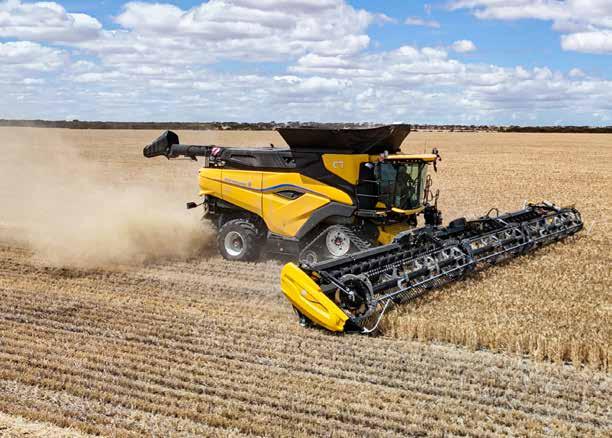
IntelliSense automation system was another major advancement, contributing to improved performance and ease of use.
“IntelliSense makes automatic adjustments according to your chosen harvest strategy, whether limited loss, best grain quality, maximum capacity, or fixed throughput,” he said.
“We’ve also introduced a totally new cleaning shoe which can handle all materials coming from
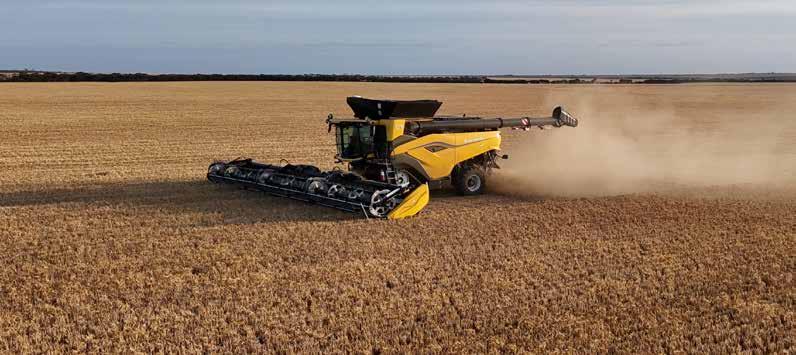
the rotors to reduce grain loss close to zero. It essentially does as it says, it wastes very little to no grain.
“We achieved this with an allnew Twin-Clean cleaning shoe consisting of two sieve systems in sequence, each having its own upper and lower sieve and clean grain auger.
“The cross-distribution mechanism guarantees an even cleaning shoe load in all conditions to maintain maximum grain quality with close to no grain loss.”
Marc said the new CR combines are expected to be a game changer for Australian grain farmers, driving down their total cost of harvesting and increasing their bottom-line profitability.
“Extensive validation and testing have already been done in Australia over the past year, and the machines have also been working the North American and European 2025 harvests.
“We’re looking forward to seeing how they perform in their first Australian season,” Marc said.
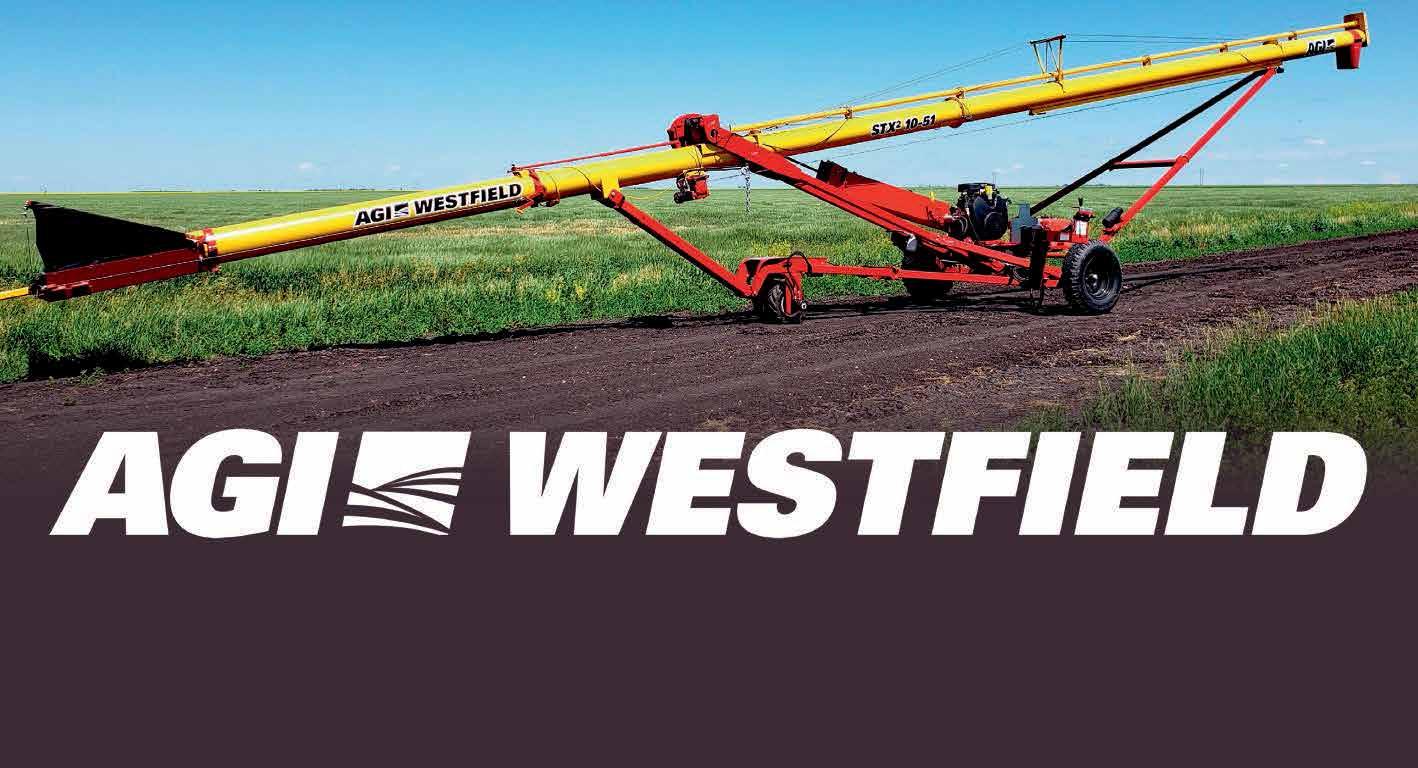

The Fendt Ideal redefines agricultural performance with its cutting-edge technology, efficiency, and operator-focused design. Built at AGCO’s European Harvesting Centre of Excellence in Breganze, Italy, the Fendt Ideal is a combine that has been designed and engineered from the ground up. AGCO has worked closely with a team of experts and developed each aspect so that it gives perfect results in the most demanding harvesting conditions.
Philipp Ashton, Fendt Product Marketing Manager, noted during recent field days that Ideal customers consistently praise the advanced technology in these machines. “They are packed with innovative features that deliver outstanding results. Farmers tell us that the
Ideal offers both strength and capability while maintaining fuel efficiency – and they value the longevity and reliability of the machine,” he said.
Fendt IDEAL range has all classes covered
AGCO has developed this unique Ideal Combine in 4 models ranging from 451 – 790hp after identifying a niche in the future-oriented market environment. The Fendt Ideal 8, 9 and 10 feature high-performance MAN engines, and the Ideal 7 features an AGCO power engine, which ensures maximum output together with effcient fuel consumption.
Helix threshing unit and the separating system ensures the ultimate in grain quality.
Excellent grain quality and effcient acreage capacity are essential for the perfect harvest. That’s what the new Fendt Ideal combine series offer with its

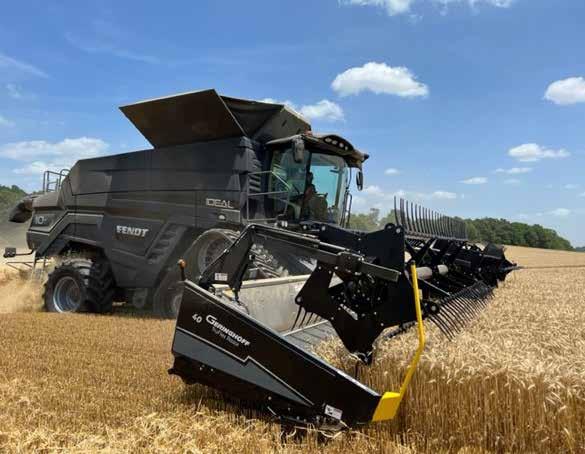
unique Helix threshing unit and separating system. All grains are separated cleanly without negatively impacting on the straw quality, due to the longest rotor on the market today with its impressive 4.84m length and 600mm diameter. In order to handle the harvest with as much care as possible, and to ensure a constant load on the rotor, the intake augers, threshing bars and rotor fingers are arranged in a spiral around the rotor, in a similar pattern to DNA, this is where the name Helix is derived.
The processor requires much less power and signifcantly increases the output and machine effciency with perfect straw and grain quality. It also features easy modification to suit any harvesting conditions.
The Ideal 8, 9 & 10 work with the Dual Helix threshing unit with 2 rotors, whilst the Ideal 7 works with the Single Helix threshing unit and 1 rotor.
An additional innovation of the Fendt Ideal combine is the installation of 2 grain pans at
the front of the threshing unit, meaning that the front end of the preparation floor can already be filled with crop. The rear grain pan catches the material from the separation area, and distributes it in the rear area. The entire length of the preparation floor is therefore fully utilized, the crop is evenly distributed, and efficiency maximized.
The curve of the two grain pans also allow optimal and consistent output even on slopes. Losses on gradients of up to 15% are reduced in comparison with conventional combines which is of great benefit to the driver as they do not have to make additional adjustments.
The narrow vehicle frame of just 1.40m provides more space for even the widest tyres and crawler track options. The Fendt Ideal therefore complies with the current traffic regulations with maximum vehicle widths of below 3.30 m and 3.50 m. With a maximum vehicle width of 3.30m with the 26” TrakRide crawler track, the Fendt Ideal creates

a contact area of 2.55m2 and therefore ensures low ground pressure.
The transparent combine – IDEALharvest visualizes the flow of crop in real time
The IDEALharvest system was developed specially for the high-performance Fendt Ideal combine. It sends the capacity status of the threshing unit and cleaning in real time to the combine using Mass Acoustic Detection sensors (MADS). The sensors are fitted along the rotors and the shaker shoe, and detect the flow of crop within the machine as well as any losses which occur.
Using the MAD sensors in combination with the grain quality camera, allows grain losses, percentage of cracked grain, and grain purity to be displayed. The driver can look at the iPad display in real time to see whether more material can be found in the front or on the right of left of the processor. With the aid of the SmartConnect app, they can select his customized harvest strategy between cracked grain, grain loss and purity, within a triangle adjustment displayed on the iPad. The driver also sets
the ratio between machine output and quality. The machine then adjusts itself on a continuous basis based on these settings, and reacts in real time to changing harvest conditions. For example, the IDEALharvest system can automatically adjust the grain separation and the rotor speed if cracked grains occur.
Outstanding visibility and an exciting design
The driver’s seat design is key when it comes to getting the best out of the machine. The spacious Vision cab offers plenty of room and provides outstanding visibility, as well as user- friendliness in the Fendt quality you know and love.
Developed from ground up, the Fendt Ideal comes in an exciting, completely new design from any conventional combine. It reflects the exceptional quality and innovation based on the latest trends and technologies in our global centers of expertise. The Fendt IDEAL design alone conveys dynamism, efficiency, motivation and strength.
Increased visibility and space
The new option IDEALdrive offers a revolutionary concept:





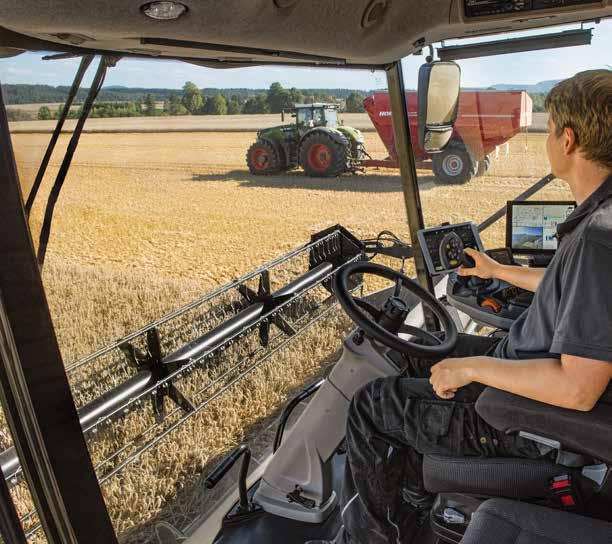
with IDEALdrive, there is no need for a steering column. Instead of using a steering wheel, you control the combine harvester with a joystick on the left armrest. It means you have a great view to the front. The joystick’s control and intuitive response are proportional to the driving speed and the steering lock angle on the wheel. It is easy and safe to control in every situation. Together with the unprecedented visibility, IDEALdrive increases also the operator’s comfort:
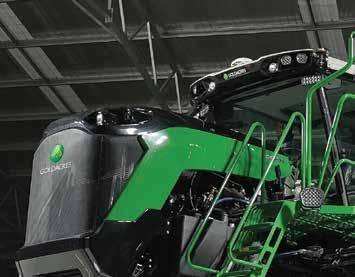
university studies confirm that this system reduces the muscle activity of the 65% compared to a conventional steering wheel.
The Fendt Ideal combines cutting-edge engineering with practical innovation, helping farmers across around the world achieve cleaner grain samples, greater efficiency, and a more sustainable harvest season after season. For more info about the Fendt Ideal and how it can enhance your farming operations, visit www.fendt.com/au.























› It’s available free of charge to readers who qualify under the publisher’s criteria and who supply proof of occupation.
› All the latest news, views and information from the industry.

If you are not a registered reader but would like to receive a regular bi-monthly copy, please fill in the details below of your contracting or farming business and post this form to us.
Alternatively, you can fill in the subscription form on our website: www.agcontractormag.com
Australian AgContractor is available free of charge to readers who qualify under the publisher’s criteria and who supply proof of occupation (ie. printed letterhead, business card, invoice etc.) and to others upon payment of the $50.00 annual Australian Subscription (Rest of the World: $65.40 AUD).
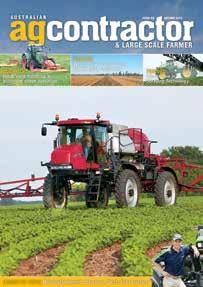

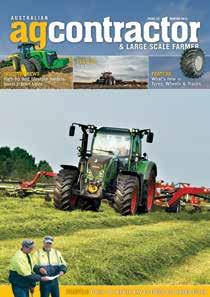
› In-depth profiles on contractors and farmers from all across Australia.
› Six issues per year, delivered direct to your door.
› Subscriptions from as low as $50.00 annually to non-industry subscribers.
Please email admin@agrimedia.co.nz or phone +64 3 329 6555 to arrange payment if you are a non-industry subscriber.
Name:
Business/Farm Name:
Postal Address:
Postcode:
Country:
Phone:
Email:
coNTracTor
Main contracting services offered:
Criteria: Broadacre - over 1000ha and/or Sheep or Beef - over 12,000 stock units and/or Dairy - milk over 400 cows (owner or sharemilker)
Total farm ha: No. of dairy cows: No. of beef cattle: No. of sheep: Area in arable crop:
Please sign here if you wish to receive a regular copy of this publication and send the form, together with proof of occupation or cheque to: aML, Po Box 37151, christchurch 8245, New Zealand.
Signature:
Date:
While others talk about disruption, Seed Terminator has quietly gone about the business of building it.
Ten harvests ago, the first Seed Terminator units were bolted onto headers across Australia—a quietly radical step that reimagined the back of the machine not as an afterthought, but as the final line of defence
against weeds. A decade on, the mission hasn’t changed. But the tools have.
The problem is well known: herbicide resistance. But underneath it lies something even more fundamental: weed seed escape. At harvest, there are no second chances. You either stop the spread, or you spread the problem.
While a knockdown spray may boast 95% efficacy, it’s often
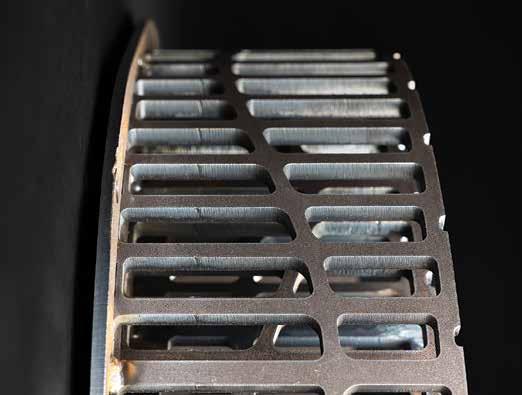
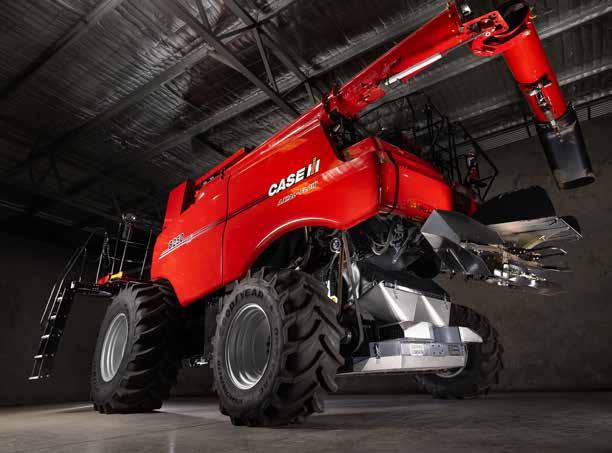
only acting on 40% of the weeds that germinated that season, equating to just 38% overall control. A mill, by contrast, acts on everything collected and sorted by the header into the chaff fraction.
“This idea that you only get 50%, so it’s not worth it—that mindset needs smashing,” says Dr Nick Berry, Seed Terminator co-founder. “It’s a globally important shift.”
The RIM model, developed by AHRI and CSIRO, backs this in, showing that even modest reductions in the seedbank at harvest dramatically improve long-term weed control when
part of an integrated strategy.
The technology: Built here, proven erverywhere
This season sees the release of the next generation AeroIMPACT 4 mill technology. Heralded as a low-inertia breakthrough it was first developed in 2022. The latest iteration deletes tungsten coatings altogether, replacing it with a deep heat treatment and cryogenic quench, freezing the beater bars to lock in hardness and extend wear life.
Combined with new screen designs that tighten tolerances and redistribute energy, the system achieves the same high


phone 0405 939 592 louis@sustainablewatersolutions.com.au
For harvesting contractor and 6th generation farmer, Lachie Finlay, from Mullaley NSW, embracing cutting-edge machinery has elevated his farming operations to new heights. As a contractor Lachie harvests a large variety of crops, from wheat, barley and canola to chickpeas and sunflowers. On the 10,000 acre family farm, he has just finished a successful sorghum harvest.
A leap in efficiency and productivity was made by upgrading his standard Macdon feed system to the i-paddock Typhoon Feed Drum. The Typhoon Feed Drum has 25 solid steel fingers that
aggressively grabs crops and pulls them through in a constant steady flow.
“We picked up about 3kmh in canola and I found it feeds more even, less wrapping, less maintenance, simpler design in sorghum and extremely big difference in sunflower – a big, stalky, bulky plant that is very hardy,” Lachie says.
Over the 2022 summer harvest Lachie was contracted to a canola crop that had floods, a windstorm and hail go through. This is where another innovative product that he has installed to his harvester front, The Feedstorm™ Cross Auger, came in handy. The auger is adjustable from cab, which gave great results when harvesting the crop

kill while using significantly less power—a win for throughput, efficiency, and longevity.
“This isn’t just an upgrade,” says Berry. “It’s a rethink of how we apply force, manage wear, and give farmers better return.”
From their factory in Lonsdale, South Australia, Seed Termina-
tor continues to leverage Adelaide’s manufacturing legacy— born from the car industry and now fuelling globally competitive ag machinery. The machines are Australian Made, and their reach spans from Yorke Peninsula (where adoption tops 40%) to Canada, Europe, and beyond.

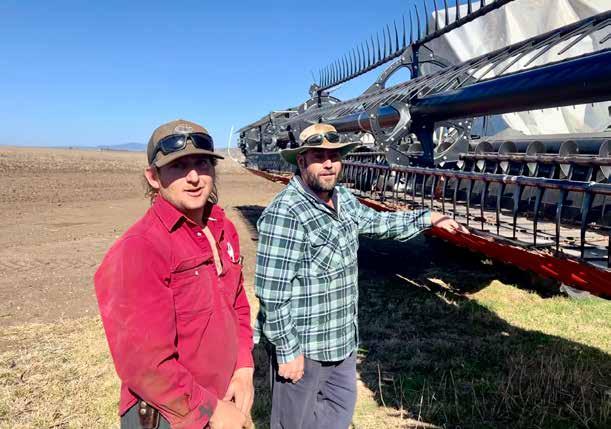
that was “… above your head as well as below your boot in the same swath, so we really tested it there. As soon as you put that on, it’ll change your life especially in canola, those bushy lighter crops. We picked up an extra 2km/h,” said Lachie. The Feedstorm is designed and made in Australia by Primary Sales to fit onto existing header fronts to replace the OEM cross augers.
As weather changes and operating costs put the pressure on to maximise the harvest window. Experimenting, trying out new harvester set ups, speaking to specialists and other growers can help increase efficiency, performance and keep grain losses at a minimum. When it comes to making changes and measuring loss, Lachie looks to his family of 4th generation harvester contractors for their experience and knowledge. They like to keep a close eye on their grain losses but are always looking for innovative ways to be more
The new Pro S7 platform, designed specifically for John Deere’s S7 700–900 Series, joins the line-up for 2025. It sits alongside models for Case IH AF10, New Holland CR11, Claas Lexion, the earlier CR 8.90–10.90 range, and John Deere S & X Series combines.
“Back in 2016, after handing over the hydraulic Seed Destructor, I set out to develop a fully mechanical, future-proof platform,” says Dr Berry. “To see Terminators now, running on nearly every colour and class of combine, tells me we’re still solving a problem worth solving.”
Harvest-ready means weed-ready
The tools are sharper. The pow-
efficient. “We’re always trialing new things. Budget depending of course, we have a saying in our family, the more you mess around the more you find out. But you need to also have an educated guess at it.”
The combination of traditional farming wisdom with cutting edge technology can lead to extraordinary results.
Lachie’s family have also designed their own sunflower trays which have greatly decreased their losses. The i-paddock Typhoon Feed Drum is a farmer designed solution to a farming problem. i-paddock was founded in 2011 by Mic and Marnie Fels, both qualified engineers who have been farming at their Halcyon Downs properties in Esperance, Western Australia since 1993.
For more information on the i-paddock Typhoon or the Feedstorm Cross Auger, visit primarysales.com.au or call 08 9250 3500.
er’s more efficient. But the mission hasn’t changed: stop weed seeds at harvest, and stop them for good.
“You can’t afford to let harvest be the weak link in your weed control program,” says Dr Berry. “Farmers know they can’t spray their way out of resistance anymore. It’s time to close the loop.” Because in the end, weeds adapt. But so do farmers. And the machines they trust should too.
Seed Terminator is proud to announce their Early Order Program is open till the end of March 2026. Those wanting to lock in the best pricing for the next harvest can reach out to their local Dealer or the team, for details see seedterminator.com.au.
Farmers across Australia and New Zealand now have a unique new tool in John Deere’s Harvest Profit, a convenient cost and profit tracking software platform that offers near-real time profitability monitoring across crops and fields.
Harvest Profit is an all-in-one farm management software program designed to be integrated with John Deere Operations Center to provide valuable insights and analytics and improve farm profitability.
Harvest Profit includes tools such as grain inventories and financial reports to quickly show farmers how their businesses are performing day-to-day.
John Deere Manager of Pro-
duction System Specialists, Max Cusack, said Harvest Profit is designed to help farmers become as familiar with managing finances as they are with growing a crop.
“Harvest Profit uses multiple scenarios and templates and intuitive integration with Operations Center to provide clear insights into costs, revenues and profits, so that farmers can make data-driven financial decisions,”
Max said.
“Harvest Profit can provide the answers to questions such as what’s my cost of production? What’s my profitability for each field? If I plant more of a certain crop, how does that impact my profitability and overheads? How much production have I sold and how much crop inventory do I have on hand?”
“Farmers in Australia and New

Zealand are seeking to gain every efficiency possible to improve financial outcomes, and Harvest Profit is the key to calculating those metrics.”
Portable and easy to use, Harvest Profit includes features such as total farm profit and loss (P&L); field by field and crop by crop P&L; grain contract management; machine data such as hours, usage and cost of farm equipment; scenarios analysis; and grain inventory management.
Ben Longlet, John Deere Digital Specialist - Harvest Profit, said US farmers have had access to Harvest Profit for 10 years, and rely on the data to analyse any financial decision they make on their farms.
“In the US, farmers rely on Harvest Profit as a tool to help them make decisions as diverse as an equipment purchase, land acqui-
sition or whether to apply another pass of fertiliser,” Ben said.
“While most farmers don’t spend more than an hour per month working on their Harvest Profit account, they are usually checking the data and reports daily through its web and mobile apps.
“This strong integration makes is easy to add financials to the data you’re already collecting on the farm, and unlike other tools that focus on the past, Harvest Profit enables farmers to analyse profitability so they can confidently create budgets for the coming season.”
John Deere is offering a 14-day free trial of Harvest Profit with full access.
To find out more about Harvest Profit or purchase, contact your local John Deere dealer or visit https://www.harvestprofit. com/.
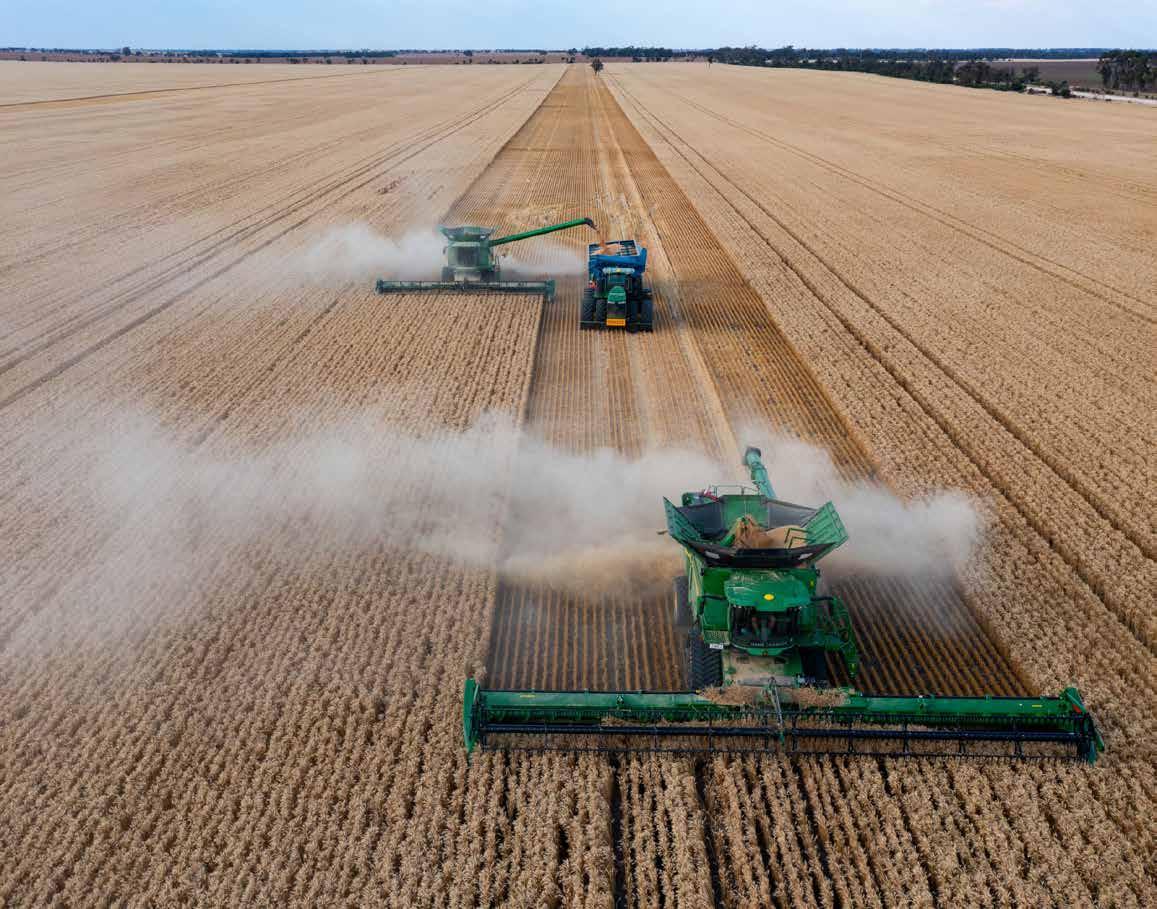
AMAZONE HAS EXTENDED ITS RANGE OF HIGHPERFORMANCE CIRRUS GRAND LARGE AREA SEED DRILLS WITH AN 8M VERSION, THE NEW CIRRUS 8004-2C GRAND.
The trailed cultivator drill is ideal for large farms and contractors working with tractors from 280hp. The Cirrus Grand meets the requirements of a wide range of establishment systems thanks to the precision and flexibility provided by the simultaneous metering of different products via the new three-chamber hopper.
New: three-chamber hopper makes for pioneering establishment methods
The key feature is the new triple-chamber hopper with a total capacity of 5,900 litres. Combining three chambers in the one hopper offers a high level of flexibility and provides easy accessibility for the operator. Up to three different products can be individually metered at a ratio of 40:50:10. For example, rape, fertiliser and slug pellets can be applied in a single pass using the Single-Shoot process. In addition, wheat can be sown together with the simultaneous application of fertiliser and micro-granules. All products are delivered precisely to the same point in the seed furrow, which ensures efficient application.
Solutions for modern arable farming – the new 12.5 cm row spacing
The large distributor head and the choice of the Smart plus equipment level ensures optimum lateral distribution. The individual row shut-off ensures high sustainability by reducing
any waste of seed and fertiliser on headlands and in wedge shaped fields. Tramline control is provided symmetrically, asymmetrically or flexibly and is selected in a user-friendly manner via the ISOBUS terminal. The distributor head adjusts automatically. This intelligent system means that the working width of the seed drill is independent of the respective tramline system. Deactivating individual rows offers a particular advantage. For example, rape can be sown with double row spacing.
The Cirrus 8004-2C Grand also benefits from an additional row spacing option. On top of the conventional row spacing of 16.6 cm, a narrower spacing of 12.5 cm can also be specified. This is ideal for spring sowing and farms with high weed pressure. The narrow row spacing allows the crop to cover the soil over more quickly, which reduces weed emergence. This leads to a cleaner crop and, in the best-case scenario, decreases the use of herbicides.
AutoPoint: switch point optimisation for good field hygiene
The AutoPoint automatic measuring system, an intelligent solution for determining conveying times, has now been incorporated in the Cirrus Grand. A sensor in the seed coulter determines the conveying time of the seed flowing from the metering unit to the coulter and automatically adjusts the switch-on and



HIGHLIGHTS:
- 3 Chamber/bin - Ama tram
- Auto point / Single row shut off section control
switch-off points of the system on the headland. This technology constantly improves the Section Control times and increases sowing precision. This results in the minimisation of misses and overlaps, thereby promoting better field hygiene.
Crushboard and guide wheels extend the range of front tools
In addition to the T-Pack front tyre packer, new front tools are also available for the Cirrus Grand. A Crushboard with outlying guide wheels has been specially designed for farms with heavy or cloddy soil conditions. The Crushboard levels the surface, breaking up clods and ensuring a level seedbed, especially for use after the plough or following rough primary cultivation work.
The guide wheels on the outside of the machine ensure smooth guidance and prevent the wings from sinking into the ground. The Cirrus Grand is also available just with guide wheels in front of the disc element for
farms that carry out complete seedbed preparation before sowing. This means that there is no need to use a front tool. Optional on-board hydraulic system and air pre-heater
Another plus point is the optionally available on-board hydraulic system with a push-on PTO pump. This enables the drill to be operated with tractors with a low hydraulic capacity. The optional air pre-heater ensures trouble-free operation when working in damp air conditions. It increases the temperature of the air flow by around 8 °C reducing the formation of condensation and thus preventing seed dressing or fertiliser dust from sticking in the conveyor system.
Updates also available for the 9m version
These new updates are now also available as options for the Cirrus 9004-2C Grand with its 9m working width. The new levels of equipment significantly increase both efficiency and output.
FROM THE 2026 SEASON, PÖTTINGER’S FLEXCARE V BOASTS A WHOLE LOAD OF NEW FUNCTIONS.
This flexible, versatile machine is ideal for conventional and ecologically operating family-run farms, large farms and contractors. The most important innovation is the pneumatic distribution system, which offers many advantages as an addition to a seed hopper such as Pöttinger’s Amico front hopper: Fertiliser can be placed as required, nutrient efficiency is increased and processes are combined, therefore reducing the number of passes.
The new optional trailing tine hoe increases the drying reliability of weeds as well as protection against erosion because hoed weeds are shaken out and deposited on the soil surface.
Another new feature on the Flexcare V is the optional Durastar Plus duck foot shares with carbide coating. With even bet-
ter ground penetration, a more robust design and significantly increased replacement intervals they are the right choice for very hard ground.
These new features make Pöttinger’s Flexcare V the perfect combination of precision, crop protection and efficient weed control both between and in rows because weeds are overturned, torn out or damaged.
Modular system for state-of-theart, successful farming Its uncompromisingly modular design means that row spacing and tools are easy to adjust – no special accessories required! As a result, grain crops, for example, sown 25 cm apart, can be worked with the same equipment – with very little modification – as, say, pumpkins set 160 cm apart. And the free online

tool Row Crop Assist makes finding the right configuration child’s play.
The large number of possible combinations makes the Flexcare fit for every kind of application. It allows you to optimise
your machine utilisation and so increase cost effectiveness.
The Flexcare V is perfect for every farm wishing to realise its full potential from precision planting, varied crop rotation or varying row spacings.


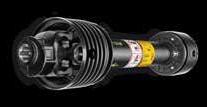

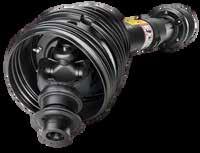


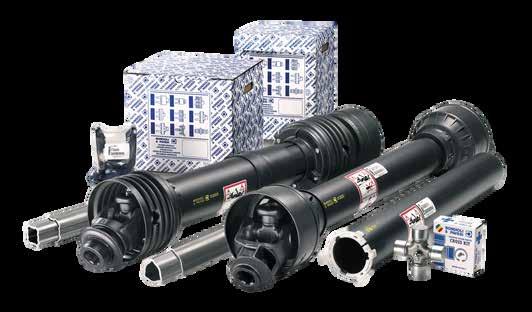






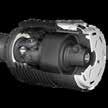


THE NEWLY DEVELOPED, STEERED ACTIVELOAD 2 PICK-UP IS BERGMANN’S PRACTICAL FURTHER DEVELOPMENT FOR MODERN LOADER WAGON USE. THE AIM WAS TO FURTHER IMPROVE STABILITY AND PERFORMANCE WHILE SIMULTANEOUSLY MAKING THE MATERIAL FLOW MORE EFFICIENT.
Six rows of tines on the ActiveLoad 2 achieve maximum fodder pick-up - clean, gentle and without loss. With working widths of 1,940mm, 2,050mm and 2,270mm, ActiveLoad 2 is ideally matched to the Bergmann Repex, Carex and Shuttle loader wagon series.
Scraper made of plastic: quiet, low-wear and easy to maintain
The new plastic scrapers improve the material flow while minimising operating noise. They are especially low-wear, flexible and enable quick replacement of the double tines. This considerably simplifies maintenance and repair work.
Reinforced double tines for extreme loads
With a 20% larger diameter compared to the previous model, the double tines offer significantly greater stability and durability – even under extreme operating conditions. The optimised ratio between the tines and scrapers creates more free space and also improves quiet operation and service life.
Three-bearing tine carrier shaft – maintenance-free and robust
A further highlight is the maintenance-free, three-bearing tine carrier shaft with high-quality ball bearings which works reliably even under high loads.
The tine carriers can be completely removed for particularly easy maintenance. The plastic scrapers can be flexibly folded forwards after loosening the upper screws. Large support rollers for maximum service life
The six tine carriers are reliably and even-
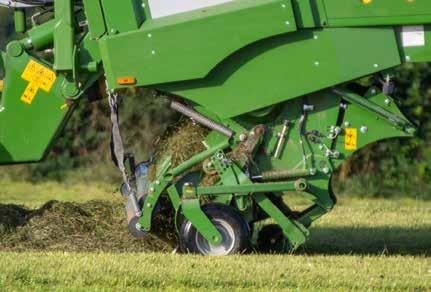
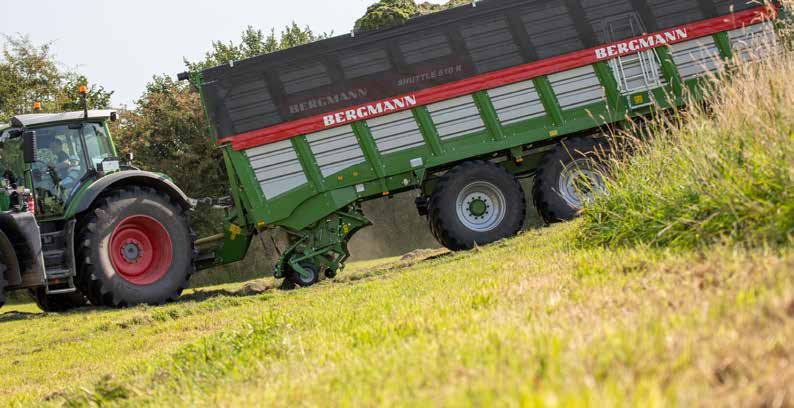
ly controlled via a low-wear cam track for high-throughput fodder intake.
The new, high-quality support rollers with a 30% larger outer diameter, a 33% larger inner diameter and a 31% wider design significantly reduce the bearing speed and considerably increase stability.
A clever solution for quick maintenance
A large maintenance opening directly on the cam track ensures optimum access to the support rollers and makes it easier to replace them – no removal of the entire tine carrier unit required. The opening also enables perfect visual control of the cam track.
Optimised material flow
For better pre-compaction and optimised fodder transfer to the rotor, the pick-up is equipped with a new suspension for the double swath rollers followed by a guide comb.
The suspension and bearing points are designed to ensure a continuous, trouble-free flow of material.
The even crop transfer to the rotor ensures perfect utilisation of the Bergmann loader wagons.
Perfect ground adaptation
The ActiveLoad 2 pick-up has a standard pendulum suspension and is equipped with trailing guide wheels for ideal adaptation to the ground. This ensures clean fodder intake even in hilly terrain.
Mechanical or hydraulic pick-up relief is optionally available to ensure even pick-up contact pressure.
The mechanical pick-up relief in particular impresses with its fast reaction speed to any ground contour. Higher driving speeds are therefore possible without the pick-up losing ground contact. This in turn achieves a perfect pick-up pattern even when driving fast on uneven ground – providing the basis for clean, high-quality fodder.

Thanks to its hydraulic drive, the speed of the pick-up can be set independently of the tractor’s motor speed (PTO speed). This allows the driver to set the pick-up’s ideal operating speed for the current conditions.
The standard driving speed-dependent pick-up speed control ensures continuous intake and feeding of the fodder to the rotor. This takes the strain off the driver so that even long working days can be mastered without fatigue. The driver can turn the speed control on or off to suit the current operating conditions.
The hydraulic drive also enables a much greater swing angle compared to a mechanically driven pick-up, thus ensuring better adaptation to the ground contour as well as efficient pick-up of the fodder.
Suitable for every farming operation
Bergmann is the only manufacturer to offer both a steered and a non-steered pick-up for loader wagons. This allows users to choose the pick-up type best suited to their particular operating conditions.
A zero series of the ActiveLoad 2 pick-up will be released for the coming 2026 season.
CASE IH HAS UNVEILED ITS NEW 3-METRE CENTRE SET-UP FOR THE OPTUM TRACTOR RANGE AT HENTY MACHINERY FIELD DAYS, DESIGNED TO MEET THE NEEDS OF AUSTRALIAN GROWERS OPERATING UNDER CONTROLLED TRAFFIC FARMING (CTF) PRACTICES.
This factory-supported set-up allows Optum tractors to seamlessly integrate into fixed tramline systems, helping reduce soil compaction, improve water infiltration, and enhance long-term productivity with full factory warranty support.
It’s a move that reflects Case IH’s ongoing commitment to delivering practical, high-performance solutions for broadacre and horticulture operations.
Seamus McCarthy, Case IH Medium Tractor Product Manager for Australia and New Zealand, said the set-up was introduced in response to strong demand from growers looking to align their machinery with CTF practices.
“We’ve seen a real shift in the market toward precision farming systems, particularly in cotton and horticulture.
“This set-up will be fully covered by warranty, and allows customers to operate the Optum range with peace of mind and without compromising on power or technology.
The Optum range already delivers outstanding horsepower and operator com -

fort, and now with the 3-metre centre option, it’s even more versatile. It’s a smart solution for growers who need to travel between bed spacings with accuracy and consistency,” Seamus said.
The Optum range offers up to 340 horsepower, a spacious and ergonomic cab, and advanced technology integration including FieldOps for remote monitoring and machine management. With extended

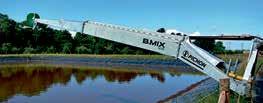




service intervals and robust build quality from the renowned St. Valentin plant in Austria, Optum tractors are engineered for demanding tasks including PTO work, tillage, spraying, and transport.
Visitors to the recent Henty Machinery Field Days had a chance to see the Optum 300 with the new 3-metre centre set-up.
For more info, visit www.caseih.com.au or contact your local Case IH dealer.

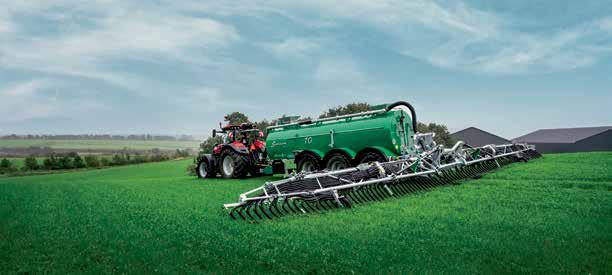

JOHN DEERE HAS BROUGHT ITS MOST POWERFUL TRACTORS, THE JOHN DEERE 9RX SERIES, TO AUSTRALIA FOR THE FIRST TIME, AND EXPERIENCED FARMERS SAY THE SPEED AND PERFORMANCE OF THE GIANT MACHINES ARE EYE-OPENING.
The impressive strength of up to 830 horsepower (hp) and greater hydraulic capacity of the 9RX Series enables large broadacre farmers to get their crop in quickly and efficiently, while multiple track widths and tread spacings allow the 9RX to perform for both row crop and broadacre applications.
The first 9RX Series tractors arrived from the USA in time to plant 55,000 hectares of wheat and chickpeas on Cleveland Agriculture’s properties at Mungindi, on the border of New South Wales and Queensland.
Cleveland Agriculture Farm Manager, Craig Sykes, said the new 9RX 710 and 9RX 770 tractors increased the speed of sowing by 6-8km/hr, which contributed to the efficiency and overall productivity of the operation.
“We’d heard a lot about the 9RX machines before we got them, and they lived up to our expectations and more. They’re very user friendly and the extra horsepower enabled us to plant faster. We have more chance of growing a good crop if we get it in on time,” Craig said.
“The other big thing is that the tractors are quad tracked. In this country we’ve got a lot of red and black soil, and the black is always wetter. So the 9RXs give us more traction with the four tracks.”
The 9RX Series has been designed with input from another Australian farmer, Simon Doolin, of Doolin Agriculture, whose farm is just 50km up the road from Cleveland Agriculture.
Six years ago, Simon was chosen to represent Australian farmers at John Deere’s
CLEVELAND AGRICULTURE FARM MANAGER, CRAIG SYKES, SAID THE TRACTORS ARE VERY USER FRIENDLY AND THE EXTRA HORSEPOWER ENABLED THEM TO PLANT FASTER.
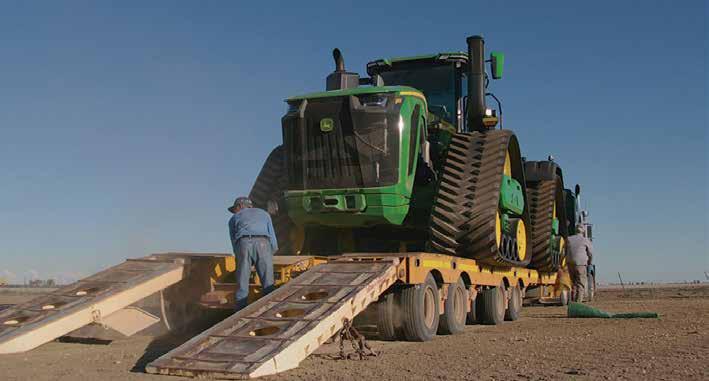
USA facilities, where a group of 12 provided feedback on the design of the new 9RX Series, including transmissions and motors, the types of speeds they wanted to achieve, optimal hydraulic flow and the comfort of the cab.
The collaboration culminated in three new high-horsepower, four-track models driven by the JD18 engine, consisting of the 9RX 710 (710hp), the 9RX 770 (770hp) and the mighty 9RX 830, which will deliver a market-leading 830hp to Australian producers.
At the time, seeing a 3D virtual reality of the new 9RX design was impressive, Simon said, but it didn’t compare with seeing the tractor in real life on his home turf in 2025.
“Seeing the 9RX hooked up to the planters that we use made me realise how much better this new model is. It’s a fantastic package. All of the build points are in the right place, it has great power-to-weight ratio, all the creature comforts in the cab and new ideas for autonomy,” he said.
“Efficiency is one of the only ways we can make gains in agriculture these days, and machines like these 9RX Series, with industry-leading technology, are a massive part of achieving that.”
The 9RX Series delivers both brains and brawn. Precision Ag offerings include the integrated StarFire receiver, G5 Plus display and improved cornerpost display for better visibility and more processing power to enable more applications, such as AutoTrac Turn Automation, AutoPath, AutoTrac Implement

THE FIRST 9RX SERIES TRACTOR ARRIVED FROM THE USA IN TIME TO PLANT 55,000 HECTARES OF WHEAT AND CHICKPEAS ON CLEVELAND AGRICULTURE’S MUNGINDI PROPERTY.
Guidance, Machine Sync and in-field data sharing.
The e21 transmission delivers smooth shifting and intuitive controls built to handle sudden, high-torque power loads while maintaining responsive, quick and smooth shifts.
The 9RX also introduces a new in-cab experience, with the CommandView 4 Plus cab delivering a 20 per cent improvement in visibility and a quiet, smooth ride over varying field conditions. It also has a 15pc increase in floor space that provides more leg room, and a swivel seat with massage capability for optimal operator comfort.
For the latest news and product launch information for the John Deere 9RX Series, see your local John Deere dealer.
To watch the arrival of the first 9RX to Cleveland Agriculture in Mungindi, Australia visit the John Deere Australia and New Zealand YouTube channel.
THE 9RX SERIES HAS BEEN DESIGNED WITH INPUT FROM ANOTHER AUSTRALIAN FARMER, SIMON DOOLIN OF DOOLIN AGRICULTURE, WHOSE FARM IS JUST 50KM UP THE ROAD.
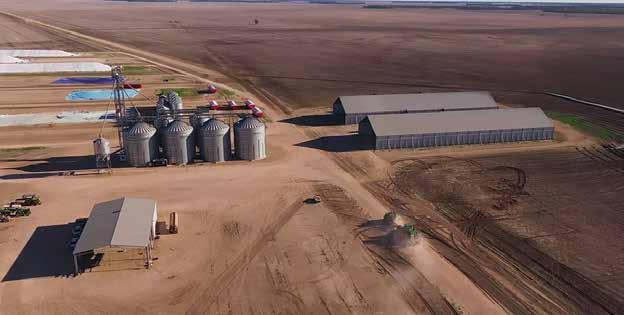

If you operate red or blue tractors, it’s likely you’ve used technology from PTx Trimble, formerly known as Trimble Agriculture.
If your machinery is equipped with these displays and receivers, even if it says Case IH or New Holland, it’s most likely PTx Trimble tech.


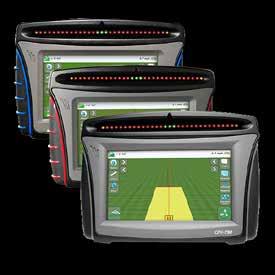
You can experience latest PTx Trimble displays and receivers means you can achieve

Switch to a new PTx Trimble GFX display. If you own an FM-750, FM-1000 or an XCN-1050 they have reached “end-of-life”, making replacements challenging if they fail. Make the change now to avoid critical downtime.

Boost your performance further by switching to the AG-392 receiver which offers faster convergence, less downtime and better performance
Limited time offer

Don’t miss out! When purchasing a GFX display & NAV-960 guidance controller, or an AG-392 receiversave up to 65%*
Ready to elevate your system to its full potential? Talk to your local PTx Trimble dealer today!


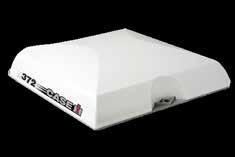

WHEN YOU’RE RUNNING ON UNDULATED AND DRY TERRAIN, YOU NEED THE RIGHT MACHINERY FOR YOUR FARM. AND THAT’S EXACTLY WHAT TIM DIXON HAS WITH HIS NEW FLEXI-COIL 7200, WHICH HAS JUST COMPLETED ITS FIRST SEEDING SEASON.
South Australian grower Tim Dixon has completed his first season with the new FlexiCoil 7200 Precision Hoe Drill. Operating in Nantawarra, Tim seeded his entire cropping program with the 80-foot unit and says the machine has transformed his seeding operation.
“It’s just totally different,” Tim said. “You could tell straight away it had been done properly and well. The germination was just so good with this one because the presser was straight on it. It looks ten times better than last year.”
Running 2,600 hectares of wheat, barley and lentils—about 850 hectares of each— Tim said the 7200 delivered consistent seed placement across his undulated terrain.
“We’ve got pretty hilly country here, but the 7200 goes dead straight,” he said.
“Seed placement was excellent, not too deep, not too shallow. It’s all down to the press wheel, and it went great. I’m super happy with how our crops have sown.”
The machine’s precision features have also helped streamline operations.
“It’s a big machine at 80-foot wide, and it’s been very efficient,” Tim said. “We had

Autosteer and Autoturn, Section Control, Curve Compensation and Auto Shut-off. We had no trouble with it at all—it all went fine.
“Next year we’re going to go variable rate, and that’s where the savings will really start showing.”
Delivered in May through Vater Machinery in Kadina, the Flexi-Coil 7200 was used across the entire seeding program. As the first 80-foot unit built, Tim said the dealership played a key role in getting the machine running smoothly.
“Vaters have been a big help getting it going for its first season,” he said.
Roger Vater, Dealer Principal at Vater

machinery said that they were pleased with the Flexi-Coil’s exceptional performance.
“The crop emergence has been outstanding, and the row spacing is on-point. We’re very happy with how this drill has performed, and even more thrilled to have exceeded Tim’s expectations,” Roger said.
Developed in collaboration between CNH’s Canadian engineering team and Australian product specialists, the Flexi-Coil 7200 introduces a new row unit design with strengthened pivots, improved bushings and a refined parallelogram system. The short opener-to-press wheel distance supports precise fertiliser placement and enhances weed management by reducing nutrient competition.
“Having the seed in the right spot with the chemicals we use nowadays — it’s just got to be right,” Tim said.
Tim runs a New Holland machinery fleet, including a CR9.90 header, T8.410 and T8030 tractors. “I’ve always been New Holland since 1990; have always stayed yellow and blue.”
Interest in the Flexi-Coil machine has been strong, with farmer groups already visiting Tim’s property to see the 7200 in action.
“I’ve had a lot of people coming to have a look. I’ve actually got a farmer group coming to have a look at it this week. I’ve already had another group come to look at it, so it’s creating a bit of interest,” Tim said.
With fungicide spraying about to begin and harvest preparations underway, Tim said the 7200 has helped set the season up for success.
For more information on the Flexi-Coil 7200, contact your local Flexi-Coil dealer or visit www.flexicoil.com.au.
THE TERRADISC HT 12000 IMPRESSES WITH ITS HIGH OUTPUT AND LOW RUNNING COSTS.
The new disc harrow from Pöttinger can be used for multiple applications: For stubble cultivation and seedbed preparation, in heavy, dry soil conditions, and with high volumes of harvest residues, it reliably ensures the best soil movement.
That is what makes it an important tool for conservation tillage. The trailed, horizontal folding disc harrow is designed for high-performance operation with tractors ranging from 450 to 720 horsepower. With a working width of 12.5 metres, it complements the proven Terradisc 8001 T and Terradisc 10001 T, which have working widths of eight and ten metres respectively.
The heart of the new model of disc harrow is also the proven and well-accepted Twin Arm system with two disc carriers and two concave discs per clamping bracket. Because the clamping brackets have 380 mm-wide contact with the frame, the discs hold their line even in heavy and dry soil conditions to ensure consistent results. The maintenance-free, non-stop stone protection enables the discs to achieve a high level of pre-tensioning.
The diameter and position of the discs also remain unchanged. The combination of 580 mm scalloped or plain concave discs set at an aggressive angle is ideal for intensive soil movement and shallow tillage from 5 cm.
for the best ground tracking
On the 12.5-metre-wide disc harrow, Pöttinger breaks new ground in tracking field contours. The width of the machine is divided into four frame sections. These adapt to any

unevenness independently of each other: the inside sections can move between -3° and +6°, while the outside sections can move between -4.5° and +4.5°. This means that the disc harrow can reliably track ground contours even in challenging terrain. To ensure each frame section applies a consistent pressure to the ground, the frame sections can be hydraulically pre-tensioned in pairs to match the soil conditions.
Together with the precise depth control provided by the large-dimensioned dual jockey wheels, the central transport chassis and the wide ground tracking using the rear roller with integrated damping, an even tillage depth is achieved across the full width of the machine.
double-acting spool valves for convenient operation
The wide selection of hydraulic adjustment options on the Terradisc HT 12000 makes it
particularly user-friendly. Four double-acting spool valves with intelligent presets regulate all the key functions and settings, such as working depth, headland position, pressure applied to the ground by the disc sections, and side pull correction. The working depth is set hydraulically using swing clips, which allow the working depth to be finely adjusted in 9 mm steps.
The rear roller supports the weight of the disc harrow at the headland to conserve the soil during a fast turning process. The length of the drawbar enables a large steering angle of up to 85°, making tight turning manoeuvres possible even when the machine is used with wide tractors.
With its matched tillage tools for reliable operation, excellent ground tracking and depth control, as well as convenient machine adjustments, the Terradisc HT 12000 is all set for success in soil cultivation and durability.

ADDING AN ALL-IN-ONE SOIL STRUCTURING MACHINE TO THEIR EQUIPMENT FLEET HAS SIGNIFICANTLY ENHANCED THE CLAY SPREADING SERVICES OFFERED BY SOUTHERN WA CONTRACTOR, HARRISS CONTRACTING, AND IS ALSO HELPING TO IMPROVE OTHER DIFFICULT SOILS THROUGHOUT THE REGION.
Run by Ben and Kate Harriss, the business has been spreading clay over farms from the Lower Great Southern to the south-eastern wheatbelt after also providing square hay baling previously, while its scrapers and graders can undertake land levelling, drainage and dam grading works as well.
Ben hails from the mother country and in 2000, like many before him, he came out to WA to drive a header. Now a quarter of a century later, he and Kate have established a successful contracting business, operate a beef cattle property at Narrikup and recently acquired cropping land at Newdegate to further spread their wings. They have two sons, Max and Henry, set to follow their footsteps in agriculture, with their eldest already putting his budding mechanical and fabrication skills to good use in the business.
They have used 18 cubic metre carry graders with GPS grade control and grader boards to accurately and cost-effectively spread clay at rates from 200-600 tonnes per hectare, allowing growers to incorporate it with their own equipment. However, recent investment in a Gregoire Besson ‘Discordon One-Pass Finisher’ has enabled the Harriss’ to now offer a complete, end-to-end clay spreading service to significantly improve soil incorporation for growers.
Purchased following an on-farm demonstration at Narrikup coordinated by local dealer, McIntosh and Son, together with Australian distributor, Waringa Distribution, the family’s 6-metre Gregoire Besson Discordon machine comprises two rows each of independent tines and both notched and smooth discs, plus a following 900-millemtre cage roller packer. The machines are also available with a flat profile, heavy Emopak roller that is ideal for self-seeding.
“We did some claying on a lease block at Narrikup and were looking at ways to incorporate it – our only option at home being an
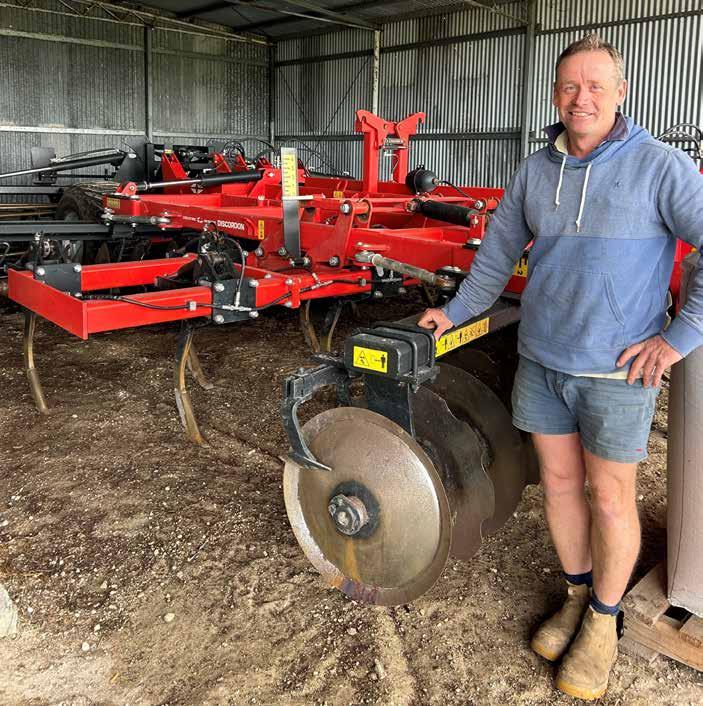
SOUTHERN WA CONTRACTOR AND FARMER BEN HARRISS WITH THE FAMILY’S GREGOIRE BESSON ‘DISCORDON ONE-PASS FINISHER’, WHICH HAS SIGNIFICANTLY IMPROVED THEIR CLAY SPREADING SERVICE AND ALSO BEEN EARMARKED FOR SOME WORK ON RECENTLY ACQUIRED CROPPING LAND AT NEWDEGATE.
old scarifier. I saw the machine at McIntosh (& Son) in Albany and asked for a demo. The guys brought it out and after seeing what it did in one pass, I knew it would be a great asset for our business and our customers,” Ben said.
In his younger years back in the UK, Ben operated a heavy Gregoire Besson offset disc with a cage roller, so he was well aware of the excellent build quality and performance of the machines.
He also spoke with another local contractor using a Gregoire Besson Discordon prior to the purchase and they said “it had been the only machine to hold together well” in the tough WA conditions.
Pulled by a 425kW (570hp) John Deere tracked tractor, the family’s machine has completed about 600ha so far and attracted a lot of positive feedback from grower clients. It has incorporated clay, worked heavy and light lands, and alleviated non-wetting soils by mixing top layers and, where suitable, bringing clay deeper in profiles to the surface.
“We’ve been using the straight point with the machine, but are keen to try the winged point option if we want to bring clay up,” Ben said.
He said it was important to incorporate spread clays thoroughly in the top 15-20 centimetres (6-8 inches) of soils and the Gregoire Besson Discordon did this most effectively.
“Some people spread clay and don’t see the results for a few years until their seeders have gone through the country a few times.”
“Offset discs or speed tillers are generally used for incorporation and customers have found three to four passes with a speed tiller are still not getting the clay down, whereas the tyne and disc combination on the Gregoire Besson does a great job of mixing to depth and preventing that surface capping.
“Offsets can also leave a fluffy finish, whereas the cage roller leaves a firmer seedbed and it’s all done in one pass.”
Ben said using the machine for clay incorporation also helped alleviate any compaction caused during the process
“If you are spreading 500t of clay, it’s a lot of machinery and a lot of weight going over the paddock, whether it’s a big spreader or a carry grader.”
“Fortunately, with the Gregoire Besson, you are mixing and getting rid of the compaction immediately afterwards.”
He said it was easy to adjust the depth of the hydraulic tynes and breakout pressures on-the-go, as well as the depth of the discs via altering the cage roller.
“In heavy country, we have used it like an offset disc, digging 200-250mm deep with the tynes and 150-200mm with the discs. In sands, it’s easy to independently drop the tynes to a depth of around 450mm.”


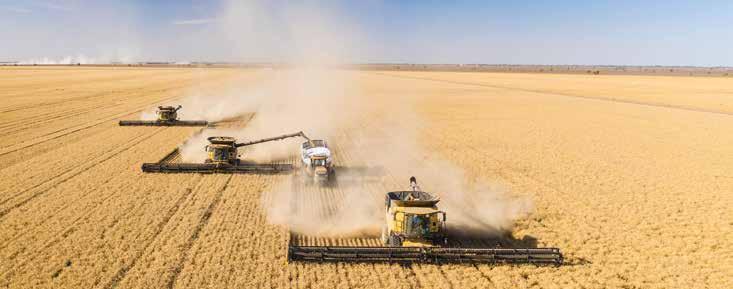




Priority
Guaranteed





Order
SHALLOW LIMESTONE IS A STRONG FEATURE OF THE COUNTRY ON SOUTH AUSTRALIA’S YORKE PENINSULA AND LIMITS FARMING POTENTIAL IN THE REGION, HOWEVER AN INCREASING NUMBER OF GROWERS HAVE FOUND A MACHINE TO RENOVATE THE LAND IN RECENT TIMES.
Southern YP farming brothers Hugh and George Murdoch have achieved lentil yield gains of nearly 70% in areas where their land has been worked well, as well as significant yield increases in wheat.
They are sixth generation farmers near Warooka and grow wheat, lentils and barley, although this season the 10% normally devoted to barley was replaced with canola for the first time.
The property features calcareous sandy patches, clay loams and significant areas of the shallow limestone.
“A lot of our paddocks have 10-20% of shallow sheeting limestone that didn’t produce a whole lot, including rocky outcrops which we were sowing around,” Hugh said.
He said the Rocks Gone Reefinator machine had been used by many farmers in the district and they had been kind enough to offer
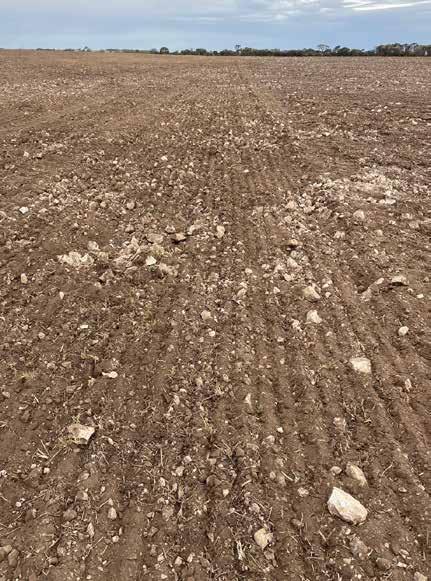
FRESHLY “REEFINATED” LAND SHOWING THE CRUSHED LIMESTONE ROCK ON THE MURDOCH’S WAROOKA FARM ON SOUTH AUSTRALIA’S YORKE PENINSULA.

THE ROCKS GONE H4 REEFINATOR ROCK CRUSHING MACHINE IN ACTION ON THE MURDOCH’S PROPERTY NEAR WAROOKA ON SOUTH AUSTRALIA’S YORKE PENINSULA, PULLED BY THE FAMILY’S 615HP NEW HOLLAND T9615 TRACTOR SET ON DUAL WHEELS.
advice and share their experiences, which guided the Murdoch’s decision to invest in their own machine.
The 3m wide H4 Reefinator comprises a levelling blade, four front row and five rear row hydraulic tines, and a following ribbed drum,
all weighing 28t when filled with water and digging up to 600mm deep. It works much like a cheese grater, removing manageable pieces of rock as multiple passes are completed.
“The machine is built to a very high

A FINISHED PADDOCK ON THE
CASE IH CELEBRATED THE GLOBAL LAUNCH OF THE NEW STEIGER 785 QUADTRAC AT THIS YEAR’S AGQUIP FIELD DAYS, AND HENTY MACHINERY FIELD DAYS WHERE VISITORS GOT THEIR CHANCE TO SEE THE BRAND’S MOST POWERFUL TRACTOR UP CLOSE – ALTHOUGH WITH ONE VERY NOTICEABLE DIFFERENCE.
Case IH brought a special-edition Steiger 785 Quadtrac to Henty, the tractor trading its Case IH red duco for the original Steiger green colour of the original, iconic Steiger range. The tractor was unveiled at the Farm Progress Show in the U.S. last month, where members of the Steiger family, including Douglass Steiger's daughter and granddaughter, were present to see the eye-catching tractor.
The Steiger story began in 1957 when brothers Douglass and Maurice Steiger built their own high-powered, four-wheel-drive tractor for their farm in Minnesota. Demand quickly grew, leading to full-scale production and establishing Steiger as a leader in power and durability.
Case IH purchased the brand in 1986, transforming Steiger’s signature green into Case IH red while continuing to advance its power and technology.
Completing the heritage loop for the Steiger at Henty will be an early 80s Steiger Bearcat, which belonged to a NSW farming family before it was traded in 2020 and later restored to its original Steiger-green glory.
standard and is able to handle the task at hand,” Hugh said.
“We believe reefinating is very worthwhile, as we have been able to achieve significant yield gains, improve our field efficiency and increase the value of our land.
“We have found that as our rock is bouldery and very hard, it doesn’t break-up into gravel. This has meant that as we have gained experience with the machine, our renovation process has evolved. We are now also rock picking all the areas we reefinate with a Elho Scorpio Rock Picker, which removes the stones that are larger than a golf ball. This is a time-consuming process, but, once complete, ensures the finished area is suitable for growing lentils.
“Our focus has been on un-arable areas which we previously had not cropped, but
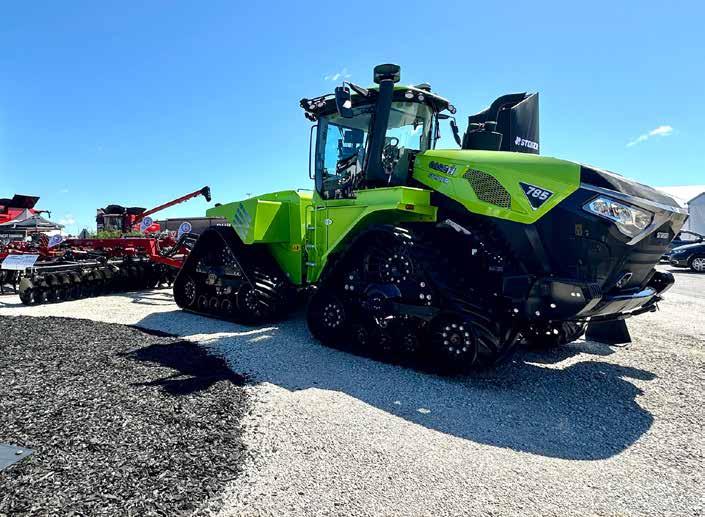
The new Steiger 785 Quadtrac delivers nearly 10% more horsepower than the Steiger 715 Quadtrac, enabling farmers to handle larger implements for greater productivity, or pull the same implements deeper to maximise yield potential. Designed for both strength and comfort, it combines superior traction and operator experience with integrated precision technology.
Farmers can access precision technology with Connectivity Included, delivering auto-
now these are complete. We are beginning to renovate shallow, yield limiting areas across the farm.”
The latest H4 Reefinator machines also offer automatic depth and slip control technology, which allows easier operation and helps relieve the demands on tractors.
Suitable for ISOBUS and GPS-integrated tractors, the automatic Rocks Gone Depth Master system calculates speed over ground and tractor load or wheel slip to adjust machine depth up to 50 times per second, as well as the level of its blade. In conjunction with GPS guidance systems, it also can produce depth maps of worked areas, helping to limit any extra passes to specific areas.
The Murdochs pull their H4 Reefinator at 6-9kph with a 615hp New Holland T9615 trac-
mation-driven features such as AccuTurn Pro and AccuSync, along with clear, actionable data through FieldOps— all designed to meet the unique needs of their operation.
“The Steiger has a proud legacy, and these two tractors—one from the 1980s and special-edition Steiger 785 Quadtrac — tell the story of how far we’ve come,” said Justin Bryant, Case IH ANZ High Horsepower Product Manager. “While the colour has changed, the Steiger’s purpose has not: delivering unmatched power, productivity and reliability for our customers.”
tor set on dual wheels.
“We’ve completed our fourth summer with the machine and done about 1800 hours,” Hugh said.
“Fortunately, we have only had to do minor repairs so far, but it is very hard on the tyres. So we are definitely interested in the automation technology – it sounds really good.
“Depending on how hard and dense the limestone is, we change a set of points every six to 30 hours. The leading edges last quite a while. Following Rocks Gone’s advice, we purchased a second set with the machine, which allows us to update the spare, hardfaced parts if necessary.”
He said the H4 Reefinator had proven to be a versatile machine, also completing work with its grader blade for levelling old fence lines on the family’s property.
THE FENDT 800 VARIO GEN5 SERIES IS A COMPLETELY NEWLY DEVELOPED SERIES OF TRACTORS AND COVERS A PERFORMANCE RANGE OF UP TO 343HP.
For the first time, the series will receive technologies such as DynamicPerformance added power concept, VarioDrive, the low-speed Fendt iD concept and the self-cleaning engine air filter. The new cab and innovative lighting concept increase work comfort throughout the working day.
The fifth generation of the 800 Vario, with three models (Fendt 826, 829 and Fendt 832 Vario), sits at the power range from 260 to 320hp (191 – 235kW). The Fendt DynamicPerformance (DP) added power concept provides an additional 23hp (17kW) when called upon by additional power requirements such as the cooling fan, oil pump or air-conditioning. Designed to meet the requirements of contractors and large agricultural farms worldwide, the focus of the new development was on a powerful and manoeuvrable package with a high payload, low fuel consumption and comfortable operations.
Manoeuvrable thanks to Fendt VarioDrive
The single-stage Fendt VarioDrive drivetrain with permanent, independent four-wheel drive was first introduced in 2014 with the Fendt 1000 Vario and is now available for the first time in the Fendt 800 Vario series. This enables maximum tractive power with high soil protection on different subsoils. In addition, there is no need for manual shifting when switching between field and road. VarioDrive drives the front and rear axles independently of each other and distributes the power dynamically. Another advantage is the so-called pull-in turn effect. Thanks to the pull-in turn, the independently driven front axle actively pulls the machine into the turn without torsion and the
Fendt 800 Vario achieves a particularly small turning circle.
Fendt iD low speed concept saves fuel
All tractor components such as engine, transmission, hydraulics and cooling were now designed for the so-called “high torque – low engine speed” principle. The Fendt iD low-speed concept allows the Fendt 800 Vario to achieve high torque and saves fuel at low engine speeds. The rated engine speed is only 1,700rpm. In the main working range, the speed is a quiet 1,100 to 1,400rpm. The speed of 40km/h is reached at 950rpm, 50km/h at 1,200rpm, and the top speed of 60km/h at 1,450rpm. The maximum torque of 1,680Nm is available on the top model Fendt 832 Vario from 1,200rpm and ensures high tractive power and acceleration with minimal specific fuel consumption.
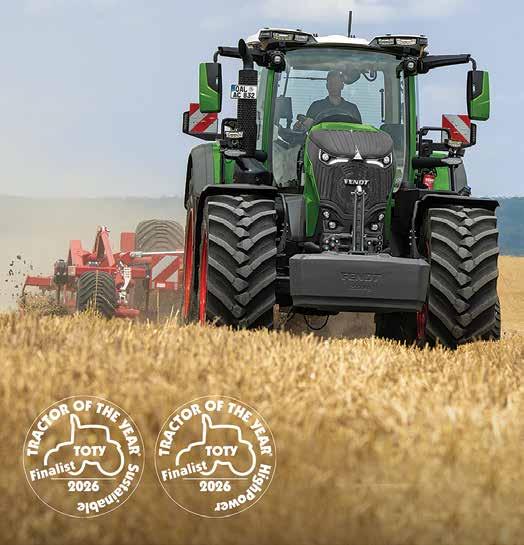
High payload for teams
The payload of a tractor decides which implement combinations are possible with the tractor. The low operating weight of 9.9 t with a permissible overall weight of up to 17.5 t with an approval for 40 and 50km/h results in a payload of 7.6 t. This enables legal work in the team with a precision seed drill with a front tank or the legal transport of a front-rear mower combination. In addition, there are flexible options for ballasting at the front and on the rear wheels so that the machine runs optimally in field or road use.
Brings light into the darkness with up to 114,700 lumens
The tractor cab is central to driving comfort: the seat,
Model Max. Power Maximum power with DP according to ECE R120
Fendt 826 Vario
Fendt 829 Vario
(191kW)
(213kW)
air-conditioning, lighting and viewing angles influence the working comfort and the result of the work. With the Fendt 800 Vario series, Fendt is presenting the new tractor cab with exclusively developed lighting concept for the first time. Work such as sowing, harvesting, pesticides or winter service are highly dependent on the weather. For example, if the work lasts until night due to a threatening weather swing, the tractor’s lighting can decide whether the work can continue.
The view to the front as well as the view of the implement and the processed areas are central to continuously monitor the work results. The LED spotlights are available in two equipment variants: Vision and UltraVision.
Torque (Nm)
(208kW)
(230kW) 1,550
Fendt 832 Vario 320hp (235kW) 343hp (252kW) 1,680

In both variants, eight or 12 spotlights can be installed in the cab roof. In the UltraVision variant, the tractor illuminates the area with 4,400 lumens per spotlight and the spotlights are dimmable in 5 stages. This function is especially useful when several machines are working on one area. The Vision equipment option offers 1,000 lumens per spotlight. All spotlights, including the rotating beacon, are firmly installed in the cab roof and placed in agricultural use for optimum illumination and glarefree working. This increases comfort and safety.
Up to four individual profiles can be stored for convenient and quick operation of the work lights. For example, if the tractor is driving to the left of the field chopper, the driver can dim the light on the side of the chopper, while brightly illuminating the rest of the environment so as not to glare the chopper. The configuration can also be mirrored with one click. This function is helpful when the chopper driver is driving along side the forage harvester. Also new is the independent control of the individual spotlights. If the weather changes due to fog or rain, the light intensity can be adjusted quickly.
The machine can be equipped with Tech Rails on the C-pillar for the installation of supplementary work lights or sensors in the future. The Tech Rails, including their own cable entry, provide

space for up to two work lights per side. This means that the machines are prepared for future requirements.
The new, optional Fendt GroundVision drawbar lighting illuminates the area directly at the rear of the machine. On the one hand, the area directly in front of the implement and in front of it is illuminated in field use, and on the other hand, it simplifies the coupling and uncoupling of implements in the dark. The lights are integrated at the lower end of the rear fenders.
filtration
As standard, the Fendt 800 Vario is now also equipped with the exclusive Concentric Air System (CAS) ventilation & cooling concept. The fan can be optionally equipped with a reverse function. In addition, a self-cleaning air filter including automatic control is optionally available for the CORE80 engine. If the engine air
filter is cleaned automatically, drivers can carry out their field work without interruption, and regular cleaning increases the longevity of the machine and ensures optimum fuel consumption. This DLG awarded system is already known from the Fendt 1000 Vario. Now this option is always offered together with the automatic dust extraction for the cab air filter. In this system, the cab air filter is continuously and automatically passively cleaned by vacuum and a cyclone separator. This function has been specially developed for use in hot or particularly dusty conditions, such as cultivators in dry weather. It reduces daily maintenance and increases the air quality in the cab.
Long working days place high demands on the driver, which is why the tractor cab offers numerous equipment options for greater working comfort. All equip-

ment lines have the FendtONE workstation with armrest and up to three display areas (Profi and Profi+). Optional footrests are even added on the steering tower and the side console for relaxed leg position.
If the Fendt 800 Vario is used in winter service, the optional, heated laminated safety glass (LSG) front window makes visibility easier. The front window heating accelerates the defrosting, prevents renewed ice formation and fogging in case of snowfall. Thanks to its special composite process, it can better withstand contact with foreign matter. The glass with integrated splinter protection remains intact in the event of damage, so the driver is protected against injuries. In addition, the laminated glass front window dampens noise particularly well.
If the Fendt 800 Vario is used with an implement in the rear, such as a wood chipper or forestry mulcher, all control elements can be rotated by 180 degrees thanks to the optional reverse drive control. The reverse drive control thus allows a direct view of work implements. In addition to the 4-speed PTO, there is a separate PTO with 540/900/1000 rpm speeds, for example, for use with a wood chipper, to make optimum use of the motor’s speed range.
The new, electrically adjustable “Super Comfort Seat Titanium Leather” has numerous options for high seating comfort. The driver adjusts the seat height and position as well as the backrest angle electrically via a lever on the side of the seat. When changing out drivers, they can create personalised seat profiles and call up these user profiles in the FendtONE onboard. Even when used at high outside

temperatures, the performance of the air-conditioning system as standard, provides automatic comfortable temperatures in the cab. There is also a new compressor cooler with a volume of 12 litres. Drinks and food can be cooled (0-16°C). For high air quality in dusty operating conditions, the optional automatic dust extraction provides for the cab air filter.
Another new feature is the integration of Apple CarPlay into the Fendt infotainment via cable or Bluetooth. Already known from the automotive sector, operation is carried out via the terminal on the armrest. The software will be rolled out in June 2026.
High hydraulic power for use with complex implements
Complex implements such as precision seed drills with integrated fertiliser tanks and high separation rates place high demands on the hydraulic system of a tractor. The Fendt 800 Vario now has a maximum of six hydraulic control units in the rear and two in the front (6+2). A maximum of 4 control units in the Power+ equipment line are available in the rear and one in the front (4+1) or five control units in the rear (5+0). Customers can also choose between three hydraulic pumps: 165 l/ min, 220 l/min and for consumers with varying requirements
in terms of oil quantity and pressure, a double pump system with a maximum flow capacity of 385 l/min (165 + 220 l/min) is available. If the implement transfers a particularly high amount of heat into the hydraulic system or if the tractor is used in hot regions, an optional additional hydraulic oil cooler improves the hydraulic oil cooling capacity. In the rear, the optional FFC flat-sealing couplings for control units and the Power Beyond connection prevent the dirt ingress into the system as well as leakage oil and reduce pressure losses. The relieving rear power lift transfers weight from the implement to the tractor for optimum ground
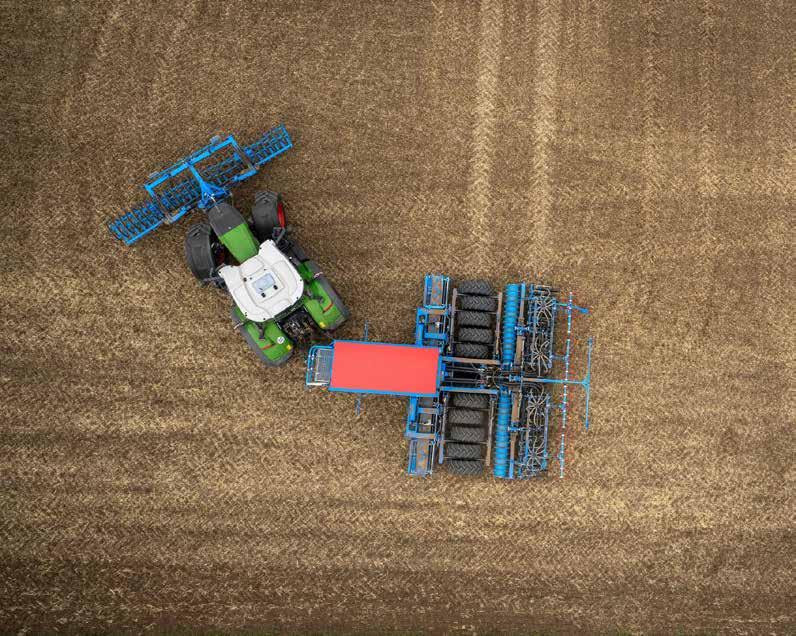
hugging, for example when working with milling machines or mulchers. The lift assist for the top link takes over part of the weight from the top link and supports the work ergonomics when mounting implements.
Transportation talent at up to 60km/h
The Fendt 800 Vario achieves a high overall productivity thanks to its versatility. Features such as VarioDrive, top speed of up to 60km/h, the high payload, the comprehensive chassis and safety concept, the optional exhaust brake in conjunction with the hydraulic auxiliary brake, the self-centering Fendt Reaction Steering, Fendt Stability Control (FSC) or the Trailer Brake Assistant (TBA) characterise the series in transport. The trailer brake assistant displays its advantages, for example, in the team with an attached sprayer or a pneumatically braked trailer in the chopping chain. Then this keeps the team in line even in curves on the slope and prevents it from jack-knifing or drifting. The optional automatic parking brake and numerous axle and tyre options round out the package.
In the cab, drivers can make numerous adjustments individually and directly via the terminal. This includes the setting of the seat, mirrors and lights, but also the control of radio and telephone. This supports driving comfort during long transport operations.
For more information on the new Fendt 800 G5 Series, visit fend.com.au or contact your local dealer.





